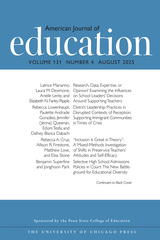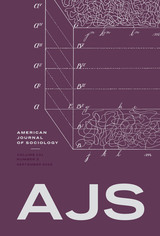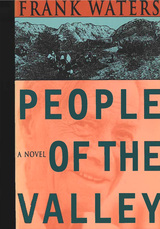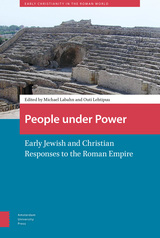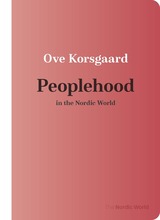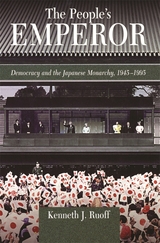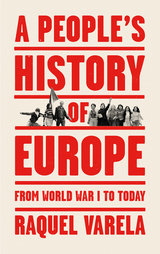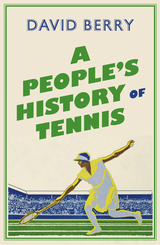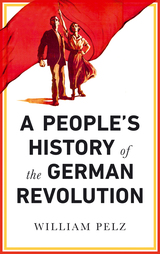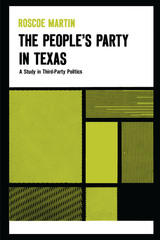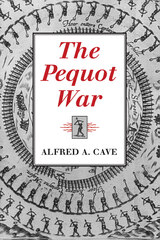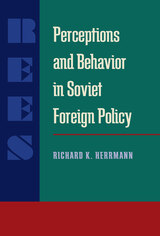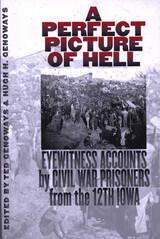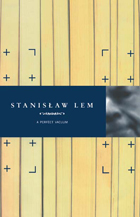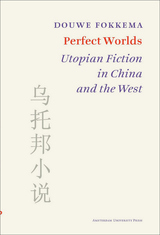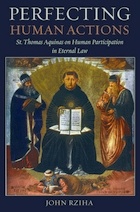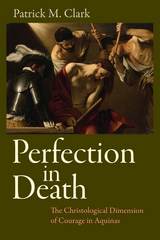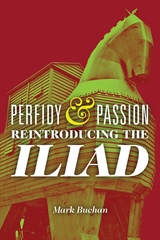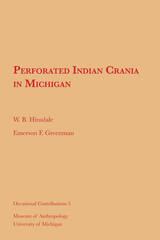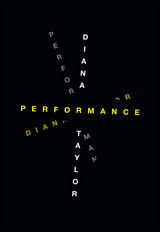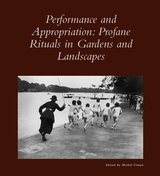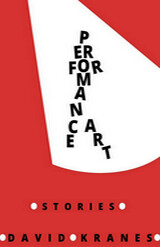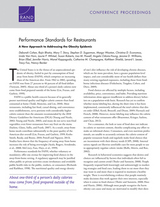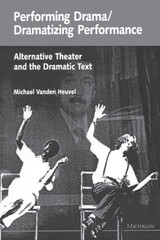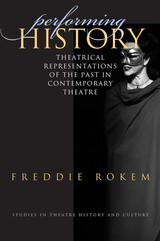People of the Desert and Sea: Ethnobotany of the Seri Indians
Richard Stephen Felger, Mary Beck Moser
University of Arizona Press, 1985 "People of the Desert and Sea is one of those books that should not have to wait a generation or two to be considered a classic. A feast for the eye as well as the mind, this ethnobotany of the Seri Indians of Sonora represents the most detailed exploration of plant use by a hunting-and-gathering people to date. . . . Scholarship in the best sense of the term—precise without being pedantic, exhaustive without exhausting its readers."—Journal of Arizona History
"To read and gaze through this elegantly illustrated book is to be exposed, as if through a work of science fiction, to an astonishing and unknown cultural world."—North Dakota Quarterly
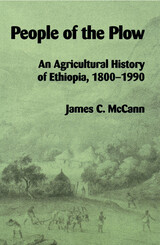 People of the Plow: An Agricultural History of Ethiopia, 1800–1990
James C. McCann
University of Wisconsin Press, 1995 For more than two thousand years, Ethiopia’s ox-plow agricultural system was the most efficient and innovative in Africa, but has been afflicted in the recent past by a series of crises: famine, declining productivity, and losses in biodiversity. James C. McCann analyzes the last two hundred years of agricultural history in Ethiopia to determine whether the ox-plow agricultural system has adapted to population growth, new crops, and the challenges of a modern political economy based in urban centers.
This agricultural history is set in the context of the larger environmental and landscape history of Ethiopia, showing how farmers have integrated crops, tools, and labor with natural cycles of rainfall and soil fertility, as well as with the social vagaries of changing political systems. McCann traces characteristic features of Ethiopian farming, such as the single-tine scratch plow, which has retained a remarkably consistent design over two millennia, and a crop repertoire that is among the most genetically diverse in the world.
People of the Plow provides detailed documentation of Ethiopian agricultural practices since the early nineteenth century by examining travel narratives, early agricultural surveys, photographs and engravings, modern farming systems research, and the testimony of farmers themselves, collected during McCann’s five years of fieldwork. He then traces the ways those practices have evolved in the twentieth century in response to population growth, urban markets, and the presence of new technologies.
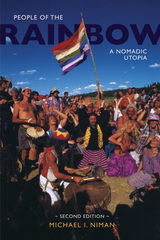 People of the Rainbow: A Nomadic Utopia
Michael I. Niman
University of Tennessee Press, 1997
Since 1972 the Rainbow Family of Living Light, a loosely organized and anarchistic nomadic community, has been holding large gatherings in remote forests to pray for world peace and create a model of a functioning utopian society. Michael I. Niman’s People of the Rainbow, originally published in 1997, was the first comprehensive study of this countercultural group and its eclectic philosophy of environmentalism, feminism, peace activism, group sharing, libertarianism, and consensus government. It is a book yet to be superseded.
This second edition of Niman’s compelling and insightful work brings the Rainbow story up to date with a new introduction and two extensive new epilogues. While the big annual Rainbow “Gatherings” have drawn fewer numbers in recent years, Niman notes, the Rainbow ethos has in many ways migrated to the mainstream, as Rainbow notions about alternative medicine and environmental sustainability, for example, have gathered wider acceptance and influenced the national dialogue. Meanwhile, Rainbow movements in other regions, from Eastern Europe and the Middle East to Asia and Australia, are thriving.
In addition to addressing changes within the Rainbow Family and its complex relationship to “Babylon” (what Rainbows call mainstream culture), the book’s new material explores the growing harassment Rainbows now face from U.S. law enforcement agencies—especially those associated with the National Forest Service. As Niman contends, this particular saga of a U.S. bureaucracy at war with its own citizens is a subplot in the larger—and disturbing—story of how the relationship between Americans and their government has changed during the first decade of the twenty-first century.
In its nuanced portrait of an intriguing subculture, its successes, and its limitations, People of the Rainbow remains a significant contribution to the study of utopian communities in the United States and their ongoing legacy.
Michael I. Niman is a professor of journalism and media studies in the Communication Department at Buffalo State College in New York.
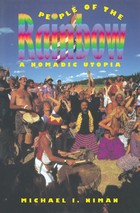 People Of The Rainbow: Nomadic Utopia
Michael I. Niman
University of Tennessee Press, 1997 Since 1972, the Rainbow Family of Living Light, a loosely organized and anarchistic nomadic community, have been holding large gatherings in remote forests to pray for world peace and create a model of a functioning utopian society. In People of the Rainbow, Michael I. Niman offers the first comprehensive study of this countercultural group, also known as the Rainbow Nation or Rainbow Family. Niman's insightful and compelling profile describes the origins and recent history of the Rainbows and explains the eclectic philosophy of environmentalism, feminism, peace activism, group sharing, libertarianism, and consensus government they espouse.
A fictional re-creation of a day in the life of a Rainbow character named Sunflower begins the book, illustrating events that might typically occur at an annual North American Rainbow Gathering. Using interviews with Rainbows, content analysis of media reports, participant observation, and scrutiny of government documents relating to the group, Niman presents a complex picture of the Family and its relationship to mainstream culture—called "Babylon" by the Rainbows. Niman also looks at internal contradictions within the Family and examines members' problematic relationship with Native Americans, whose culture and spiritual beliefs they have appropriated.
The nomadic nature of the Rainbow Family has long exasperated the U.S. government--especially the Forest Service--and has baffled the media. Niman places the Rainbow Family's gatherings in a historical context by framing the group's activities in terms of the long tradition of intentional communities and utopian experimentation within the United States. Concluding with reflections on the successes and limitations of the Rainbow movement, People of the Rainbow provides an extensive ethnography of this intriguing subculture and provides fresh insights into the ongoing legacy of utopian communalism.
The Author: Michael I. Niman is an adjunct assistant professor of American studies at the State University of New York at Buffalo and a lecturer in the communication department at Buffalo State College.
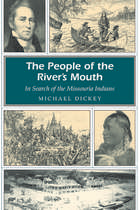 The People of the River's Mouth: In Search of the Missouria Indians
Michael E. Dickey
University of Missouri Press, 2011 The Missouria people were the first American Indians encountered by European explorers venturing up the Pekitanoui River—the waterway we know as the Missouri. This Indian nation called itself the Nyut^achi, which translates to “People of the River Mouth,” and had been a dominant force in the Louisiana Territory of the pre-colonial era. When first described by the Europeans in 1673, they numbered in the thousands. But by 1804, when William Clark referred to them as “once the most powerful nation on the Missouri River,” fewer than 400 Missouria remained. The state and Missouri River are namesakes of these historic Indians, but little of the tribe’s history is known today. Michael Dickey tells the story of these indigenous Americans in The People of the River’s Mouth. From rare printed sources, scattered documents, and oral tradition, Dickey has gathered the most information about the Missouria and their interactions with French, Spanish, and early American settlers that has ever been published. The People of the River’s Mouth recalls their many contributions to history, such as assisting in the construction of Fort Orleans in the 1720s and the trading post of St. Louis in 1764. Many European explorers and travelers documented their interactions with the Missouria, and these accounts offer insight into the everyday lives of this Indian people. Dickey examines the Missouria’s unique cultural traditions through archaeological remnants and archival resources, investigating the forces that diminished the Missouria and led to their eventual removal to Oklahoma. Today, no full-blood Missouria Indians remain, but some members of the Otoe-Missouria community of Red Rock, Oklahoma, continue to identify their lineage as Missouria. The willingness of members of the Otoe-Missouria tribe to share their knowledge contributed to this book and allowed the origin and evolution of the Missouria tribe to be analyzed in depth.
Accessible to general readers, this book recovers the lost history of an important people. The People of the River’s Mouth sheds light on an overlooked aspect of Missouri’s past and pieces together the history of these influential Native Americans in an engaging, readable volume.
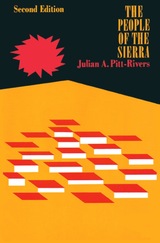 The People of the Sierra
Julian Pitt-Rivers
University of Chicago Press, 1972 The People of the Sierra presents an engrossing account of the social structure of a rural community in Andalusia, the mountainous region of southern Spain. The author applies the principles of social anthropology, without recourse to jargon, to determine the nature of the leaders of a European peasant society—the mayor, doctor, lawyer, priest—and also the smugglers, bandits, "witches," and gypsies who live on the fringe.
For his second edition of The People of the Sierra Julian A. Pitt-River has unmasked the village of Grazalema which had been protectively cloaked in pseudonym for the original version. In addition he has added a new preface which elaborates upon his earlier theories on norms, values, and social structure, and reconsiders them in the light of current theories of other social scientists.
Because of its unique and penetrating observations, not only Hispanic, Mediterranean, and European but also Latin American scholars regard this book as one of the foundation stones of contemporary cultural studies in several disciplines. Beyond the significance of its substance and theory, this study has considerable merit as a humane work of subtle perception and artful execution.
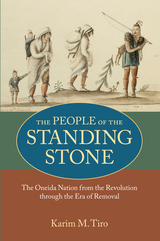 The People of the Standing Stone: The Oneida Nation from the Revolution through the Era of Removal
Karim M. Tiro
University of Massachusetts Press, 2011 Between 1765 and 1845, the Oneida Indian Nation weathered a trio of traumas: war, dispossession, and division. During the American War of Independence, the Oneidas became the revolutionaries' most important Indian allies. They undertook a difficult balancing act, helping the patriots while trying to avoid harming their Iroquois brethren. Despite the Oneidas' wartime service, they were dispossessed of nearly all their lands through treaties with the state of New York. In eighty years the Oneidas had gone from being an autonomous, powerful people in their ancestral homeland to being residents of disparate, politically exclusive reservation communities separated by up to nine hundred miles and completely surrounded by non-Indians.
The Oneidas' physical, political, and emotional division persists to this day. Even for those who stayed put, their world changed more in cultural, ecological, and demographic terms than at any time before or since. Oneidas of the post-Revolutionary decades were reluctant pioneers, undertaking more of the adaptations to colonized life than any other generation. Amid such wrenching change, maintaining continuity was itself a creative challenge. The story of that extraordinary endurance lies at the heart of this book.
 People of the Sturgeon: Wisconsin's Love Affair with an Ancient Fish
Kathleen Schmitt Kline
Wisconsin Historical Society Press, 2012 People of the Sturgeon tells the poignant story of an ancient fish. Wanton harvest and habitat loss took a heavy toll on these prehistoric creatures until they teetered on the brink of extinction. But, in Wisconsin, lake sturgeon have flourished because of the dedicated work of Department of Natural Resources staff, university researchers and a determined group of spearers known as Sturgeon For Tomorrow. Thanks to these efforts, spearers can still flock by the thousands to frozen Lake Winnebago each winter to take part in a ritual rooted in the traditions of the Menominee and other Wisconsin Indians. A century of sturgeon management on Lake Winnebago has produced the world's largest and healthiest lake sturgeon population. Through a fascinating collection of images, stories and interviews, People of the Sturgeon chronicles the history of this remarkable fish and the cultural traditions it has spawned. The authors introduce a colorful cast of characters with a good fish tale to tell. Color photos by the late Bob Rashid and images from the Wisconsin Historical Society evoke both the magical and the mortal. Weaving together myriad voices and examining the sturgeon's profound cultural impact, the authors reveal how a diverse group of people are now joined together as "people of the sturgeon."
 People of the Sturgeon: Wisconsin's Love Affair with an Ancient Fish
Kathleen Schmitt Kline
Wisconsin Historical Society Press, 2012 People of the Sturgeon tells the poignant story of an ancient fish. Wanton harvest and habitat loss took a heavy toll on these prehistoric creatures until they teetered on the brink of extinction. But, in Wisconsin, lake sturgeon have flourished because of the dedicated work of Department of Natural Resources staff, university researchers and a determined group of spearers known as Sturgeon For Tomorrow. Thanks to these efforts, spearers can still flock by the thousands to frozen Lake Winnebago each winter to take part in a ritual rooted in the traditions of the Menominee and other Wisconsin Indians. A century of sturgeon management on Lake Winnebago has produced the world's largest and healthiest lake sturgeon population. Through a fascinating collection of images, stories and interviews, People of the Sturgeon chronicles the history of this remarkable fish and the cultural traditions it has spawned. The authors introduce a colorful cast of characters with a good fish tale to tell. Color photos by the late Bob Rashid and images from the Wisconsin Historical Society evoke both the magical and the mortal. Weaving together myriad voices and examining the sturgeon's profound cultural impact, the authors reveal how a diverse group of people are now joined together as "people of the sturgeon."
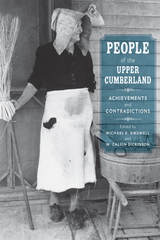 People of the Upper Cumberland: Achievements and Contradictions
Michael E. Birdwell
University of Tennessee Press, 2015 Unified by geography and themes of tradition and progress, the essays in this anthology present a complex view of the Upper Cumberland area of Tennessee and Kentucky—a remote and, in some ways, mysterious region—and its people. The distinguished contributors cover everything from early folk medicine practices (Opless Walker), to the changing roles of women in the Upper Cumberland (Ann Toplovich), to rarely discussed African American lifeways in the area (Wali R. Kharif). The result is an astonishingly fresh contribution to studies of the Upper Cumberland area.
Randall D. Williams’s essay on the relatively unknown history of American Indians in the region opens the collection, followed by Michael Allen’s history of boating and river professions on the Cumberland River. Al Cross and David Cross illuminate the Republican politics of the Kentucky section of the Upper Cumberland, while Mark Dudney provides a first-of-its-kind look at the early careers of distinguished Tennesseans Cordell Hull and John Gore. Equally fresh is Mary A. Evins’s examination of the career of Congressman Joe L. Evins, and coeditor Michael E. Birdwell and John B. Nisbet III contribute an in-depth piece on John Catron, the Upper Cumberland’s first Supreme Court justice. Troy D. Smith’s essay on Champ Ferguson sheds new light on the Confederate guerilla. Birdwell’s second contribution, an exploration of the history of moonshine, provides insight into a venerable Cumberland tradition. Pairing well with Walker’s essay, Janey Dudney and coeditor W. Calvin Dickinson discuss the superstitions faced by early Upper Cumberland medical professionals. Closing out the grouping of medical articles is Dickinson’s second chapter, which tells the story of Dr. May Cravath Wharton and her contribution to the region’s health care. Laura Clemons explores the relationship between composer Charles Faulkner Bryan and his gifted African American pupil J. Robert Bradley during the Jim Crow era. Birdwell’s third chapter and the collection’s final essay examines race relations in the Upper Cumberland.
Offering a broad look at one of the most understudied regions of the Volunteer State, this significant addition to Tennessee history will prove insightful for students and academics with interdisciplinary and cross-historical interests.
Michael E. Birdwell is a professor of history at Tennessee Technological University and the author of several books, including Celluloid Soldiers: Warner Bros.’s Campaign against Nazism and Rural Life and Culture of the Upper Cumberland.
W. Calvin Dickinson is a professor emeritus of history at Tennessee Technological University. He is the author and editor of several books, including Sister States, Enemy States: The Civil War in Kentucky and Tennessee and Tennessee: State of the Nation, now in its second edition.
People Of The Valley: A Novel
Frank Waters
Ohio University Press, 1941 One of Frank Waters’s most popular novels, People of the Valley takes place high in the Sangre de Cristo Mountains where an isolated Spanish-speaking people confront a threatening world of change.
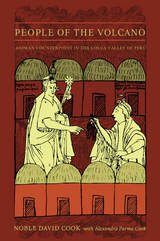 People of the Volcano: Andean Counterpoint in the Colca Valley of Peru
Noble David Cook, with Alexandra Parma Cook
Duke University Press, 2007 While it now attracts many tourists, the Colca Valley of Peru’s southern Andes was largely isolated from the outside world until the 1970s, when a passable road was built linking the valley—and its colonial churches, terraced hillsides, and deep canyon—to the city of Arequipa and its airport, eight hours away. Noble David Cook and his co-researcher Alexandra Parma Cook have been studying the Colca Valley since 1974, and this detailed ethnohistory reflects their decades-long engagement with the valley, its history, and its people. Drawing on unusually rich surviving documentary evidence, they explore the cultural transformations experienced by the first three generations of Indians and Europeans in the region following the Spanish conquest of the Incas. Social structures, the domestic export and economies, and spiritual spheres within native Andean communities are key elements of analysis. Also highlighted is the persistence of duality in the Andean world: perceived dichotomies such as those between the coast and the highlands, Europeans and Indo-Peruvians. Even before the conquest, the Cabana and Collagua communities sharing the Colca Valley were divided according to kinship and location. The Incas, and then the Spanish, capitalized on these divisions, incorporating them into their state structure in order to administer the area more effectively, but Colca Valley peoples resisted total assimilation into either. Colca Valley communities have shown a remarkable tenacity in retaining their social, economic, and cultural practices while accommodating various assimilationist efforts over the centuries. Today’s population maintains similarities with their ancestors of more than five hundred years ago—in language, agricultural practices, daily rituals, familial relationships, and practices of reciprocity. They also retain links to ecological phenomena, including the volcanoes from which they believe they emerged and continue to venerate.
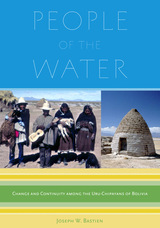 People of the Water: Change and Continuity among the Uru-Chipayans of Bolivia
Joseph Bastien
University of Utah Press, 2012 People of the Water is an ethnographic analysis of the cultural practices of the Uru-Chipayans—how they have maintained their culture and how they have changed. The Chipayans are an Andean people whose culture predates the time of the Incas (c. AD 1400), but they were almost wiped out by 1940, when only around 400 remained. Yet their population has quadrupled in the last 60 years. Joseph Bastien has spent decades living with and studying the Chipayans, and here for the first time he discusses the dynamics between traditional, social, and religious practices and the impending forces of modernity upon them. With the support of more than 100 illustrations he documents how, in spite of challenges, the Chipayans maintain ecological sustainability through an ecosystem approach that is holistic and symbolically embedded in rituals and customs. Chipayans have a resilient and innovative culture, maintaining dress, language, hairstyle, rituals, and behavior while also re-creating their culture from a dialectic between themselves and the world around them. Bastien provides the reader with a series of experienced observations and intimate details of a group of people who strive to maintain their ancient traditions while adapting to modern society. This ethnographic study offers insightful, surprising, and thoughtful conclusions applicable to interpreting the world around us.
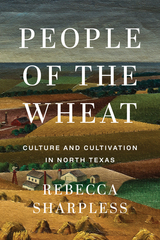 People of the Wheat: Culture and Cultivation in North Texas
Rebecca Sharpless
University of Texas Press, 2026 How wheat growing, milling, and baking shaped the people and culture of North Texas. In the national imaginary, America’s amber fields of grain lie in the country’s center, but for more than a century, they also grew across one pocket of the South: North Texas. From the 1840s to the 1970s, the state's agriculture, dominated in lore by cotton in the east and livestock in the open range, was heavily invested in the cultivation, processing, sale, and consumption of wheat. Recalling a forgotten history, Rebecca Sharpless shows how the rhythms of the wheat harvest—and the evolution of the milling, distribution, and baking industries—governed daily life in what is now known as the Dallas–Fort Worth Metroplex. In the 1840s, Anglo settlers discovered that grain flourished in North Texas and quickly built an economy that included wheat in fields, mills, and kitchens. After the Civil War, hand labor gave way to mechanization, greatly increasing production. Commercial bakeries churned out novel confections, and big cities were built on the bounty of the countryside. In the second half of the twentieth century, as production moved northward, industrial milling and baking declined, but home baking boomed, flour advertising supported regional music, and wheat fortunes financed the region’s cultural life. Sharpless covers 150 years of wheat’s very human history and shows how the labor that cultivated it, the sustenance it provided, and the prosperity it generated left an indelible mark on the people and institutions of Texas.
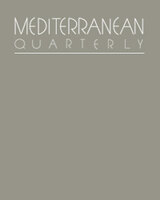 People on the Move: The Security, Social, and Economic Implications of Mass Migration, Volume 15
Nikolas A. Stavrou, ed.
Duke University Press On an annual basis, approximately 100 million people either attempt to or actually do leave their place of birth, often not knowing their final destination. The flow of immigrants who arrive in neighboring countries in search of refuge and work raises social, political, and security concerns. This special issue of Mediterranean Quarterly takes a closer look at a pattern of history that is at the core of current global instability—the mass migration of peoples. This collection gathers a unique group of contributors, including representatives from Congress, the United Nations, and Israel’s Ministry of Justice, as well as senior diplomats from Canada, Bulgaria, Portugal, Spain, and Turkey. Presenting their diverse perspectives, the contributors address regional and policy issues related to the mass migration of people, as well as questions concerning citizenship and national security, human trafficking in the form of prostitution, and cultural discrimination. The result is a multifaceted exploration of issues underlying many of the world’s economic, security, and social challenges. Other topics include the impact of state failure on migration, immigration in California, security measures and “preferred” immigrants in Canada after September 11, 2001, and Albanian migration into Greece. Contributors. Alexandre Afonso, David Binder, Andrew C. Danopoulos, Constantine P. Danopoulos, Francis M. Deng, Mohamed A. El-Khawas, Omar G. Encarnación, Rochelle Gershuni, Larry L. Gerston, Ahmet Içduygu, Benjamin Kline, Bojan Korenic, Erin Kruger, Robert S. Leiken, Marlene Mulder, Elena Poptodorova, Tom Tancredo
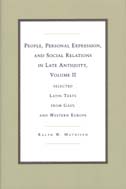 People, Personal Expression, and Social Relations in Late Antiquity, Volume II: Selected Latin Texts from Gaul and Western Europe
Ralph W. Mathisen
University of Michigan Press, 2003 Late Antiquity, which lies between Classical Antiquity and the Middle Ages (ca. A.D. 250-750), heralded the gradual decline of Mediterranean classical civilization, and the initial formation of a strictly western European, Christian society. During this period, three momentous developments threatened the paternalistic Roman social system: the rise of the Christian church, the disintegration of the Roman Empire in the west, and the establishment of the barbarian kingdoms. The first of its type, this volume presents a collection of Latin source documents illustrating the social upheaval taking place in the Late Roman and early medieval worlds. The texts included in this volume provide the original Latin for the selections that are translated in People, Personal Expression, and Social Relations in Late Antiquity, Volume I. The 140 selected texts gathered from 70 different sources offer the reader firsthand experience with the ways that the Latin language was being used during the transformative period of Late Antiquity. Ralph W. Mathisen is Professor of Ancient and Byzantine History; Louise Fry Scudder Professor of Humanities; and Director, Biographical Database for Late Antiquity at the University of South Carolina.
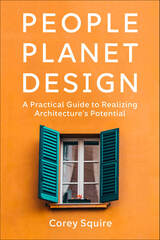 People, Planet, Design: A Practical Guide to Realizing Architecture’s Potential
Corey Squire
Island Press, 2023 If you were asked to close your eyes and envision where you are happiest, would you picture somewhere inside a building? North Americans are inside buildings for more than 90% of the day. Meanwhile, the indoors are stifling us, sometimes even killing us. Buildings, and the materials that make them up, expose us to materials linked to negative health impacts. The construction and operation of buildings is responsible for 40% of climate-changing carbon emissions.
In the US, the design choices made by the typical architecture firm employee each year can reduce emissions by about 300 times that of an average American. But the promise of sustainable architecture will not be realized if sustainability remains a secondary consideration for architects. What if great design were defined by its ability to cool the planet, heal communities, enhance ecological functioning, and advance justice?
In People, Planet, Design, architect Corey Squire builds the case, provides the data, and lays out the practical tools for a transformative human-centered architecture. This approach integrates beauty and delight with an awareness of how every design choice impacts the community, the planet, and the people who will use the building. Outcome-focused with a deep dive into practical design strategies, the book showcases ten building systems that embody design excellence.
Squire centers the idea that by focusing on the desired outcomes—that buildings shelter us from the elements without disconnecting us from the world, that buildings provide the quality of air, light, and views we now know to be essential to health, productivity, and joy—we can move beyond the checklist mentality that has captured much of the design community.
Essential reading for architects who want to transform what the profession means, People, Planet, Design pioneers a new vision and sets readers up with clear guidance on implementing it. Only when design prioritizes people, as it should, can architecture realize its full potential.
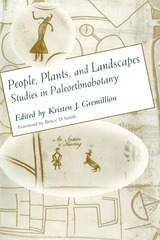 People, Plants, and Landscapes: Studies in Paleoethnobotany
Kristen J. Gremillion
University of Alabama Press, 1997 People, Plants, and Landscapes showcases the potential of modern paleoethnobotany, an interdisciplinary field that explores the interactions between human beings and plants by examining archaeological evidence. Using different methods and theoretical approaches, the essays in this work apply botanical knowledge to studies of archaeological plant remains and apply paleoethnobotany to nonarchaeological sources of evidence. The resulting techniques often lie beyond the traditional boundaries of either archaeology or botany. With this ground-breaking work, the technically and methodologically enhanced paleoethnobotany of the 1990s has joined forces with ecological and evolutionary theory to forge explanations of changing relationships between human and plant populations. Contents and Contributors: The Shaping of Modern Paleoethnobotany, Patty Jo Watson
New Perspectives on the Paleoethnobotany of the Newt Kash Shelter, Kristen J. Gremillion
A 3,000-Year-Old Cache of Crop Seeds from Marble Bluff, Arkansas, Gayle J. Fritz
Evolutionary Changes Associated with the Domestication of Cucurbita pepo: Evidence from Eastern Kentucky, C. Wesley Cowan
Anthropogenesis in Prehistoric Northeastern Japan, Gary W. Crawford
Between Farmstead and Center: The Natural and Social Landscape of Moundville, C. Margaret Scarry and Vincas P. Steponaitis
An Evolutionary Ecology Perspective on Diet Choice, Risk, and Plant Domestication, Bruce Winterhalder and Carol Goland
The Ecological Structure and Behavioral Implications of Mast Exploitation Strategies, Paul S. Gardner
Changing Strategies of Indian Field Location in the Early Historic Southeast, Gregory A. Waselkov
Interregional Patterns of Land Use and Plant Management in Native North America, Julia E. Hammett
 People Power: The Community Organizing Tradition of Saul Alinsky
Aaron Schutz
Vanderbilt University Press, 2015 Saul Alinsky, according to Time Magazine in 1970, was a "prophet of power to the people," someone who "has possibly antagonized more people . . . than any other living American." People Power introduces the major organizers who adopted and modified Alinsky's vision across the United States:
--Fred Ross, Cesar Chavez, Dolores Huerta, and the Community Service Organization and National Farm Workers Association
--Nicholas von Hoffman and the Woodlawn Organization
--Tom Gaudette and the Northwest Community Organization
--Ed Chambers, Richard Harmon, and the Industrial Areas Foundation
--Shel Trapp, Gale Cincotta, and National People's Action
--Heather Booth, Midwest Academy, and Citizen Action
--Wade Rathke and ACORN
Weaving classic texts with interviews and their own context-setting commentaries, the editors of People Power provide the first comprehensive history of Alinsky-based organizing in the tumultuous period from 1955 to 1980, when the key organizing groups in the United States took form. Many of these selections--previously available only on untranscribed audiotapes or in difficult-to-read mimeograph or Xerox formats--appear in print here for the first time.
People Power: Unarmed Resistance and Global Solidarity
Howard Clark
Pluto Press, 2009 Across the world, nonviolent movements are at the forefront of resistance against repression, imperial aggression and corporate abuse. However, it is often difficult for activists in other countries to know how best to assist such movements.
The contributors to People Power place nonviolent struggles in an international context where solidarity can play a crucial role. Yet they also warn that good intentions are not enough, solidarity has to listen to local movements.
Examining movements from Zimbabwe to Burma and Palestine, the contributors assess various forms of solidarity, arguing that a central role of solidarity is to strengthen the counter-power of those resisting domination and oppression.
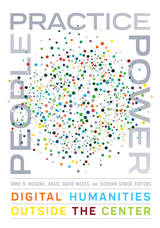 People, Practice, Power: Digital Humanities outside the Center
Anne B. McGrail
University of Minnesota Press, 2021 An illuminating volume of critical essays charting the diverse territory of digital humanities scholarship
The digital humanities have traditionally been considered to be the domain of only a small number of prominent and well-funded institutions. However, through a diverse range of critical essays, this volume serves to challenge and enlarge existing notions of how digital humanities research is being undertaken while also serving as a kind of alternative guide for how it can thrive within a wide variety of institutional spaces. Focusing on the complex infrastructure that undergirds the field of digital humanities, People, Practice, Power examines the various economic, social, and political factors that shape such academic endeavors. The multitude of perspectives comprising this collection offers both a much-needed critique of the existing structures for digital scholarship and the means to generate broader representation within the field. This collection provides a vital contribution to the realm of digital scholarly research and pedagogy in acknowledging the role that small liberal arts colleges, community colleges, historically black colleges and universities, and other underresourced institutions play in its advancement. Gathering together a range of voices both established and emergent, People, Practice, Power offers practitioners a self-reflexive examination of the current conditions under which the digital humanities are evolving, while helping to open up new sustainable pathways for its future. Contributors: Matthew Applegate, Molloy College; Taylor Arnold, U of Richmond; Eduard Arriaga, U of Indianapolis; Lydia Bello, Seattle U; Kathi Inman Berens, Portland State U; Christina Boyles, Michigan State U; Laura R. Braunstein, Dartmouth College; Abby R. Broughton; Maria Sachiko Cecire, Bard College; Brennan Collins, Georgia State U; Kelsey Corlett-Rivera, U of Maryland; Brittany de Gail, U of Maryland; Madelynn Dickerson, UC Irvine Libraries; Nathan H. Dize, Vanderbilt U; Quinn Dombrowski, Stanford U; Ashley Sanders Garcia, UCLA; Laura Gerlitz; Erin Rose Glass; Kaitlyn Grant; Margaret Hogarth, Claremont Colleges; Maryse Ndilu Kiese, U of Alberta; Pamella R. Lach, San Diego State U; James Malazita, Rensselaer Polytechnic Institute; Susan Merriam, Bard College; Chelsea Miya, U of Alberta; Jamila Moore Pewu, California State U, Fullerton; Urszula Pawlicka-Deger, Aalto U, Finland; Jessica Pressman, San Diego State U; Jana Remy, Chapman U; Roopika Risam, Salem State U; Elizabeth Rodrigues, Grinnell College; Dylan Ruediger, American Historical Association; Rachel Schnepper, Wesleyan U; Anelise Hanson Shrout, Bates College; Margaret Simon, North Carolina State U; Mengchi Sun, U of Alberta; Lauren Tilton, U of Richmond; Michelle R. Warren, Dartmouth College.
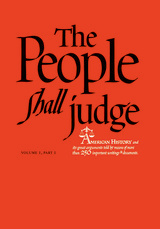 The People Shall Judge, Volume I, Part 1: Readings in the Formation of American Policy
Edited by Staff of Social Sciences 1 at The College of the University of Chicago
University of Chicago Press, 1976 The People Shall Judge provides a complete set of readings for courses in American history and political science and for general social science courses. The editors have assembled more than 250 readings which illustrate the great controversies in America's past, the issues involved in forming American public policy yesterday and today.
These selections have been drawn from systematic philosophies; from opinions expressed in law and judicial decisions; from speeches or pamphlets struck off in the heat of controversy; from political and diplomatic correspondence. They are grouped to focus attention on the perennial issues of liberty, equality, and security in about a dozen significant periods of American history. Volume I, Part 1, begins with a consideration of truth and liberty in the seventeenth century, continues with a study of the issues of the American Revolution, and concludes with a study of the Confederation and the Constitution.
The organization of the readings puts the issues in the context of four fundamental relationships: the citizen and the economy (and, within the economy, the interrelations of major interest groups); the federal union and the states; the United States and the world. The best available texts have been used. Introductions and explanatory notes relate the readings to one another, suggest the circumstances in which they were written, and provide biographical information about the authors.
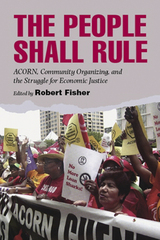 The People Shall Rule: ACORN, Community Organizing, and the Struggle for Economic Justice
Robert Fisher
Vanderbilt University Press, 2009 With the election of a community organizer as president of the United States, the time is right to evaluate the current state of community organizing and the effectiveness of ACORN (Association of Community Organizations for Reform Now). Since 2002, ACORN has been dramatically expanding and raising its national profile; it has also been weathering controversy over its voter registration campaigns and an internal financial scandal.
The twelve chapters in this volume present the perspectives of insiders like founder Wade Rathke and leading outside practitioners and academics. The result is a thorough detailing of ACORN's founding and its changing strategies, including vivid accounts and analyses of its campaigns on the living wage, voter turnout, predatory lending, redlining, school reform, and community redevelopment, as well as a critical perspective on ACORN's place in the community organizing landscape.
 People Skills for Policy Analysts
Michael Mintrom
Georgetown University Press, 2003 Policymaking is of its very nature a people-centered business-a good reason why highly effective policy analysts display not only superb technical expertise but excellent people skills as well. Those "people skills" include the ability to manage professional relationships, to learn from others about policy issues, to give presentations, to work in teams, to resolve conflict, to write for multiple audiences, and to engage in professional networking. Training programs for policy analysts often focus on technical skills. By working to enhance their people skills, policy analysts can increase their ability to produce technical work that changes minds. Fortunately, this unique book fills the gaps in such programs by covering the "people side" of policy analysis. Beyond explaining why people skills matter, this book provides practical, easy-to-follow advice on how policy analysts can develop and use their people skills. Each chapter provides a Skill Building Checklist, discussion ideas, and suggestions for further reading. People Skills is essential reading for anyone engaged in public policymaking and public affairs as well as all policy analysts. Completely changing how we think about what it means to be an effective policy analyst, People Skills for Policy Analysts provides straightforward advice for students of policy analysis and public management as well as practitioners just starting their professional lives.
People, Texts and Artefacts: Cultural Transmission in the Medieval Norman Worlds
Edited by David Bates, Edoardo D'Angelo, and Elisabeth Houts
University of London Press, 2018 This volume is based on two international conferences held in 2013 and 2014 at Ariano Irpino, and at Emmanuel College, Cambridge. It contains essays by leading scholars in the field. Like the conferences, the volume seeks to enhance interdisciplinary and international dialogue between those who work on the Normans and their conquests in northern and southern Europe in an original way. It has as its central theme issues related to cultural transfer, treated as being of a pan-European kind across the societies that the Normans conquered and as occurring within the distinct societies of the northern and southern conquests. These issues are also shown to be an aspect of the interaction between the Normans and the peoples they subjugated, among whom many then settled.
People under Power: Early Jewish and Christian Responses to the Roman Empire
Edited by Michael Labahn and Outi Lehtipuu
Amsterdam University Press, 2015 This volume presents a batch of incisive new essays on the relationship between Roman imperial power and ideology and Christian and Jewish life and thought within the empire. Employing diverse methodologies that include historical criticism, rhetorical criticism, postcolonial criticism, and social historical studies, the contributors offer fresh perspectives on a question that is crucial for our understanding not only of the late Roman Empire, but also of the growth and change of Christianity and Judaism in the imperial period.
 The People vs. Democracy: Why Our Freedom Is in Danger and How to Save It
Yascha Mounk
Harvard University Press, 2018 A New York Times Book Review Editors’ Choice
“Everyone worried about the state of contemporary politics should read this book.”
—Anne-Marie Slaughter
“A trenchant survey from 1989, with its democratic euphoria, to the current map of autocratic striving.”
—David Remnick, New Yorker
The world is in turmoil. From Russia and Turkey across Europe to the United States, authoritarian populists have seized power as two core components of liberal democracy—individual rights and the popular will—are increasingly at war. As the role of money in politics has soared, a system of “rights without democracy” has taken hold. Populists who rail against this say they want to return power to the people. But in practice they create something just as bad: a system of “democracy without rights.” Yascha Mounk offers a clear and trenchant analysis of what ails our democracy and what it will take to get it back on track.
“Democracy is going through its worst crisis since the 1930s… But what exactly is the nature of this crisis? And what is driving it? The People vs. Democracy stands out in a crowded field for the quality of its answers to these questions.”
—The Economist
“Brilliant… As this superb book makes clear, we need both the liberal framework and the democracy, and bringing them back together is the greatest challenge of our time.”
—Los Angeles Times
“Extraordinary…provides a clear, concise, persuasive, and insightful account of the conditions that made liberal democracy work—and how the breakdown in those conditions is the source of the current crisis of democracy around the world.”
—The Guardian
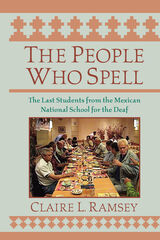 The People Who Spell: The Last Students from the Mexican National School for the Deaf
Claire L. Ramsey
Gallaudet University Press, 2011 The Escuela Nacional para Sordomudos (ENS), translated as the Mexican National School for the Deaf, opened its doors in the 1860s as part of the republic’s intention to educate its deaf people. The ENS did not use Lengua de Señas Mexicana (LSM), Mexico’s native sign language, for instruction, though they tolerated LSM use by the students. The school was closed permanently in 1972, thus leaving its former students still alive today as the last links to this historic institution. In this compelling social history, Claire L. Ramsey presents these unique Deaf Mexicans from their extraordinary experiences as ENS students and signers to their current personal lives. One ENS signer, María de los Ángeles Bedolla, inspired the title of the book, The People Who Spell. In her account, she describes herself and her peers as cultured and educated compared to the young deaf people of today. The ENS signers pride themselves on el deletreo, LSM fingerspelling, which they consider key to their sophistication. Ramsey relates each of the signers’ childhoods, marriages, work experiences, and retirements. However, she brings threads of their stories together to reveal a common and abiding disappointment in modern-day Mexico’s failure to educate its deaf citizens according to the promise made more than 100 years ago. The narratives of the ENS signers detail their remarkable lives and heritage but also legitimately question the future of Mexico’s young deaf people.
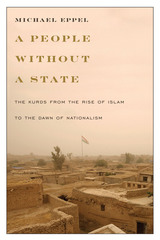 A People Without a State: The Kurds from the Rise of Islam to the Dawn of Nationalism
By Michael Eppel
University of Texas Press, 2016 Numbering between 25 and 35 million worldwide, the Kurds are among the largest culturally and ethnically distinct people to remain stateless. A People Without a State offers an in-depth survey of an identity that has often been ignored in mainstream historiographies of the Middle East and brings to life the historical, social, and political developments in Kurdistani society over the past millennium. Michael Eppel begins with the myths and realities of the origins of the Kurds, describes the effect upon them of medieval Muslim states under Arab, Persian, and Turkish dominance, and recounts the emergence of tribal-feudal dynasties. He explores in detail the subsequent rise of Kurdish emirates, as well as this people’s literary and linguistic developments, particularly the flourishing of poetry. The turning tides of the nineteenth century, including Ottoman reforms and fluctuating Russian influence after the Crimean War, set in motion an early Kurdish nationalism that further expressed a distinct cultural identity. Stateless, but rooted in the region, the Kurds never achieved independence because of geopolitical conditions, tribal rivalries, and obstacles on the way to modernization. A People Without a State captures the developments that nonetheless forged a vast sociopolitical system.
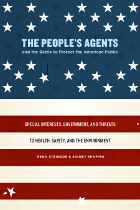 The People's Agents and the Battle to Protect the American Public: Special Interests, Government, and Threats to Health, Safety, and the Environment
Rena Steinzor and Sidney Shapiro
University of Chicago Press, 2010 Reasonable people disagree about the reach of the federal government, but there is near-universal consensus that it should protect us from such dangers as bacteria-infested food, harmful drugs, toxic pollution, crumbling bridges, and unsafe toys. And yet, the agencies that shoulder these responsibilities are in shambles; if they continue to decline, lives will be lost and natural resources will be squandered. In this timely book, Rena Steinzor and Sidney Shapiro take a hard look at the tangled web of problems that have led to this dire state of affairs.
It turns out that the agencies are not primarily to blame and that regulatory failure actually stems from a host of overlooked causes. Steinzor and Shapiro discover that unrelenting funding cuts, a breakdown of the legislative process, an increase in the number of political appointees, a concurrent loss of experienced personnel, chaotic White House oversight, and ceaseless political attacks on the bureaucracy all have contributed to the broken system. But while the news is troubling, the authors also propose a host of reforms, including a new model for measuring the success of the agencies and a revitalization of the civil service. The People’s Agents and the Battle to Protect the American Public is an urgent and compelling appeal to renew America’s best traditions of public service.
 The People’s Car: A Global History of the Volkswagen Beetle
Bernhard Rieger
Harvard University Press, 2013 At the Berlin Auto Show in 1938, Adolf Hitler presented the prototype for a small, oddly shaped, inexpensive family car that all good Aryans could enjoy. Decades later, that automobile—the Volkswagen Beetle—was one of the most beloved in the world. Bernhard Rieger examines culture and technology, politics and economics, and industrial design and advertising genius to reveal how a car commissioned by Hitler and designed by Ferdinand Porsche became an exceptional global commodity on a par with Coca-Cola.
Beyond its quality and low cost, the Beetle’s success hinged on its uncanny ability to capture the imaginations of people across nations and cultures. In West Germany, it came to stand for the postwar “economic miracle” and helped propel Europe into the age of mass motorization. In the United States, it was embraced in the suburbs, and then prized by the hippie counterculture as an antidote to suburban conformity. As its popularity waned in the First World, the Beetle crawled across Mexico and Latin America, where it symbolized a sturdy toughness necessary to thrive amid economic instability.
Drawing from a wealth of sources in multiple languages, The People’s Car presents an international cast of characters—executives and engineers, journalists and advertisers, assembly line workers and car collectors, and everyday drivers—who made the Beetle into a global icon. The Beetle’s improbable story as a failed prestige project of the Third Reich which became a world-renowned brand illuminates the multiple origins, creative adaptations, and persisting inequalities that characterized twentieth-century globalization.
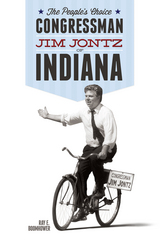 The People's Choice: Congressman Jim Jontz of Indiana
Ray Boomhower
Indiana Historical Society Press, 2012 This first-ever biography of Congressman Jim Jontz examines his remarkable long-shot political career and lifetime involvement in local, state, and national environmental issues. As a liberal Democrat (he preferred the terms progressive or populist) usually running in conservative districts, Jontz had political pundits predicting his defeat in every election only to see him celebrating another victory with his happy supporters, always clad in a scruffy plaid jacket with a hood from high school that he wore for good luck. “I always hope for the best and fight for the worst,” said Jontz. He won five terms as state representative for the Twentieth District (Benton, Newton, Warren, and White Counties), served two years in the Indiana Senate, and captured three terms in the U.S. Congress representing the sprawling Fifth Congressional District in northwestern Indiana that stretched from Lake County in the north to Grant County in the south. Jontz told a reporter that his political career had always “been based on my willingness and role as a spokesman for the average citizen.” In his career Jontz also led an unsuccessful campaign to stop the passage of the North American Free Trade Agreement with the Citizens Trade Campaign, helped protect the Endangered Species Act when it was under attack in the 1990s as director of the Endangered Species Coalition, campaigned to save old-growth forests as executive director of the Western Ancient Forest Campaign, and tried to foster progressive causes as president of the Americans for Democratic Action.
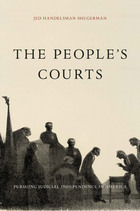 The People’s Courts: Pursuing Judicial Independence in America
Jed Handelsman Shugerman
Harvard University Press, 2012 In the United States, almost 90 percent of state judges have to run in popular elections to remain on the bench. In the past decade, this peculiarly American institution has produced vicious multi-million-dollar political election campaigns and high-profile allegations of judicial bias and misconduct. The People’s Courts traces the history of judicial elections and Americans’ quest for an independent judiciary—one that would ensure fairness for all before the law—from the colonial era to the present.
In the aftermath of economic disaster, nineteenth-century reformers embraced popular elections as a way to make politically appointed judges less susceptible to partisan patronage and more independent of the legislative and executive branches of government. This effort to reinforce the separation of powers and limit government succeeded in many ways, but it created new threats to judicial independence and provoked further calls for reform. Merit selection emerged as the most promising means of reducing partisan and financial influence from judicial selection. It too, however, proved vulnerable to pressure from party politics and special interest groups. Yet, as Shugerman concludes, it still has more potential for protecting judicial independence than either political appointment or popular election.
The People’s Courts shows how Americans have been deeply committed to judicial independence, but that commitment has also been manipulated by special interests. By understanding our history of judicial selection, we can better protect and preserve the independence of judges from political and partisan influence.
Peoples, Cultures and Nations in Political Philosophy
Paul Gilbert
Georgetown University Press, 2000 Wars of national secession and ethnic cleansing, based on the claims of supposedly distinct racial, ethnic, cultural, and national identities, have disfigured recent years. Probing the roots of these conflicts, this book provides the first comprehensive survey of the full range of political theories of ethnicity and nationalism. Paul Gilbert explores the role of identity in configuring contemporary states. He examines the concepts of race, ethnicity, cultural identity, and nationality, as well as the relevant political theories, including liberalism, communitarianism, and postmodernism. He also covers in depth the topics of citizenship and migration, multiculturalism and the ethics of secession. His multidisciplinary approach will be of value to those in philosophy, politics, sociology, and cultural studies.
The People’s Emperor: Democracy and the Japanese Monarchy, 1945–1995
Kenneth J. Ruoff
Harvard University Press, 2001 Few institutions are as well suited as the monarchy to provide a window on postwar Japan. The monarchy, which is also a family, has been significant both as a political and as a cultural institution.
This comprehensive study analyzes numerous issues, including the role of individual emperors in shaping the institution, the manner in which the emperor’s constitutional position as symbol has been interpreted, the emperor’s intersection with politics through ministerial briefings, memories of Hirohito’s wartime role, nationalistic movements in support of Foundation Day and the reign-name system, and the remaking of the once sacrosanct throne into a “monarchy of the masses” embedded in the postwar culture of democracy. The author stresses the monarchy’s “postwarness,” rather than its traditionality.
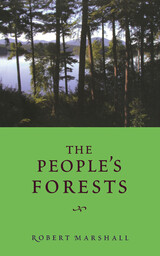 The People's Forests
Marshall, Robert
University of Iowa Press, 2002 Devoted conservationist, environmentalist, and explorer Robert Marshall (1901-1939) was chief of the Division of Recreation and Lands, U.S. Forest Service, when he died at age thirty-eight. Throughout his short but intense life, Marshall helped catalyze the preservation of millions of wilderness acres in all parts of the U.S., inspired countless wilderness advocates, and was a pioneer in the modern environmental movement: he and seven fellow conservationists founded the Wilderness Society in 1935. First published in 1933, The People's Forests made a passionate case for the public ownership and management of the nation's forests in the face of generations of devastating practices; its republication now is especially timely. Marshall describes the major values of forests as sources of raw materials, as essential resources for the conservation of soil and water, and as a “precious environment for recreation” and for “the happiness of millions of human beings.” He considers the pros and cons of private and public ownership, deciding that public ownership and large-scale public acquisition are vital in order to save the nation's forests, and sets out ways to intelligently plan for and manage public ownership. The last words of this book capture Marshall's philosophy perfectly: “The time has come when we must discard the unsocial view that our woods are the lumbermen's and substitute the broader ideal that every acre of woodland in the country is rightly a part of the people's forests.”
 A People’s Green New Deal
Max Ajl
Pluto Press, 2021 'Hands-down the best book yet on the Green New Deal' - Jason Hickel The idea of a Green New Deal was launched into popular consciousness by US Congressperson Alexandria Ocasio-Cortez in 2018. It has become a watchword in the current era of global climate crisis. But what - and for whom - is the Green New Deal?
In this concise and urgent book, Max Ajl provides an overview of the various mainstream Green New Deals. Critically engaging with their proponents, ideological underpinnings and limitations, he goes on to sketch out a radical alternative: a 'People's Green New Deal' committed to decommodification, working-class power, anti-imperialism and agro-ecology.
Ajl diagnoses the roots of the current socio-ecological crisis as emerging from a world-system dominated by the logics of capitalism and imperialism. Resolving this crisis, he argues, requires nothing less than an infrastructural and agricultural transformation in the Global North, and the industrial convergence between North and South. As the climate crisis deepens and the literature on the subject grows, A People's Green New Deal contributes a distinctive perspective to the debate.
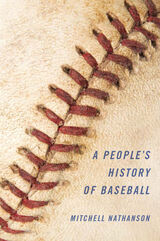 A People's History of Baseball
Mitchell Nathanson
University of Illinois Press, 2012 Baseball is much more than the national pastime. It has become an emblem of America itself. From its initial popularity in the mid-nineteenth century, the game has reflected national values and beliefs and promoted what it means to be an American. Stories abound that illustrate baseball's significance in eradicating racial barriers, bringing neighborhoods together, building civic pride, and creating on the field of play an instructive civics lesson for immigrants on the national character. In A People's History of Baseball, Mitchell Nathanson probes the less well-known but no less meaningful other side of baseball: episodes not involving equality, patriotism, heroism, and virtuous capitalism, but power--how it is obtained, and how it perpetuates itself. Through the growth and development of baseball Nathanson shows that, if only we choose to look for it, we can see the petty power struggles as well as the large and consequential ones that have likewise defined our nation. By offering a fresh perspective on the firmly embedded tales of baseball as America, a new and unexpected story emerges of both the game and what it represents. Exploring the founding of the National League, Nathanson focuses on the newer Americans who sought club ownership to promote their own social status in the increasingly closed caste of nineteenth-century America. His perspective on the rise and public rebuke of the Players Association shows that these baseball events reflect both the collective spirit of working and middle-class America in the mid-twentieth century as well as the countervailing forces that sought to beat back this emerging movement that threatened the status quo. And his take on baseball’s racial integration that began with Branch Rickey’s “Great Experiment” reveals the debilitating effects of the harsh double standard that resulted, requiring a black player to have unimpeachable character merely to take the field in a Major League game, a standard no white player was required to meet. Told with passion and occasional outrage, A People's History of Baseball challenges the perspective of the well-known, deeply entrenched, hyper-patriotic stories of baseball and offers an incisive alternative history of America's much-loved national pastime.
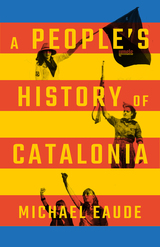 A People's History of Catalonia
Michael
Pluto Press, 2022 The fight of an oppressed nation for its sovereignty has often dovetailed with that of a militant working class for social justice. At every home game of FC Barcelona, at 17 minutes and 14 seconds of play, the 100,000-capacity Camp Nou stadium is filled by the roar of “IN-DE-PEN-DÈN-CI-A!” Time stops for a second. History lives in the present... Catalonia's national consciousness has deep roots. There are countries twice the size with histories half as interesting. A People's History of Catalonia tells that history, from below, in all its richness and complexity. The region's struggle for independence has, for centuries, been violently resisted, the Catalan language suppressed and its leaders jailed. From the peasant revolts of the 15th century and the siege of Barcelona in 1714, to defeat in the Spanish Civil War, and the slow re-emergence of the workers' movement and anti-Francoist resistance in the years that followed, Michael Eaude tells a compelling story whose ending has yet to be written.
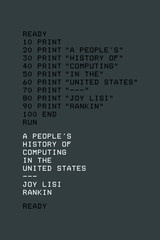 A People’s History of Computing in the United States
Joy Lisi Rankin
Harvard University Press, 2018 Silicon Valley gets all the credit for digital creativity, but this account of the pre-PC world, when computing meant more than using mature consumer technology, challenges that triumphalism.
The invention of the personal computer liberated users from corporate mainframes and brought computing into homes. But throughout the 1960s and 1970s a diverse group of teachers and students working together on academic computing systems conducted many of the activities we now recognize as personal and social computing. Their networks were centered in New Hampshire, Minnesota, and Illinois, but they connected far-flung users. Joy Rankin draws on detailed records to explore how users exchanged messages, programmed music and poems, fostered communities, and developed computer games like The Oregon Trail. These unsung pioneers helped shape our digital world, just as much as the inventors, garage hobbyists, and eccentric billionaires of Palo Alto.
By imagining computing as an interactive commons, the early denizens of the digital realm seeded today’s debate about whether the internet should be a public utility and laid the groundwork for the concept of net neutrality. Rankin offers a radical precedent for a more democratic digital culture, and new models for the next generation of activists, educators, coders, and makers.
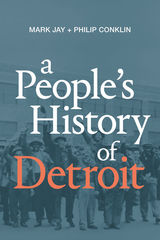 A People's History of Detroit
Mark Jay and Philip Conklin
Duke University Press, 2020 Recent bouts of gentrification and investment in Detroit have led some to call it the greatest turnaround story in American history. Meanwhile, activists point to the city's cuts to public services, water shutoffs, mass foreclosures, and violent police raids. In A People's History of Detroit, Mark Jay and Philip Conklin use a class framework to tell a sweeping story of Detroit from 1913 to the present, embedding Motown's history in a global economic context. Attending to the struggle between corporate elites and radical working-class organizations, Jay and Conklin outline the complex sociopolitical dynamics underlying major events in Detroit's past, from the rise of Fordism and the formation of labor unions, to deindustrialization and the city's recent bankruptcy. They demonstrate that Detroit's history is not a tale of two cities—one of wealth and development and another racked by poverty and racial violence; rather it is the story of a single Detroit that operates according to capitalism's mandates.
A People's History of Europe: From World War I to Today
Raquel Varela
Pluto Press, 2020 This concise people's history of Europe tells the story of the last hundred years of a very old continent and the ordinary people that shaped the events that defined it from World War I to today.
From the Russian Revolution, through May '68 and the Prague Spring, to the present day, we hear from feminists, trade unionists, conscientious objectors and activists and learn of immigration struggles, anti-colonial conflicts and labour movements. Cutting against the grain of mainstream histories, this is a history of Europe told from below.
Containing new and fascinating insights, Raquel Varela paints a different picture of the European story; one where ordinary Europeans are active agents of their own history.
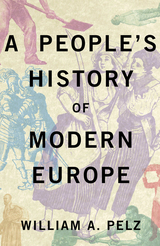 A People's History of Modern Europe
William A. Pelz
Pluto Press, 2016 The origin of capitalism and modern industrialism—and, not unrelated, the birthplace of Marxism—modern Europe provided the perfect conditions for a great number of political revolutions. From the monarchical terror of the Middle Ages to the mangled Europe of the twenty-first century, A People’s History of Modern Europe tracks the history of the continent through the deeds of those whom mainstream history tries to forget.
Along the way, William A. Pelz examines the German peasant wars of Thomas Müntzer, the bourgeoisie revolutions of the eighteenth century, the rise of the industrial worker in England, the turbulent journey of the Russian Soviets, the role of the European working class throughout the Cold War, and the revolutionary students in 1968. He then brings his story to the present day, where we continue to fight to forge an alternative to a heartless and often barbaric economic system.
As Germany and Greece argue over who owes what, with the very idea of Europe crumbling around them, Pelz’s accessible, provocative history could not be timelier. Sure to resonate with fans of books like Howard Zinn’s A People’s History of the United States, this people’s history sweeps away the tired platitudes of the privileged and provides an opportunity to understand the story of Europe from the ground up.
A People's History of Tennis
David Berry
Pluto Press, 2020 Pristine lawns, tennis whites, strawberries and cream, tennis is synonymous with the upper echelons of society, but scratch beneath the surface and you'll quickly discover a different history, one of untold struggles on and off the courts.
From the birth of modern tennis in Victorian Britain to the present day, we bear witness to struggles around sexuality, gender, race and class that have transformed the nature of tennis and sport itself. A People's History of Tennis is populated by diverse voices, recounting the sport's gay origins, 'Workers' Wimbledon', battles for gender equality and more.
Going beyond center court, this book reveals the hidden history of the game, providing a rich account of the challenges faced and victories won.
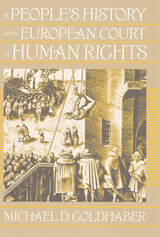 A People's History of the European Court of Human Rights: A People's History of the European Court of Human Rights, First Paperback Edition
Goldhaber, Michael
Rutgers University Press, 2007 The exceptionality of America’s Supreme Court has long been conventional wisdom. But the United States Supreme Court is no longer the only one changing the landscape of public rights and values. Over the past thirty years, the European Court of Human Rights has developed an ambitious, American-style body of law. Unheralded by the mass press, this obscure tribunal in Strasbourg, France has become, in many ways, the Supreme Court of Europe. Michael Goldhaber introduces American audiences to the judicial arm of the Council of Europe—a group distinct from the European Union, and much larger—whose mission is centered on interpreting the European Convention on Human Rights. The Council routinely confronts nations over their most culturally-sensitive, hot-button issues. It has stared down France on the issue of Muslim immigration; Ireland on abortion; Greece on Greek Orthodoxy; Turkey on Kurdish separatism; Austria on Nazism; and Britain on gay rights and corporal punishment. And what is most extraordinary is that nations commonly comply. In the battle for the world’s conscience, Goldhaber shows how the court in Strasbourg may be pulling ahead.
A People's History of the German Revolution
William A. Pelz
Pluto Press, 2018 In October 1918, war-weary German sailors mutinied rather than engage in one final, fruitless battle with the British Royal Navy. That revolt, coming as World War I slowly ended, quickly became far bigger, erupting into a full-scale revolution that toppled the monarchy and inaugurated a brief period of radical popular democracy. This book tells that mostly forgotten story, going beyond the handful of familiar names such as Rosa Luxemburg and Karl Liebknecht to present the revolution from the bottom up. Through stories of the actions of rank-and-file activists and ordinary workers, Willam A. Pelz builds a compelling case that, for a brief period, the actions of the common people shaped a truly revolutionary society.
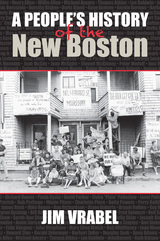 A People's History of the New Boston
Jim Vrabel
University of Massachusetts Press, 2014 Although Boston today is a vibrant and thriving city, it was anything but that in the years following World War II. By 1950 it had lost a quarter of its tax base over the previous twenty-five years, and during the 1950s it would lose residents faster than any other major city in the country.
Credit for the city's turnaround since that time is often given to a select group of people, all of them men, all of them white, and most of them well off. In fact, a large group of community activists, many of them women, people of color, and not very well off, were also responsible for creating the Boston so many enjoy today. This book provides a grassroots perspective on the tumultuous 1960s and 1970s, when residents of the city's neighborhoods engaged in an era of activism and protest unprecedented in Boston since the American Revolution.
Using interviews with many of those activists, contemporary news accounts, and historical sources, Jim Vrabel describes the demonstrations, sit-ins, picket lines, boycotts, and contentious negotiations through which residents exerted their influence on the city that was being rebuilt around them. He includes case histories of the fights against urban renewal, highway construction, and airport expansion; for civil rights, school desegregation, and welfare reform; and over Vietnam and busing. He also profiles a diverse group of activists from all over the city, including Ruth Batson, Anna DeFronzo, Moe Gillen, Mel King, Henry Lee, and Paula Oyola. Vrabel tallies the wins and losses of these neighborhood Davids as they took on the Goliaths of the time, including Boston's mayors. He shows how much of the legacy of that activism remains in Boston today.
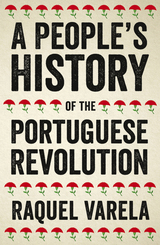 A People's History of the Portuguese Revolution
Raquel Cardeira Varela
Pluto Press, 2018 On the 25th April 1974, a coup destroyed the ranks of Portugal’s fascist Estado Novo government as the Portuguese people flooded the streets of Lisbon, placing red carnations in the barrels of guns and demanding a ‘land for those who work in it’.
This became the Carnation Revolution - an international coalition of working class and social movements, which also incited struggles for independence in Portugal’s African colonies, the rebellion of the young military captains in the national armed forces and the uprising of Portugal’s long-oppressed working classes. It was through the organising power of these diverse movements that a popular-front government was instituted and Portugal withdrew from its overseas colonies.
Cutting against the grain of mainstream accounts, Raquel Cardeira Varela explores the role of trade unions, artists and women in the revolution, providing a rich account of the challenges faced and the victories gained through revolutionary means.
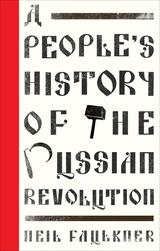 A People's History of the Russian Revolution
Neil Faulkner
Pluto Press, 2017 The Russian Revolution may be the most misunderstood and misrepresented event in modern history, its history told in a mix of legends and anecdotes. In A People's History of the Russian Revolution, Neil Faulkner sets out to debunk the myths and pry fact from fiction, putting at the heart of the story the Russian people who are the true heroes of this tumultuous tale. In this fast-paced introduction, Faulkner tells the powerful narrative of how millions of people came together in a mass movement, organized democratic assemblies, mobilized for militant action, and overturned a vast regime of landlords, profiteers, and warmongers.
Faulkner rejects caricatures of Lenin and the Bolsheviks as authoritarian conspirators or the progenitors of Stalinist dictatorship, and forcefully argues that the Russian Revolution was an explosion of democracy and creativity—and that it was crushed by bloody counter-revolution and replaced with a form of bureaucratic state-capitalism.
Grounded by powerful first-hand testimony, this history marks the centenary of the Revolution by restoring the democratic essence of the revolution, offering a perfect primer for the modern reader.
 A People's History of the Second World War: Resistance Versus Empire
Donny Gluckstein
Pluto Press, 2012 A People's History of the Second World War unearths the fascinating history of the war as fought 'from below'. Until now, the vast majority of historical accounts have focussed on the conflict between the Allied and Axis powers for imperialist mastery. Donny Gluckstein shows that in fact between 1939 and 1945 two distinct wars were fought – one ‘from above’ and one ‘from below’.
Using examples from countries under the Nazi heel, in the colonies and within the Axis and Allied camps, Gluckstein brings to life the very different struggle of the people's and resistance movements which proliferated during the war. He shows how they fought not just fascism, but colonialism and empire, and were betrayed by the Allies at the war’s end.
This book will fundamentally challenge our understanding of the Second World War – both about the people who fought it and the reasons for which it was fought.
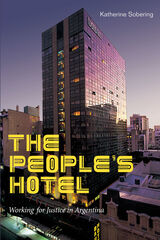 The People's Hotel: Working for Justice in Argentina
Katherine Sobering
Duke University Press, 2022 In 2001 Argentina experienced a massive economic crisis: businesses went bankrupt, unemployment spiked, and nearly half the population fell below the poverty line. In the midst of the crisis, Buenos Aires’s iconic twenty-story Hotel Bauen quietly closed its doors, forcing longtime hospitality workers out of their jobs. Rather than leaving the luxury hotel vacant, a group of former employees occupied the property and kept it open. In The People’s Hotel, Katherine Sobering recounts the history of the Hotel Bauen, detailing its transformation from a privately owned business into a worker cooperative—one where decisions were made democratically, jobs were rotated, and all members were paid equally. Combining ethnographic and archival research with her own experiences as a volunteer worker at the hotel, Sobering examines how the Bauen Cooperative grew and, against all odds, successfully kept the hotel open for nearly two decades. Highlighting successes and innovations alongside the many challenges that these workers faced, Sobering presents a vivid portrait of efforts to address inequality and reorganize work in a capitalist economy.
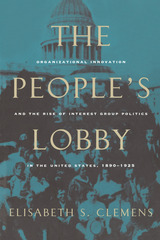 The People's Lobby: Organizational Innovation and the Rise of Interest Group Politics in the United States, 1890-1925
Elisabeth S. Clemens
University of Chicago Press, 1997 In this pathbreaking work, Elisabeth S. Clemens recovers the social origins of interest group politics in the United States. Between 1890 and 1925, a system centered on elections and party organizations was partially transformed by increasingly prominent legislative and administrative policy-making as well as the insistent participation of non-partisan organizations.
Clemens sheds new light on how farmers, workers, and women invented strategies to circumvent the parties. Voters learned to monitor legislative processes, to hold their representatives accountable at the polls, and to institutionalize their ongoing participation in shaping policy. Closely analyzing the organizational politics in three states—California, Washington, and Wisconsin—she demonstrates how the political opportunity structure of federalism allowed regional innovations to exert leverage on national political institutions.
An authoritative statement on the changes in American politics during the Progressive Era, this book will interest political scientists, sociologists, and American historians.
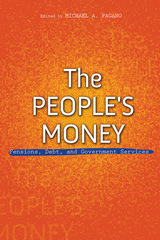 The People's Money: Pensions, Debt, and Government Services
Edited by Michael A. Pagano
University of Illinois Press, 2019 American cities continue to experience profound fiscal crises. Falling revenues cannot keep pace with the increased costs of vital public services, infrastructure development and improvement, and adequately funded pensions. Chicago presents an especially vivid example of these issues, as the state of Illinois's rocky fiscal condition compounds the city's daunting budget challenges. In The People's Money, Michael A. Pagano curates a group of essays that emerged from discussions at the 2018 UIC Urban Forum. The contributors explore fundamental questions related to measuring the fiscal health of cities, including how cities can raise revenue, the accountability of today's officials for the future financial position of a city, the legal and practical obstacles to pension reform and a balanced budget, and whether political collaboration offers an alternative to the competition that often undermines regional governance.Contributors: Jered B. Carr, Rebecca Hendrick, Martin J. Luby, David Merriman, Michael A. Pagano, David Saustad, Casey Sebetto, Michael D. Siciliano, James E. Spiotto, Gary Strong, Shu Wang, and Yonghong Wu
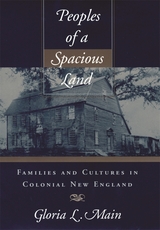 Peoples of a Spacious Land: Families and Cultures in Colonial New England
Gloria L. Main
Harvard University Press, 2004 In this book about families--those of the various native peoples of southern New England and those of the English settlers and their descendants--Gloria Main compares the ways in which the two cultures went about solving common human problems. Using original sources--diaries, inventories, wills, court records--as well as the findings of demographers, ethnologists, and cultural anthropologists, she compares the family life of the English colonists with the lives of comparable groups remaining in England and of native Americans. She looks at social organization, patterns of work, gender relations, sexual practices, childbearing and childrearing, demographic changes, and ways of dealing with sickness and death.
Main finds that the transplanted English family system produced descendants who were unusually healthy for the times and spectacularly fecund. Large families and steady population growth led to the creation of new towns and the enlargement of old ones with inevitably adverse consequences for the native Americans in the area. Main follows the two cultures into the eighteenth century and makes clear how the promise of perpetual accessions of new land eventually extended Puritan family culture across much of the North American continent.
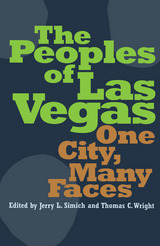 The Peoples Of Las Vegas: One City, Many Faces
Jerry L Simich
University of Nevada Press, 2005 Beneath the glitzy surface of the resorts and the seemingly cookie-cutter suburban sprawl of Las Vegas lies a vibrant and diverse ethnic life. People of varied origins make up the population of nearly two million and yet, until now, little mention of the city has been made in studies and discussion of ethnicity or immigration. The Peoples of Las Vegas: One City, Many Faces fills this void by presenting the work of seventeen scholars of history, political science, sociology, anthropology, law, urban studies, cultural studies, literature, social work, and ethnic studies to provide profiles of thirteen of the city’s many ethnic groups. The book’s introduction and opening chapters explore the historical and demographic context of these groups, as well as analyze the economic and social conditions that make Las Vegas so attractive to recent immigrants. Each group is the subject of the subsequent chapters, outlining migration motivations and processes, economic pursuits, cultural institutions and means of transmitting culture, involvement in the broader community, ties to homelands, and recent demographic trends.
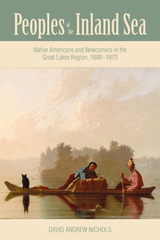 Peoples of the Inland Sea: Native Americans and Newcomers in the Great Lakes Region, 1600–1870
David Andrew Nichols
Ohio University Press, 2018 Diverse in their languages and customs, the Native American peoples of the Great Lakes region—the Miamis, Ho-Chunks, Potawatomis, Ojibwas, and many others—shared a tumultuous history. In the colonial era their rich homeland became a target of imperial ambition and an invasion zone for European diseases, technologies, beliefs, and colonists. Yet in the face of these challenges, their nations’ strong bonds of trade, intermarriage, and association grew and extended throughout their watery domain, and strategic relationships and choices allowed them to survive in an era of war, epidemic, and invasion. In Peoples of the Inland Sea, David Andrew Nichols offers a fresh and boundary-crossing history of the Lakes peoples over nearly three centuries of rapid change, from pre-Columbian times through the era of Andrew Jackson’s Removal program. As the people themselves persisted, so did their customs, religions, and control over their destinies, even in the Removal era. In Nichols’s hands, Native, French, American, and English sources combine to tell this important story in a way as imaginative as it is bold. Accessible and creative, Peoples of the Inland Sea is destined to become a classroom staple and a classic in Native American history.
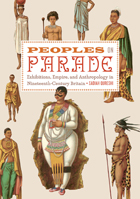 Peoples on Parade: Exhibitions, Empire, and Anthropology in Nineteenth-Century Britain
Sadiah Qureshi
University of Chicago Press, 2011 In May 1853, Charles Dickens paid a visit to the “savages at Hyde Park Corner,” an exhibition of thirteen imported Zulus performing cultural rites ranging from songs and dances to a “witch-hunt” and marriage ceremony. Dickens was not the only Londoner intrigued by these “living curiosities”: displayed foreign peoples provided some of the most popular public entertainments of their day. At first, such shows tended to be small-scale entrepreneurial speculations of just a single person or a small group. By the end of the century, performers were being imported by the hundreds and housed in purpose-built “native” villages for months at a time, delighting the crowds and allowing scientists and journalists the opportunity to reflect on racial difference, foreign policy, slavery, missionary work, and empire. Peoples on Parade provides the first substantial overview of these human exhibitions in nineteenth-century Britain. Sadiah Qureshi considers these shows in their entirety—their production, promotion, management, and performance—to understand why they proved so commercially successful, how they shaped performers’ lives, how they were interpreted by their audiences, and what kinds of lasting influence they may have had on notions of race and empire. Qureshi supports her analysis with diverse visual materials, including promotional ephemera, travel paintings, theatrical scenery, art prints, and photography, and thus contributes to the wider understanding of the relationship between science and visual culture in the nineteenth century. Through Qureshi’s vibrant telling and stunning images, readers will see how human exhibitions have left behind a lasting legacy both in the formation of early anthropological inquiry and in the creation of broader public attitudes toward racial difference.
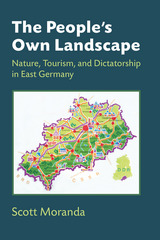 The People's Own Landscape: Nature, Tourism, and Dictatorship in East Germany
Scott Moranda
University of Michigan Press, 2014 East Germany’s Socialist Unity Party aimed to placate a public well aware of the higher standards of living enjoyed elsewhere by encouraging them to participate in outdoor activities and take vacations in the countryside. Scott Moranda considers East Germany’s rural landscapes from the perspective of both technical experts (landscape architects, biologists, and physicians) who hoped to dictate how vacationers interacted with nature, and the vacationers themselves, whose outdoor experience shaped their understanding of environmental change. As authorities eliminated traditional tourist and nature conservation organizations, dissident conservationists demanded better protection of natural spaces. At the same time, many East Germans shared their government’s expectations for economic development that had real consequences for the land. By the 1980s, environmentalists saw themselves as outsiders struggling against the state and a public that had embraced mainstream ideas about limitless economic growth and material pleasures.
The People’s Party in Texas: A Study in Third Party Politics
By Roscoe Martin
University of Texas Press, 1970 Roscoe Martin's study of the People's Party in Texas was a pioneering analysis of the state populist movements and long considered one of the best. The People's Party was an influential force in United States politics in the last decade of the nineteenth century, especially in the western and southern states. Martin's study of third-party politics in Texas, as well as being an important work in Texas history, provides much insight into the national radical movement of the 1890s.
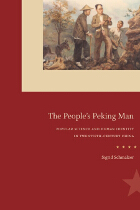 The People's Peking Man: Popular Science and Human Identity in Twentieth-Century China
Sigrid Schmalzer
University of Chicago Press, 2008 In the 1920s an international team of scientists and miners unearthed the richest evidence of human evolution the world had ever seen: Peking Man. After the communist revolution of 1949, Peking Man became a prominent figure in the movement to bring science to the people. In a new state with twin goals of crushing “superstition” and establishing a socialist society, the story of human evolution was the first lesson in Marxist philosophy offered to the masses. At the same time, even Mao’s populist commitment to mass participation in science failed to account for the power of popular culture—represented most strikingly in legends about the Bigfoot-like Wild Man—to reshape ideas about human nature.
The People’s Peking Man is a skilled social history of twentieth-century Chinese paleoanthropology and a compelling cultural—and at times comparative—history of assumptions and debates about what it means to be human. By focusing on issues that push against the boundaries of science and politics, The People’s Peking Man offers an innovative approach to modern Chinese history and the history of science.
 The People’s Plaza: Sixty-Two Days of Nonviolent Resistance
Justin Jones
Vanderbilt University Press, 2022 From June 12, 2020, until the passage of the state law making the occupation a felony two months later, peaceful protesters set up camp at Nashville's Legislative Plaza and renamed it for Ida B. Wells.
Central to the occupation was Justin Jones, a student of Fisk University and Vanderbilt Divinity School whose place at the forefront of the protests brought him and the occupation to the attention of the Tennessee state troopers, state and US senators, and Governor Bill Lee. The result was two months of solidarity in the face of rampant abuse, community in the face of state-sponsored terror, and standoff after standoff at the doorsteps of the people's house with those who claimed to represent them. In this, his first book, Jones describes those two revolutionary months of nonviolent resistance against a police state that sought to dehumanize its citizens.
The People's Plaza is a rumination on the abuse of power, and a vision of a more just, equitable, anti-racist Nashville—a vision that kept Jones and those with him posted on the plaza through intense heat, unprovoked arrests, vandalism, theft, and violent suppression. It is a first-person account of hope, a statement of intent, and a blueprint for nonviolent resistance in the American South and elsewhere.
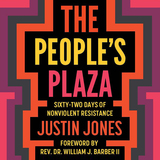 The People’s Plaza: Sixty-Two Days of Nonviolent Resistance
Justin Jones
Vanderbilt University Press, 2022 From June 12, 2020, until the passage of the state law making the occupation a felony two months later, peaceful protesters set up camp at Nashville's Legislative Plaza and renamed it for Ida B. Wells.
Central to the occupation was Justin Jones, a student of Fisk University and Vanderbilt Divinity School whose place at the forefront of the protests brought him and the occupation to the attention of the Tennessee state troopers, state and US senators, and Governor Bill Lee. The result was two months of solidarity in the face of rampant abuse, community in the face of state-sponsored terror, and standoff after standoff at the doorsteps of the people's house with those who claimed to represent them. In this, his first book, Jones describes those two revolutionary months of nonviolent resistance against a police state that sought to dehumanize its citizens.
The People's Plaza is a rumination on the abuse of power, and a vision of a more just, equitable, anti-racist Nashville—a vision that kept Jones and those with him posted on the plaza through intense heat, unprovoked arrests, vandalism, theft, and violent suppression. It is a first-person account of hope, a statement of intent, and a blueprint for nonviolent resistance in the American South and elsewhere.
 People's Pornography: Sex and Surveillance on the Chinese Internet
Katrien Jacobs
Intellect Books, 2012 Since its establishment in 1949, the People's Republic of China has upheld a nationwide ban on pornography, imposing harsh punishments on those caught purchasing, producing, or distributing materials deemed a violation of public morality. A provocative contribution to Chinese media studies by a well-known international media researcher, People’s Pornography offers a wide-ranging overview of the political controversies surrounding the ban, as well as a fascinating glimpse into the many distinct media subcultures that have gained widespread popularity on the Chinese Internet as a result. Rounding out this exploration of the many new tendencies in digital citizenship, pornography, and activist media cultures in the greater China region are thought-provoking interviews with individuals involved. A timely contribution to the existing literature on sexuality, Chinese media, and Internet culture, People’s Pornography provides a unique angle on the robust voices involved in the debate over about pornography’s globalization.
 The People’s Post Office: The History and Politics of the Japanese Postal System, 1871–2010
Patricia L. Maclachlan
Harvard University Press, 2011 In 2001, Prime Minister Koizumi Jun’ichirō launched a crusade to privatize Japan’s postal services. The plan was hailed as a necessary structural reform, but many bemoaned the loss of traditional institutions and the conservative values they represented. Few expected the plan to succeed, given the staunch opposition of diverse parties, but four years later it appeared that Koizumi had transformed not only the post office but also the very institutional and ideological foundations of Japanese finance and politics. By all accounts, it was one of the most astonishing political achievements in postwar Japanese history.
Patricia L. Maclachlan analyzes the interplay among the institutions, interest groups, and leaders involved in the system’s evolution from the early Meiji period until 2010. Exploring the postal system’s remarkable range of economic, social, and cultural functions and its institutional relationship to the Japanese state, this study shows how the post office came to play a leading role in the country’s political development. It also looks into the future to assess the resilience of Koizumi’s reforms and consider the significance of lingering opposition to the privatization of one of Japan’s most enduring social and political sanctuaries.
 The People's Princes: Machiavelli, Leadership, and Liberty
John P. McCormick
University of Chicago Press, 2025 A new window into Machiavelli’s idea of virtuous leadership and the appropriate relationship among leaders, common citizens, and elites. For more than a decade, John P. McCormick has been at the forefront of a new wave of scholarship that reveals the anti-elitist and democratic commitments at the center of Niccolo Machiavelli’s political thought. In The People’s Princes, McCormick turns his attention to Machiavelli’s conception of virtuous leadership and Machiavelli’s views on the appropriate relationships among individual leaders, common citizens, and elites. While most people think of Machiavelli as a cynical advisor of tyrants—a man who counseled leaders to aggrandize themselves, by any means necessary, at the expense of their subjects and citizens—The People’s Princes fundamentally challenges this understanding. Drawing from Machiavelli’s major political works a normative standard for leadership that emphasizes the mutually reinforcing relationship of civic leadership and popular government, McCormick delineates Machiavelli’s method of “political exemplarity” by analyzing in detail the Florentine’s case studies of leaders and their interactions with populaces throughout ancient and modern history. McCormick argues that Machiavelli suggests that civic leaders should enhance their reputations by providing for their own eventual obsolescence; specifically, they should establish institutional means through which common citizens rule themselves more directly and substantively. The People’s Princes invites readers to consider Machiavelli anew, and also reflect on insights that remain relevant in the twenty-first century amidst growing concerns that political leaders are not accountable or responsive to popular majorities.
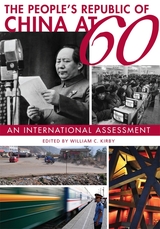 The People’s Republic of China at 60: An International Assessment
William C. Kirby
Harvard University Press, 2011 In 2009, to mark the sixtieth anniversary of the People’s Republic of China, the Fairbank Center for Chinese Studies convened a major conference to discuss the health and longevity of China’s ruling system and to consider a fundamental question: After three decades of internal strife and turmoil, followed by an era of reform, entrepreneurialism, and internationalization, is the PRC here for the dynastic long haul?
Bringing together scholars and students of China from around the world, the gathering witnessed an energetic exchange of views on four interrelated themes: polities, social transformations, wealth and well-being, and culture, belief, and practice. Edited and expanded from the original conference papers, the wide-ranging essays in this bilingual volume remain true to the conference’s aim: to promote open discussion of the past, present, and future of the People’s Republic of China.
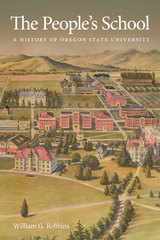 The People's School: A History of Oregon State University
William Robbins
Oregon State University Press, 2017 The People’s School is a comprehensive history of Oregon State University, placing the institution’s story in the context of state, regional, national, and international history. Rather than organizing the narrative around institutional presidencies, historian William Robbins examines the broader context of events, such as wars and economic depressions, that affected life on the Corvallis campus. Agrarian revolts in the last quarter of the nineteenth century affected every Western state, including Oregon. The Spanish-American War, the First World War, the Great Depression of the 1930s, and the Second World War disrupted institutional life, influencing enrollment, curricular strategies, and the number of faculty and staff. Peacetime events, such as Oregon’s tax policies, also circumscribed course offerings, hiring and firing, and the allocation of funds to departments, schools, and colleges.
This contextual approach is not to suggest that university presidents are unimportant. Benjamin Arnold (1872-1892), appointed president of Corvallis College by the Methodist Episcopal Church, South, served well beyond the date (1885) when the State of Oregon assumed control of the agricultural college. Robbins uses central administration records and grassroots sources—local and state newspapers, student publications (The Barometer, The Beaver), and multiple and wide-ranging materials published in the university’s digitized ScholarsArchive@OSU, a source for the scholarly work of faculty, students, and materials related to the institution’s mission and research activities. Other voices—extracurricular developments, local and state politics, campus reactions to national crises—provide intriguing and striking addendums to the university’s rich history.
 The People's Spaceship: NASA, the Shuttle Era, and Public Engagement after Apollo
Amy Paige Kaminski
University of Pittsburgh Press, 2024 When the Apollo 11 astronauts returned from humanity’s first voyage to the moon in 1969, NASA officials advocated for more ambitious missions. But with the civil rights movement, environmental concerns, the Vietnam War, and other social crises taking up much of the public’s attention, they lacked the support to make those ambitions a reality. Instead, the space agency had to think more modestly and pragmatically, crafting a program that could leverage the excitement of Apollo while promising relevance for average Americans. The resulting initiative, the space shuttle, would become the centerpiece of NASA human space flight activity for forty years, opening opportunities for the public to engage with and participate in space projects in new ways. The People’s Spaceship traces how and why NASA painstakingly connected the vehicle to so many segments of society. Underscoring the successes and challenges endured in the process, Amy Paige Kaminski shares the story of how the space shuttle became an American technological icon.
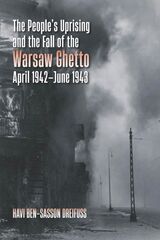 The People's Uprising and the Fall of Warsaw Ghetto, April 1942–June 1943
Havi Ben-Sasson Dreifuss
Brandeis University Press, 2026 Examines the final years of the Warsaw ghetto, the uprising, and the varied, nuanced ways Jewish people resisted Nazi rule.
The People’s Uprising and the Fall of the Warsaw Ghetto, April 1942–June 1943 sheds light on the lives, choices, and experiences of the tens of thousands of Jews who were not part of the underground armed resistance but nonetheless supported the famed Warsaw Ghetto Uprising. This riveting and dramatic account focuses on the final year of the Warsaw ghetto, from the Great Deportation in the summer of 1942 through the suppression of the uprising in mid-1943. Drawing on powerful contemporary testimonies, diaries, and documents—many of them previously unexplored—Havi Ben-Sasson Dreifuss
reveals how members of the broader Jewish population struggled to survive, maintain family and community life, and make impossible moral decisions in the face of fear, hunger, and daily violence. Looking beyond the fighters themselves, the book offers a story of devastation, but also of resilience and human dignity.
Published in association with Yad Vashem.
 The People's War: Responses to World War II in the Soviet Union
Edited by Robert W. Thurston and Bernd Bonwetsch
University of Illinois Press, 2000 The People's War lifts the Stalinist veil of secrecy to probe an almost untold side of World War II: the experiences of the Soviet people themselves. Going beyond dry and faceless military accounts of the eastern front of the "Great Patriotic War" and the Soviet state's one-dimensional "heroic People," this volume explores how ordinary citizens responded to the war, Stalinist leadership, and Nazi invasion.
Drawing on a wealth of archival and recently published material, contributors detail the calculated destruction of a Jewish town by the Germans and present a chilling picture of life in occupied Minsk. They look at the cultural developments of the war as well as the wartime experience of intellectuals, for whom the period was a time of relative freedom. They discuss women's myriad roles in combat and other spheres of activity. They also reassess the behavior and morale of ordinary Red Army troops and offer new conclusions about early crushing defeats at the hands of the Germans–-defeats that were officially explained as cowardice on the part of high officers.
A frank investigation of civilian life behind the front lines, The People's War provides a detailed, balanced picture of the Stalinist USSR by describing not only the command structure and repressive power of the state but also how people reacted to them, cooperated with or opposed them, and adapted or ignored central policy in their own ways. By putting the Soviet people back in their war, this volume helps restore the range and complexity of human experience to one of history's most savage periods.
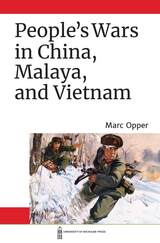 People's Wars in China, Malaya, and Vietnam
Marc Opper
University of Michigan Press, 2020 People’s Wars in China, Malaya, and Vietnam explains why some insurgencies collapse after a military defeat while under other circumstances insurgents are able to maintain influence, rebuild strength, and ultimately defeat the government. The author argues that ultimate victory in civil wars rests on the size of the coalition of social groups established by each side during the conflict. When insurgents establish broad social coalitions (relative to the incumbent), their movement will persist even when military defeats lead to loss of control of territory because they enjoy the support of the civilian population and civilians will not defect to the incumbent. By contrast, when insurgents establish narrow coalitions, civilian compliance is solely a product of coercion. Where insurgents implement such governing strategies, battlefield defeats translate into political defeats and bring about a collapse of the insurgency because civilians defect to the incumbent. The empirical chapters of the book consist of six case studies of the most consequential insurgencies of the 20th century including that led by the Chinese Communist Party from 1927 to 1949, the Malayan Emergency (1948–1960), and the Vietnam War (1960–1975). People’s Wars breaks new ground in systematically analyzing and comparing these three canonical cases of insurgency. The case studies of China and Malaya make use of Chinese-language archival sources, many of which have never before been used and provide an unprecedented level of detail into the workings of successful and unsuccessful insurgencies. The book adopts an interdisciplinary approach and will be of interest to both political scientists and historians.
 The People’s Zion: Southern Africa, the United States, and a Transatlantic Faith-Healing Movement
Joel Cabrita
Harvard University Press, 2018 In The People’s Zion, Joel Cabrita tells the transatlantic story of Southern Africa’s largest popular religious movement, Zionism. It began in Zion City, a utopian community established in 1900 just north of Chicago. The Zionist church, which promoted faith healing, drew tens of thousands of marginalized Americans from across racial and class divides. It also sent missionaries abroad, particularly to Southern Africa, where its uplifting spiritualism and pan-racialism resonated with urban working-class whites and blacks.
Circulated throughout Southern Africa by Zion City’s missionaries and literature, Zionism thrived among white and black workers drawn to Johannesburg by the discovery of gold. As in Chicago, these early devotees of faith healing hoped for a color-blind society in which they could acquire equal status and purpose amid demoralizing social and economic circumstances. Defying segregation and later apartheid, black and white Zionists formed a uniquely cosmopolitan community that played a key role in remaking the racial politics of modern Southern Africa.
Connecting cities, regions, and societies usually considered in isolation, Cabrita shows how Zionists on either side of the Atlantic used the democratic resources of evangelical Christianity to stake out a place of belonging within rapidly-changing societies. In doing so, they laid claim to nothing less than the Kingdom of God. Today, the number of American Zionists is small, but thousands of independent Zionist churches counting millions of members still dot the Southern African landscape.
Pepper, Guns, and Parleys: The Dutch East India Company and China, 1662-1681
John E. Wills Jr.
Harvard University Press, 1974 In 1662 the great sea-lord dynasty of the Cheng family expelled the Dutch from Taiwan, beginning a curious and little-known episode in cross-cultural diplomacy. China's new Manchu-Chinese Ch'ing dynasty and the greatest mercantile-colonial power of the seventeenth century negotiated with each other concerning conditions of trade and terms of military cooperation against their common enemy, the Cheng family. Conflicts between the two negotiating powers are seen as a great deal more than clashes between the Chinese tribute system of diplomacy and the Western "international system." The author's study suggests new perspectives on Chinese diplomatic tradition which may lead to a re-examination of foreign relations across cultural barriers.
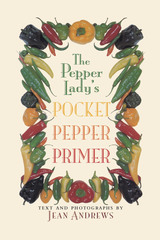 The Pepper Lady's Pocket Pepper Primer
Text and photographs by Jean Andrews
University of Texas Press, 1998 More than a quarter of the people on earth eat peppers every day of their lives, and true pepper lovers are always looking for better-tasting, hotter peppers. This handy, reliable guide makes finding them easy, as capsicum expert Jean Andrews shows you how to identify and use 42 peppers, both fresh and dried, commonly available in North American markets. Andrews describes each pepper in detail, starting with its size, color, fruit shape, flesh, and pungency. She gives its common names, sources, and uses, and indicates other peppers that can substitute for it in recipes. Drawing on her vast store of pepper lore, she also includes notes and anecdotes about each pepper. Her color photographs illustrate all of the peppers. In addition to the species descriptions, Andrews offers practical guidance on selecting and storing, roasting and rehydrating, and growing and harvesting peppers. She explains pepper nomenclature, describes the pungency factor, and notes the significance of color, aroma, flavor, and nutrition.
The Pepys Ballads
Samuel Pepys
Harvard University Press This final volume of our edition of The Pepys Ballads contains many additional notes to the ballads in the first seven volumes; an index of first lines, titles, tunes, and refrains of all the ballads printed and mentioned in the preceding volumes; an index of words, proper names, and subjects. This last index is very full so that anyone working on the history and literature of the sixteenth and seventeenth centuries, is practically sure to find references that will help him.
The Pepys Ballads
Samuel Pepys
Harvard University Press The eighty-six ballads in this sixth volume of The Pepys Ballads begin auspiciously with a jovial health sung by “the merry, loyal boys of Suffolk” after the failure of the Jacobite invasion-plot on January 3, 1691, and end appropriately with a song of triumph on the sanguinary but indecisive battle of Landen on July 19, 1693. Though most of the ballads are of an historical nature, giving a picturesque and an entertaining account of many events of importance at home, in Ireland, and on the Continent, there is no dearth of other subjects, such as prodigies, murders, hangings, and robberies. The result, as before, is a startlingly realistic picture of English life at the close of the seventeenth century.
The Pepys Ballads
Samuel Pepys
Harvard University Press The ninety ballads contained in this installment of Hyder Rollins’s edition of The Pepys Ballads cover the stirring events of the six or seven months after the Glorious Revolution of 1688. As before, the subjects are mainly journalistic and historical. Among the various events we find the arrival of the Princess Mary of Orange at London, the proclaiming and the coronation of William and Mary, the death of Lord Jeffreys, the flight of Father Edward Petre and other Jesuits. Other ballads deal with military affairs in Scotland and Ireland, going into considerable detail about the battle of Killiecrankie and the siege and relief of Londonderry. Full introductory notes and numerous wood-cuts add to the reader’s pleasure.
The Pepys Ballads
Samuel Pepys
Harvard University Press Only brief selections have previously been printed from the great ballad collection of the famous diarist Samuel Pepys, which accordingly is almost unknown except to a few students. In the present edition six volumes will be devoted to a complete reprint, with full explanatory introductions and notes of all the hitherto unprinted topical and historical ballads (1535-1702) in the collection. These first two volumes make accessible all the early ballads (1535-1640) that have not been printed elsewhere, and offer much interesting material to students of English literature, Elizabethan drama, and English history. So far as poetry is concerned, these two volumes have not been equalled by any similar collection of broadside ballads. Among the poets represented are Martin Parker George Wither, Richard Barnfield, William Basse, and Sir Edward Dyer.
The Pepys Ballads
Samuel Pepys
Harvard University Press This new volume in the reprint of The Pepys Ballads has seventy-three ballads covering the more important historical events from the Great Fire of 1666 to the entry of William of Orange into London on December 18, 1688. Among the subjects of the other news-ballads are the Popish and Rye House Plots, the death of Charles II, the coronation of James II, Monmouth’s rebellion, the birth of the Young Pretender, and the flight of the Royal Family. A large number of ballads on criminals in London and the provinces, and several on prodigious happenings, help to throw considerable light on the alleys as well as the main highways of late Stuart England. There are full notes and numerous reproductions of woodcuts.
The Pepys Ballads
Samuel Pepys
Harvard University Press Only brief selections have previously been printed from the great ballad collection of the famous diarist Samuel Pepys, which accordingly is almost unknown except to a few students. In the present edition six volumes will be devoted to a complete reprint, with full explanatory introductions and notes of all the hitherto unprinted topical and historical ballads (1535-1702) in the collection. These first two volumes make accessible all the early ballads (1535-1640) that have not been printed elsewhere, and offer much interesting material to students of English literature, Elizabethan drama, and English history. So far as poetry is concerned, these two volumes have not been equalled by any similar collection of broadside ballads. Among the poets represented are Martin Parker George Wither, Richard Barnfield, William Basse, and Sir Edward Dyer.
A Pepysian Garland: Broadside Ballads of the Years 1595-1639
Hyder Edward Rollins
Harvard University Press, 1971 “Although a scholar's name is usually writ in water,” wrote Herschel Baker in Hyder Edward Rollins: A Bibliography (HUP 1960), “it is unlikely that Hyder Rollins' work will be soon forgotten... In at least three large areas—Elizabethan poetry, the broadside ballad, and the Romantic poets—his erudition was unmatched.” Rollins viewed the broadside ballads as important social documents and he edited many collections of them. “In them,” he wrote, “are clearly reflected the lives and thoughts...of sixteenth and seventeenth century Englishmen. In them history becomes animated.”
This volume, originally published in 1922 and long out of print, was the first edition ever to appear of ballads from Samuel Pepys's important collection. It is now reissued with its twenty-six woodcuts and new, up-to-date information on the music.
The Pequot War
Alfred A. Cave
University of Massachusetts Press, 1996 This book offers the first full-scale analysis of the Pequot War (1636-37), a pivotal event in New England colonial history. Through an innovative rereading of the Puritan sources, Alfred A. Cave refutes claims that settlers acted defensively to counter a Pequot conspiracy to exterminate Europeans. Drawing on archaeological, linguistic, and anthropological evidences to trace the evolution of the conflict, he sheds new light on the motivations of the Pequots and their Indian allies. He also provides a reappraisal of the interaction of ideology and self- interest as motivating factors in the Puritan attack on the Pequots.
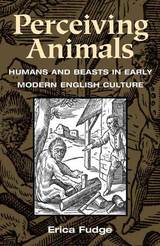 Perceiving Animals: Humans and Beasts in Early Modern English Culture
Erica Fudge
University of Illinois Press, 2000 The boundaries between human and beast forged a rugged philosophical landscape across early modern England. Spectators gathered in London's Bear Garden to watch the callous and brutal baiting of animals. A wave of "new" scientists performed vivisections on live animals to learn more about the human body.
In Perceiving Animals, the British scholar Erica Fudge traces the dangers and problems of anthropocentrism in texts written from 1558 to 1649. Meticulous examinations of scientific, legal, political, literary, and religious writings offer unique and fascinating depictions of human perceptions about the natural world.
Views carried over from bestiaries--medieval treatises on animals--
posited animals as nonsentient beings whose merits were measured solely by what provisions they afforded humans: food, medicine, clothing, travel, labor, scientific knowledge. Without consciences or faith, animals were deemed far inferior to humans.
While writings from the period asserted an enormous biological superiority, Fudge contends actual human behavior and logic worked, sometimes accidentally, to close the alleged gap. In the Bear Garden, even a man of the lowest social rank had power over a tortured animal, sinking him, though, below the beasts. The beast fable itself fails to show a true understanding of animals, as it merely attributes human characteristics to beasts in an attempt to teach humanist ideals. Scholars and writers continually turned to the animal world for reflection. Despite this, scientists of the period used animals for empirical and medical knowledge, recognizing biological and spiritual similarities but refusing to renege human superiority.
Including an insightful reexamination of Ben Jonson's Volpone and fascinating looks at works by Francis Bacon, Edward Coke, and Richard Overton, among others, Fudge probes issues of animal ownership and biological and spiritual superiority in early modern England that resonate with philosophical quandaries still relevant in contemporary society.
Perception, Expression, and History: The Social Phenomenology of Maurice Merleau-Ponty
John O'Neill
Northwestern University Press, 1970 In this commentary, John O'Neill concentrates upon three themes in the goal Merleau-Ponty set for himself, namely "to restore to things their concrete physiognomy, to organisms their individual ways of dealing with the world, and to subjectivity its inherence in history." O'Neill considers the three objectives in their original order: first, the study of animal and human psychology; then, the phenomenology of perception; and finally, certain extensions of these perspectives in the historical and social sciences.
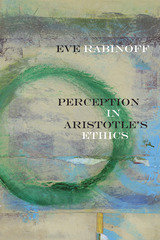 Perception in Aristotle’s Ethics
Eve Rabinoff
Northwestern University Press, 2018 Perception in Aristotle's Ethics seeks to demonstrate that living an ethical life requires a mode of perception that is best called ethical perception. Specifically, drawing primarily on Aristotle’s accounts of perception and ethics in De anima and Nicomachean Ethics, Eve Rabinoff argues that the faculty of perception (aisthesis), which is often thought to be an entirely physical phenomenon, is informed by intellect and has an ethical dimension insofar as it involves the perception of particulars in their ethical significance, as things that are good or bad in themselves and as occasions to act. Further, she contends, virtuous action requires this ethical perception, according to Aristotle, and ethical development consists in the achievement of the harmony of the intellectual and perceptual, rational and nonrational, parts of the soul.
Rabinoff's project is philosophically motivated both by the details of Aristotle’s thought and more generally by an increasing philosophical awareness that the ethical agent is an embodied, situated individual, rather than primarily a disembodied, abstract rational will.
Perception, Theory, and Commitment: The New Philosophy of Science
Harold I. Brown
University of Chicago Press, 1979 With originality and clarity, Harold Brown outlines first the logical
empiricist tradition and then the more historical and process-oriented
approach he calls the “new philosophy of science.” Examining the two
together, he describes the very transition between them as an example
of the kind of change in historical tradition with which the new
philosophy of science concerns itself.
“I would recommend it to every historian of science and to every
philosopher of science. . . . I found it clear, readable, accurate,
cogent, insightful, perceptive, judicious, and full of original
ideas.”
—Maurice A. Finocchiaro, Isis
“The best and most original aspect of the book is its overall
conception.”
—Thomas S. Kuhn
Harold I. Brown is professor of philosophy at Northern Illinois
University.
Perceptions and Behavior in Soviet Foreign Policy
Richard K. Herrmann
University of Pittsburgh Press, 1985 This book discerns Soviet leaders' views of the United States and sees them in relation to foreign policy statements and actions. Hermann first examines the subtle problem of analyzing perceptions and interpreting motives from the words and deeds of national leaders. He then turns to cases, measuring the dominant U.S. hypotheses about the USSR against Soviet behavior in Central Europe, the Middle East, Africa, and Asia, as well as Soviet participation in the arms race. Finally, he weighs his conclusions against a thematic study of speeches and publications by members of the Politburo.
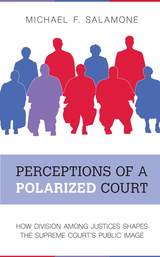 Perceptions of a Polarized Court: How Division among Justices Shapes the Supreme Court's Public Image
Michael F. Salamone
Temple University Press, 2018 Like our divided nation, the Supreme Court is polarized. But does a split among Supreme Court justices—particularly when it occurs along ideological lines—hurt public perception and the Court’s ability to muster popular support for its rulings? Michael Salamone’s Perceptions of a Polarized Court offers the first comprehensive, empirical analysis of how divisiveness affects the legitimacy of the Court’s decisions. Salamone looks specifically at the Roberts Court years—which are characterized by unprecedented ideological and partisan polarization among the justices—to evaluate the public consequences of divided Supreme Court rulings. He also analyzes both the media’s treatment of Supreme Court decisions and public opinion toward the Court’s rulings to show how public acceptance is (or is not) affected. Salmone contends that judicial polarization has had an impact on the manner in which journalists report on the Supreme Court. However, contrary to expectation, Court dissent may help secure public support by tapping into core democratic values.
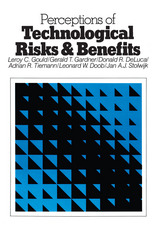 Perceptions of Technological Risks and Benefits
Leroy C. Gould
Russell Sage Foundation, 1988 The election of Ronald Reagan in 1980 was said to herald a new mood of opposition to government regulation. But at the same time, large and vocal segments of the population have been demanding that corporations and regulatory agencies address public concerns about technological safety. What do we really know about people's perceptions of technological risk and their judgments about appropriate levels of technological regulation? Perceptions of Technological Risks and Benefits analyzes the results of a unique body of survey data—the only large-scale, representative survey of public attitudes about risk management in such technologies as nuclear power, handguns, auto travel, and industrial chemicals. The findings demonstrate that public judgments are not simply anti-technological or irrational, but rather the product of a complex set of factors that includes an awareness of benefits as well as a sensitivity to the "qualitative" aspects of risk (how catastrophic, dreaded, or poorly understood a hazard seems to be). This volume offers striking evidence that whatever Americans may think about government regulation in general, they are remarkably consistent in desiring stricter regulation of technological safety. These conclusions suggest that the current trend away from regulation of technology reflects a less than perfect reading of public sentiment.
 Perceptual Acquaintance: From Descartes to Reid
John W. Yolton
University of Minnesota Press, 1984 Perceptual Acquaintance was first published in 1984. Minnesota Archive Editions uses digital technology to make long-unavailable books once again accessible, and are published unaltered from the original University of Minnesota Press editions. Philosophers, wrote Thomas Reid in 1785, "all suppose that we perceive not external objects immediately, and that the immediate objects of perception are only certain shadows of the external objects." To Reid, a founding father of the common-sense school of philosophy, John Locke's "way of ideas" threatened to supplant, in human knowledge, the world of physical objects and events—and to point down the dreaded path to scepticism. John Yolton finds Reid at least partly responsible for this standard (and by now stereotypic) account of Locke and his eighteenth-century British successors on the subject of perception. By carefully examining the writings of Descartes and the Cartesians, and Locke and his successors, Yolton is able to suggest an alternative to this interpretation of their views. He goes back to a wide range of original texts—those of the period's major philosophers, to Descartes' scholastic precursors, to obscure pamphleteers, and to writers on religion, natural philosophy, medicine, and optics—all in an effort to help us understand the issues without the interference of modern labels and categories. The subtle changes over time reveal an important transformation in the understanding of perception, yet one that is prefigured in earlier work, contrary to Reid's view of the past. Included in Yolton's reevaluation is a full account of the role of Berkeley and Hume in the study of perceptual acquaintance, and of the connection between their work.
 Perceptual Neuroscience: The Cerebral Cortex
Vernon B. Mountcastle
Harvard University Press, 1998 The cerebral cortex, occupying over 70 percent of our brain mass, is key to any understanding of the workings--and disorders--of the human brain. offering a comprehensive account of the role of the cerebral cortex in perception, this monumental work by one of the world's greatest living neuroscientists does nothing short of creating a new subdiscipline in the field: perceptual neuroscience.
For this undertaking, Vernon Mountcastle has gathered information from a vast number of sources reaching back through two centuries of investigation into the intrinsic operations of the cortex. His survey includes phylogenetic, comparative, and neuroanatomical studies of the neocortex; studies of the large-scale organization of the neocortex, of neuronal histogenesis and the specification of cortical areas, of synaptic transmission between neurons in cortical microcircuits, and of rhythmicity and synchronization in neocortical networks; and inquiries into the binding problem--how activities among the separate processing nodes of distributed systems coalesce in a coherent activity that we call perception.
The first book to summarize what is known about the physiology of the cortex in perception, Perceptual Neuroscience will be a landmark in the literature of neuroscience.
 Percival Lowell: The Culture and Science of a Boston Brahmin
David Strauss
Harvard University Press, 2001 This engaging and wide-ranging biography casts new light on the life and careers of Percival Lowell. Scion of a wealthy Boston family, elder brother of Harvard President Lawrence and poet Amy, Percival Lowell is best remembered as the astronomer who claimed that intelligent beings had built a network of canals on Mars. But the Lowell who emerges in David Strauss's finely textured portrait was a polymath: not just a self-taught astronomer, but a shrewd investor, skilled photographer, inspired public speaker, and adventure-travel writer whose popular books contributed to an awakening American interest in Japan.
Strauss shows that Lowell consistently followed the same intellectual agenda. One of the principal American disciples of Herbert Spencer, Lowell, in his investigations of Japanese culture, set out to confirm Spencer's notion that Westerners were the highest expression of the evolutionary process. In his brilliant defense of the canals on Mars, Lowell drew on Spencer's claim that planets would develop life-supporting atmospheres over time.
Strauss's charming, somewhat bittersweet tale is the story of a rebellious Boston Brahmin whose outsider mentality, deep commitment to personal freedom, and competence in two cultures all contributed to the very special character of his careers, first as a cultural analyst and then more memorably as an astronomer.
Percussing the Thinking Jar
Maw Shein Win
Omnidawn, 2024 A collection of dreamlike poetry, accompanied by ink drawings, reflecting on the experiences of living in an aging body.
With her latest collection, Maw Shein Win deftly braids together the pleasures, pains, and anxieties of living in an aging body, revealing how a mind can log thoughts and observations. Win employs new poetic forms to invite her readers into realms that are both deeply personal and universal, rendered with dreamlike imagery and surprising humor. Reflecting on our strange times and the atmospheric undercurrents of chaos and disintegration, Percussing the Thinking Jar is a hypnotic book and invites the reader into conversation with their own vulnerability and resilience. Throughout the book, sumi ink drawings by artist Mark Dutcher echo the rhythms of Win’s poetry.
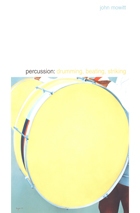 Percussion: Drumming, Beating, Striking
John Mowitt
Duke University Press, 2002 Percussion is an attempt—in the author’s words—to make sense of "senseless beating," to grasp how rhythm makes sense in music and society. Both a scholar and a former professional drummer, John Mowitt forges a striking encounter between cultural studies and new musicology that seeks to lay out the "percussive field" through which beating—specifically the backbeat that defines early rock-and-roll—comes to matter for raced, urban subjects.
For Mowitt, percussion is both an experience of embodiment—making contact in and on the skin—and a provocation for critical theory itself. In delimiting the percussive field, he plays drumming off against the musicological account of the beat, the sociological account of shock and the psychoanalytical account of fantasy. In the process he touches on such topics as the separation of slaves and drums in the era of the slave trade, the migration of rural blacks to urban centers of the North, the practice and politics of "rough music," the links between interpellation and possession, the general strike, beating fantasies, and the concept of the "skin ego."
Percussion makes a fresh and provocative contribution to cultural studies, new musicology, the history of the body and critical race theory. It will be of interest to students of cultural studies and critical theory as well as readers with a serious interest in the history of music, rock-and-roll and drumming.
 Percy Bysshe Shelley: Poet and Revolutionary
Jaqueline Mulhallen
Pluto Press, 2015 Today, Percy Bysshe Shelley is an emblem of the Romantic movement and one of the lights of English culture—his poems memorized by schoolchildren, his life honored with a memorial in Westminster Abbey’s Poets’ Corner. That wasn’t always the case, however. In his own day, Shelley was widely loathed, seen as an immoral atheist and a traitor to his class for his revolutionary politics. His work was damned as well, receiving scathing reviews rooted as much in disapproval of his politics and personal life as in the verse itself. That’s the Shelley that Jacqueline Mulhallen brings to life in this accessible, political biography: the Shelley who, though writing when the working class was in its infancy, clearly grasped—and wanted to change—the system of oppression under which laborers and women lived. The revolutionary Shelley, Mulhallen shows, has long served as an inspiration to figures from Karl Marx to W. B. Yeats to the poets and writers of today, and for popular movements like the Chartists and the suffragettes, even as his public image and poetry became part of the establishment.
An engaging look at one of English history and literature’s most compelling, complicated, and talented figures, Percy Bysshe Shelley will be a valuable contribution to our understanding of the man and his work.
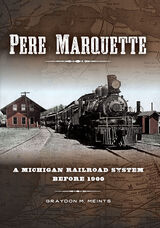 Pere Marquette: A Michigan Railroad System before 1900
Graydon M. Meints
Michigan State University Press, 2020 The Pere Marquette Railroad has not one but two histories—one for the twentieth century and one for the nineteenth. While the twentieth-century record of the Pere Marquette Railroad has been well studied and preserved, the nineteenth century has not been so well served. This volume aims to correct that oversight by focusing on the nineteenth-century part of the company’s past, including the men who formed and directed these early roads, and the development of the system. The Pere Marquette Railroad was formed in 1900 by a merger of three Michigan railroad companies and lasted forty-seven years, disappearing in June 1947 by merger into the maw of the Chesapeake & Ohio Railroad. Prior to the 1900 merger, the Pere Marquette Railroad’s predecessors made up a motley collection of disconnected and unaffiliated short, local rail lines. After the financial panic of 1893, and with some commonality of ownership, the companies worked together more closely. Before the end of the decade, the three main railroads—the Flint & Pere Marquette; the Detroit, Lansing & Northern; and the Chicago & West Michigan—had decided that the only way to maintain solvency was to merge. Using a plethora of primary sources including railway timetables and maps, this work lends insight into the little-known corporate business history of the Pere Marquette Railroad.
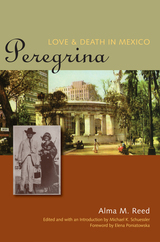 Peregrina: Love and Death in Mexico
By Alma M. Reed
University of Texas Press, 2007 In the Yucatán, they never forgot Alma Reed. She arrived for the first time in 1923, on assignment for the New York Times Sunday Magazine to cover an archaeological survey of Mayan ruins. It was a contemporary Maya, however, who stole her heart. Felipe Carrillo Puerto, said to be descended from Mayan kings, had recently been elected governor of the Yucatán on a platform emphasizing egalitarian reforms and indigenous rights. The entrenched aristocracy was enraged; Reed was infatuated—as was Carrillo Puerto. He and Reed were engaged within months. Yet less than a year later—only eleven days before their intended wedding—Carrillo Puerto was assassinated. He had earned his place in the history books, but Reed had won a place in the hearts of Mexicans: the bolero "La Peregrina" remains one of the Yucatán's most famous ballads. Alma Reed recovered from her tragic romance to lead a long, successful life. She eventually returned to Mexico, where her work in journalism, archaeology, and art earned her entry into the Orden del Aguila Azteca (Order of the Aztec Eagle). Her time with Carrillo Puerto, however, was the most intense of her life, and when she was encouraged (by Hollywood, especially) to write her autobiography, she began with that special period. Her manuscript, which disappeared immediately after her sudden death in 1966, mingled her legendary love affair with a biography of Carrillo Puerto and the political history of the Yucatán. As such, it has long been sought by scholars as well as romantics. In 2001, historian Michael Schuessler discovered the manuscript in an abandoned apartment in Mexico City. An absolutely compelling memoir, Peregrina restores Reed's place in Mexican history in her own words.
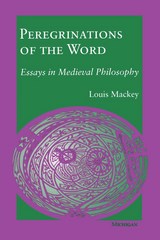 Peregrinations of the Word
Louis Mackey
University of Michigan Press, 1997 One of the besetting problems of the present age is the conflict between criticism and commitment. Those who hold strong convictions fear that rational criticism may corrode the moral and religious foundations of society. Advocates of rational critique tend to perceive people with strong convictions as fanatics. The Middles Ages was likewise a time when people were both deeply committed and relentlessly rational. In Peregrinations of the Word, Louis Mackey examines the way important medieval thinkers dealt with the relation of faith and reason, in the hope that their example may assist contemporary society in harmonizing belief and critical vigilance.
Peregrinations of the Word consists of essays on five medieval philosophers: Augustine, Anselm, Aquinas, Bonaventure, and Duns Scotus. An essay on the tension between autobiography and theology in Augustine's Confessions is followed by a commentary on the dialogue of faith and reason in his On the Teacher. A third essay shows how Anselm's Proslogion both constructs and deconstructs the ontological proof of God's existence. There is a discussion of Bonaventure's staging of the opposition between Aristotle and the scriptures in terms of the respective languages. Finally there is an examination of the ways Duns Scotus's distinctive positions on the Incarnation, the Immaculate Conception, and the Eucharist shape his philosophical views.
Though each of these essays is an independent study, they have as a common theme the relation between faith and reason as understood in the Middle Ages; e.g., the conflict between the hermeneutic of reason and that of revelation in the construction of self; the dialectic of philosophical demonstration and devotional submission required of all discourse about God; and the resources available to medieval theology for resolving the conflict of nominalism and realism. Mackey maintains that medieval philosophy can only be understood in its theological and scriptural milieu. He has argued this point by showing how that milieu enabled these five thinkers to deal with a variety of philosophical issues. He concludes persuasively that religious beliefs and exegetical concerns did not shackle the medieval mind but rather liberated it and empowered it.
Louis Mackey is Professor of Philosophy, University of Texas at Austin.
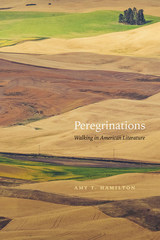 Peregrinations: Walking in American Literature
Amy T Hamilton
University of Nevada Press, 2018 Peregrinate: To travel or wander around from place to place.
The land of the United States is defined by vast distances encouraging human movement and migration on a grand scale. Consequently, American stories are filled with descriptions of human bodies walking through the land.
In Peregrinations, Amy T. Hamilton examines stories told by and about Indigenous American, Euroamerican, and Mexican walkers. Walking as a central experience that ties these texts together—never simply a metaphor or allegory—offers storytellers and authors an elastic figure through which to engage diverse cultural practices and beliefs including Puritan and Catholic teachings, Diné and Anishinaabe oral traditions, Chicanx histories, and European literary traditions.
Hamilton argues that walking bodies alert readers to the ways the physical world—more-than-human animals, trees, rocks, wind, sunlight, and human bodies—has a hand in creating experience and meaning. Through material ecocriticism, a reading practice attentive to historical and ongoing oppressions, exclusions, and displacements, she reveals complex layerings of narrative and materiality in stories of walking human bodies.
This powerful and pioneering methodology for understanding place and identity, clarifies the wide variety of American stories about human relationships with the land and the ethical implications of the embeddedness of humans in the more-than-human world.
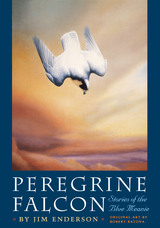 Peregrine Falcon: Stories of the Blue Meanie
By James H. Enderson
University of Texas Press, 2005 A superb success as a bird, combining great speed, aeronautical grace, and fearlessness...inhabitant of wild places, inaccessible cliffs, and skyscrapers...worldwide dweller, trans-equatorial migrant, and docile captive—the peregrine falcon stands alone among all others of its kind. Perhaps this is why so many varied people rushed to its aid when it faced decimation by pesticide poisoning. In this personal and highly entertaining memoir, Jim Enderson tells stories of a lifetime spent studying, training, breeding, and simply enjoying peregrine falcons. He recalls how his boyhood interest in raptors grew into an ornithological career in which he became one of the leading experts who helped identity DDT as the cause of the peregrine falcon's sudden and massive decline across the United States. His stories reveal both the dedication that he and fellow researchers brought to the task of studying and restoring the peregrine and the hair-raising adventures that sometimes befell them along the way. Enderson also seamlessly weaves in the biology and natural history of the peregrine, as well as anecdotes about its traditional and widespread use in falconry as an aggressive yet tractable hunter, to offer a broad portrait of this splendid and intriguing falcon.
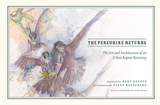 The Peregrine Returns: The Art and Architecture of an Urban Raptor Recovery
Mary Hennen with Peggy Macnamara
University of Chicago Press, 2017 Peregrine falcons have their share of claims to fame. With a diving speed of over two hundred miles per hour, these birds of prey are the fastest animals on earth or in the sky, and they are now well known for adapting from life on rocky cliffs to a different kind of mountain: modern skyscrapers. But adaptability only helps so much. In 1951, there were no peregrines left in Illinois, for instance, and it looked as if the species would be wiped out entirely in North America. Today, however, peregrines are flourishing.
In The Peregrine Returns, Mary Hennen gives wings to this extraordinary conservation success story. Drawing on the beautiful watercolors of Field Museum artist-in-residence Peggy Macnamara and photos by Field Museum research assistant Stephanie Ware, as well as her own decades of work with peregrines, Hennen uses a program in Chicago as a case study for the peregrines’ journey from their devastating decline to the discovery of its cause (a thinning of eggshells caused by a by-product of DDT), through to recovery, revealing how the urban landscape has played an essential role in enabling falcons to return to the wild—and how people are now learning to live in close proximity to these captivating raptors.
Both a model for conservation programs across the country and an eye-opening look at the many creatures with which we share our homes, this richly illustrated story is an inspiring example of how urban architecture can serve not only our cities’ human inhabitants, but also their wild ones.
 Perennial Ceremony: Lessons and Gifts from a Dakota Garden
Teresa Peterson
University of Minnesota Press, 2024 Travel through a garden’s seasons toward healing, reclamation, and wholeness—for us, and for our beloved relative, the Earth In this rich collection of prose, poetry, and recipes, Teresa Peterson shares how she found refuge from the struggle to reconcile her Christianity and Dakota spirituality, discovering solace and ceremony in communing with the earth. Observing and embracing the cycles of her garden, she awakens to the constant affirmation that healing and wellness can be attained through a deep relationship with land, plants, and waters. Dakota people call this way of seeing and being in the world mitakuye owasin: all my relations. Perennial Ceremony brings us into this relationship, as Peterson guides us through the Dakota seasons to impart lessons from her life as a gardener, gatherer, and lover of the land. We see the awakening of Wetu (spring), a transitional time when nature comes alive and sweet sap flows from maples, and the imperfect splendor of Bdoketu (summer), when rain becomes a needed and nourishing gift. We share in the harvesting wisdom of Ptaŋyetu (fall), a time to savor daylight and reap the garden’s abundance, and the restorative solitude of Waniyetu (winter), when snow blankets the landscape and sharpens every sound. Through it all, Peterson walks with us along the path that both divides and joins Christian doctrine, everyday spiritual experience, and the healing powers of Indigenous wisdom and spirituality. In this intimate seasonal cycle, we learn how the garden becomes a healing balm. Peterson teaches us how ceremony may be found there: how in the vegetables and flowers, the woods, the hillsides, the river valley—even in the feeding of friends and family—we can reclaim and honor our relationship with Mother Earth. She encourages us to bring perennial ceremony into our own lives, inviting us on a journey that brings us full circle to makoce kiŋ mitakuye: the land is my relative.
 Perennial Fall
Maggie Dietz
University of Chicago Press, 2006 At the heart of this unusually accomplished and affecting first book of poetry is the idea of the hinge—the point of connection, of openings and closings. Maggie Dietz situates herself in the liminal present, bringing together past and future, dream and waking, death and life. Formally exact, rigorous, and tough, these poems accept no easy answers or equations.
Dietz creates a world alive with detail and populated with the everyday and strange: amusement-park horses named Virgil and Sisyphus, squirrels hanging over tree branches “like fish.” By turns humorous and pained, direct and mysterious, elegiac and elegant, the poems trace for us the journey and persistence of the spirit toward and through its “perennial fall”—both the season and the human condition. Cumulatively, the work moves toward a fragile transcendence, surrendering to difficulty, splendor, and strangeness.
“In Perennial Fall, distinct, hard-edged images create a haunting counter-play of distortion, troubled insight or menace. The simultaneous clarity and shadow has the quality of a dream that can be neither forgotten nor settled. This is a spectacular debut and more than that—a wonderful book.”—Robert Pinsky
 Perennial Gardens for Texas
By Julie Ryan
University of Texas Press, 1998 A perennial garden is an ever-changing source of delight. Each season brings new colors and textures in flowers and foliage. As the years go by, perennial plantings mature and interweave into forms more beautiful and surprising than a season's growth of annuals can ever give. Best of all, a perennial garden can grow almost anywhere with plants suited to local soils, temperatures, and rainfall. This book is a complete guide to perennial gardening in Texas and similar regions of eastern New Mexico, Oklahoma, Arkansas, Louisiana, Mississippi, Alabama, Georgia, Florida, and the Carolinas. In Part One, Julie Ryan offers a historical sketch of cottage gardens and perennial borders, with a sampler of some of their modern variations. In Part Two, she defines the major ecological regions of Texas and, with words and color photographs, takes you on a tour of lovely public and private gardens in each region. You'll find all the "how to" information for creating your own garden in Part Three. Ms. Ryan describes and pictures over 300 flowering perennials, bulbs, foliage plants, and old roses suitable for Texas gardens, with lists of companion annuals, vines, shrubs, and small trees. Accompanying charts provide quick reference to each plant's preferred regions and cultivation requirements. In addition, Ms. Ryan discusses how to design a garden and select plants, prepare the beds, and deal with garden pests. She concludes with substantial lists of resources, including mail-order suppliers of perennials, bulbs, and old roses.
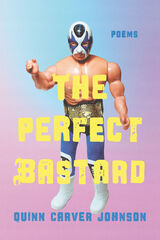 The Perfect Bastard: Poems
Quinn Carver Johnson
Northwestern University Press, 2023 Winner of the 2024 LAMBDA Literary Award in LGBTQ+ Poetry
An innovative poetic interrogation of wrestling, queerness, and staying true to oneself
Quinn Carver Johnson’s debut collection, The Perfect Bastard, follows its titular protagonist, a nonbinary and queer professional wrestler, as they travel across Kansas, Oklahoma, Arkansas, and Missouri, working for a booker known as the Puppeteer. Inspired by their idol Adrian Street, the Perfect Bastard strives to positively represent queerness and resist the Puppeteer’s stereotypical and demeaning kayfabe. In the ring, they face off against the likes of champion Jack Holiday and the First Crusher, but their most important battles, against the Puppeteer, take place behind the scenes. They must choose between person and persona, authenticity and humiliating hype, if they want to succeed in the industry.
When offered success on the grandest scale—the championship belt—in exchange for mocking their own queerness, the Perfect Bastard questions their path: Will they betray their identity to achieve their dream, or will they walk away from the world of professional wrestling—a world that refuses to make a genuine, healthy space for them?
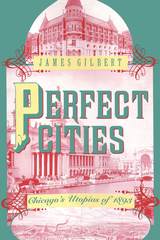 Perfect Cities: Chicago's Utopias of 1893
James Gilbert
University of Chicago Press, 1991 In this elegant and sensitive look at the milieu of the World's Columbian Exposition of 1893, James Gilbert examines the three utopias that were designed to bring order to the chaos of urban life: The World's Fair itself, George Pullman's community for his workers, and Dwight Moody's evangelical crusade. Gilbert draws upon a rich selection of fiction, collective biography, architecture, photographs, and souvenir books to show how these experiments each acted as a middle-class prescription for coming to terms with the new cultural diversity and competition resulting from the disruptive forces of technological change, commercial enterprise, and pluralism.
"Mr. Gilbert's splendid book opens the door on a conflicted past, and provides an indispensable perspective on the troubled and troubling struggle we face today between old and new, unity and diversity."—Alan Trachtenberg, New York Times
"Perfect Cities is a remarkable account of a struggle for cultural definition. Chronicling the byplay between cultural homogeneity and heterogeneity, unity and diversity, James Gilbert not only throws light on Chicago's past but also provides insight that can be applied to the cultural debates of our own time."—Adria Bernardi, Chicago Tribune
"What Gilbert has done is to enable the reader to experience the grand utopian visions of the times, yet at the same time see the cantankerous reality that made the visions impossible."—Henry Kisor, Chicago Sun-Times
 Perfect Copies: Reproduction and the Contemporary Comic
Shiamin Kwa
Rutgers University Press, 2023 Analyzing the way that recent works of graphic narrative use the comics form to engage with the “problem” of reproduction, Shiamin Kwa’s Perfect Copies reminds us that the mode of production and the manner in which we perceive comics are often quite similar to the stories they tell. Perfect Copies considers the dual notions of reproduction, mechanical as well as biological, and explores how comics are works of reproduction that embed questions about the nature of reproduction itself. Through close readings of the comics My Favorite Thing Is Monsters by Emil Ferris, The Black Project by Gareth Brookes, The Generous Bosom series by Conor Stechschulte, Sabrina by Nick Drnaso, and Panther by Brecht Evens, Perfect Copies shows how these comics makers push the limits of different ideas of “reproduction” in strikingly different ways. Kwa suggests that reading and thinking about books like these, that push us to engage with these complicated questions, teaches us how to become better readers.
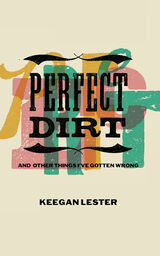 Perfect Dirt: And Other Things I've Gotten Wrong
Keegan Lester
West Virginia University Press, 2021 Recounted with humor and honesty, Lester invites us into his life as he struggles with masculinity and searches for a place where he fits. Words have meaning and meaning evolves over time. In Perfect Dirt, Keegan Lester drags us through his failure to grasp the meaning that always seems to be just beyond his fingertips. These lyrical vignettes depict a lifelong search for home, identity, and the language to say the things we wish we could tell people in the moment. Born in Southern California to parents who had migrated from West Virginia and South Florida, Lester spent summers with his grandparents in Morgantown, which instilled a deep anchor of place that continued to call to him, an Appalachian at heart even while living in New York City as a poet. As small successes started to come his way—a book and numerous tours—so did crises. Lester’s father, meanwhile, experiencing his own life crisis, embarked on a journey to sail the Caribbean. Both end up lost. Part memoir, part tour diary, part homage to the places and people who have made him who he is, Perfect Dirt digs into the sometimes painful, sometimes jubilant questions of identity and success. This is a book searching to better understand the world and our place in it, the family we’re born into, and the family we make along the way. Hear the author read an excerpt from the Perfect Dirt.
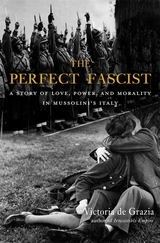 The Perfect Fascist: A Story of Love, Power, and Morality in Mussolini’s Italy
Victoria de Grazia
Harvard University Press, 2020 A New Statesman Book of the Year
Winner of the Helen and Howard R. Marraro Prize
Winner of the Aldo and Jeanne Scaglione Prize for Italian Studies
“Extraordinary…I could not put it down.”
—Margaret MacMillan
“Reveals how ideology corrupts the truth, how untrammeled ambition destroys the soul, and how the vanity of white male supremacy distorts emotion, making even love a matter of state.”
—Sonia Purnell, author of A Woman of No Importance
When Attilio Teruzzi, a decorated military officer and early convert to the Fascist cause, married a rising American opera star, his good fortune seemed settled. The wedding was blessed by Mussolini himself. Yet only three years later, Teruzzi, now commander of the Black Shirts, renounced his wife. Lilliana was Jewish, and fascist Italy would soon introduce its first race laws.
The Perfect Fascist pivots from the intimate story of a tempestuous courtship and inconvenient marriage to the operatic spectacle of Mussolini’s rise and fall. It invites us to see in the vain, unscrupulous, fanatically loyal Attilio Teruzzi an exemplar of fascism’s New Man. Victoria De Grazia’s landmark history shows how the personal was always political in the fascist quest for manhood and power. In his self-serving pieties and intimate betrayals, his violence and opportunism, Teruzzi is a forefather of the illiberal politicians of today.
“The brilliance of de Grazia’s book lies in the way that she has made a page-turner of Teruzzi’s chaotic life, while providing a scholarly and engrossing portrait of the two decades of Fascist rule.”
—Caroline Moorhead, Wall Street Journal
“Original and important…A probing analysis of the fascist ‘strong man.’ De Grazia’s attention to Teruzzi’s private life, his behavior as suitor and husband, deepens and enriches our understanding of the nature of leadership in Mussolini’s regime and of masculinity, virility, and honor in Italian fascist culture.”
—Robert O. Paxton, author of The Anatomy of Fascism
“This is a perfect book!…Its two entwined narratives—one political and public, the other personal and private—help us understand why the personal is political for those who insist on reshaping people and society.”
—Azar Nafisi, author of Reading Lolita in Tehran
 The Perfect Fit: Creative Work in the Global Shoe Industry
Claudio E. Benzecry
University of Chicago Press, 2022 The Perfect Fit shows us how globalization works through the many people and places involved in making women’s shoes.
We know a lot about how clothing and shoes are made cheaply, but very little about the process when they are made beautifully. In The Perfect Fit, Claudio E. Benzecry looks at the craft that goes into designing shoes for women in the US market, revealing that this creative process takes place on a global scale. Based on unprecedented behind-the-scenes access, The Perfect Fit offers an ethnographic window into the day-to-day life of designers, fit models, and technicians as they put together samples and prototypes, showing how expert work is a complement to and a necessary condition for factory exploitation.
Benzecry looks at the decisions and constraints behind how shoes are designed and developed, from initial inspiration to the mundane work of making sure a size seven stays constant. In doing so, he also fosters an original understanding of how globalization works from the ground up. Drawing on five years of research in New York, China, and Brazil, The Perfect Fit reveals how creative decisions are made, the kinds of expertise involved, and the almost impossible task of keeping the global supply chain humming.
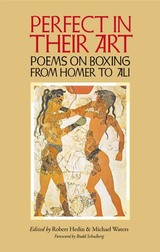 Perfect in Their Art: Poems on Boxing from Homer to Ali
Edited by Robert Hedin and Michael Waters. Foreword by Budd Schulberg
Southern Illinois University Press, 2003 Two combatants, one ring, and a battle governed as much by determination and drive as by rules and referees: that’s boxing. Perfect in Their Art: Poems on Boxing from Homer to Ali spans the millennia to present more than one hundred of the finest in pugilism poetry from both oral and written traditions, celebrating the lasting literary, historical, and cultural significance of boxing’s storied heritage. Editors Robert Hedin and Michael Waters pulled no punches in assembling the definitive poems and poets of the sport. Works by such classical poets as Homer, Virgil, and Pindar are gathered here side-by-side for the first time with the poems of Lord Byron, William Makepeace Thackeray, and Sir Arthur Conan Doyle. This provocative collection also features more recent literary heavyweights, including Langston Hughes, Maya Angelou, Joyce Carol Oates, Philip Levine, Wislawa Szymborska, Ai, Yusef Komunyakaa, James Merrill, and Norman Mailer. Equally impressive is this anthology’s rich sampling of boxing music, including ballads, blues, marches, waltzes, and pop lyrics. Irving Berlin, Memphis Minnie, Leadbelly, Paul Simon, Warren Zevon, and Bob Dylan are only a few of the songwriters in this volume compelled to honor the sweet science. Complemented by a foreword from On the Waterfront author Budd Schulberg, Perfect in Their Art offers glimpses into the boxing ring’s literal and metaphoric place as a popular stage for brutal but artful combat. Together these poems celebrate the heroes and traditions of this most primal competition across its many eras to provide an accurate, graceful, and spirited evocation of boxing’s cultural legacy as both sport and art.
The Perfect Life: Lyric Essays
Peter Stitt
Tupelo Press, 2013 Poet and essayist Peter Stitt describes not a perfect life achieved, but his search for that ideal, writing of books he has loved and of the often difficult lives of writers, including his teachers John Berryman and James Wright. Generous and alert in his fascinations, Stitt explores the quest for freedom in thought and action among the Amish, the French partisans, and the “heretical” Cathars, and he offers a fresh perspective on parenting, meditating on the life of an adopted stepdaughter.
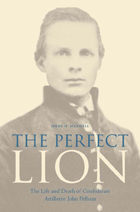 The Perfect Lion: The Life and Death of Confederate Artillerist John Pelham
Jerry H. Maxwell
University of Alabama Press, 2011 The South has made much of J. E. B. Stuart and Stonewall Jackson, but no individual has had a greater elevation to divine status than John Pelham, remembered as the “Gallant Pelham.” An Alabama native, Pelham left West Point for service in the Confederacy and distinguished himself as an artillery commander in Robert E. Lee’s Army of Northern Virginia. Lee is reported to have said of him, “It is glorious to see such courage in one so young!” Blond, blue-eyed, and handsome, Pelham’s modest demeanor charmed his contemporaries, and he was famously attractive to women. He was killed in action at the battle of Kelly’s Ford in March of 1863, at twenty-four years of age, and reportedly three young women of his acquaintance donned mourning at the loss of the South’s “beau ideal.” Maxwell’s work provides the first deeply researched biography of Pelham, perhaps Alabama’s most notable Civil War figure, and explains his enduring attraction.
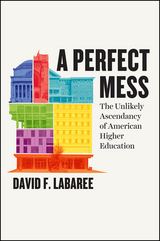 A Perfect Mess: The Unlikely Ascendancy of American Higher Education
David F. Labaree
University of Chicago Press, 2017 Read the news about America’s colleges and universities—rising student debt, affirmative action debates, and conflicts between faculty and administrators—and it’s clear that higher education in this country is a total mess. But as David F. Labaree reminds us in this book, it’s always been that way. And that’s exactly why it has become the most successful and sought-after source of learning in the world. Detailing American higher education’s unusual struggle for survival in a free market that never guaranteed its place in society—a fact that seemed to doom it in its early days in the nineteenth century—he tells a lively story of the entrepreneurial spirit that drove American higher education to become the best.
And the best it is: today America’s universities and colleges produce the most scholarship, earn the most Nobel prizes, hold the largest endowments, and attract the most esteemed students and scholars from around the world. But this was not an inevitability. Weakly funded by the state, American schools in their early years had to rely on student tuition and alumni donations in order to survive. This gave them tremendous autonomy to seek out sources of financial support and pursue unconventional opportunities to ensure their success. As Labaree shows, by striving as much as possible to meet social needs and fulfill individual ambitions, they developed a broad base of political and financial support that, grounded by large undergraduate programs, allowed for the most cutting-edge research and advanced graduate study ever conducted. As a result, American higher education eventually managed to combine a unique mix of the populist, the practical, and the elite in a single complex system.
The answers to today’s problems in higher education are not easy, but as this book shows, they shouldn’t be: no single person or institution can determine higher education’s future. It is something that faculty, administrators, and students—adapting to society’s needs—will determine together, just as they have always done.
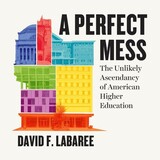 A Perfect Mess: The Unlikely Ascendancy of American Higher Education
David F. Labaree
University of Chicago Press, 2017 This is an auto-narrated audiobook edition of this book.
Read the news about America’s colleges and universities—rising student debt, affirmative action debates, and conflicts between faculty and administrators—and it’s clear that higher education in this country is a total mess. But as David F. Labaree reminds us in this book, it’s always been that way. And that’s exactly why it has become the most successful and sought-after source of learning in the world. Detailing American higher education’s unusual struggle for survival in a free market that never guaranteed its place in society—a fact that seemed to doom it in its early days in the nineteenth century—he tells a lively story of the entrepreneurial spirit that drove American higher education to become the best.
And the best it is: today America’s universities and colleges produce the most scholarship, earn the most Nobel prizes, hold the largest endowments, and attract the most esteemed students and scholars from around the world. But this was not an inevitability. Weakly funded by the state, American schools in their early years had to rely on student tuition and alumni donations in order to survive. This gave them tremendous autonomy to seek out sources of financial support and pursue unconventional opportunities to ensure their success. As Labaree shows, by striving as much as possible to meet social needs and fulfill individual ambitions, they developed a broad base of political and financial support that, grounded by large undergraduate programs, allowed for the most cutting-edge research and advanced graduate study ever conducted. As a result, American higher education eventually managed to combine a unique mix of the populist, the practical, and the elite in a single complex system.
The answers to today’s problems in higher education are not easy, but as this book shows, they shouldn’t be: no single person or institution can determine higher education’s future. It is something that faculty, administrators, and students—adapting to society’s needs—will determine together, just as they have always done.
 Perfect Motherhood: Science and Childrearing in America
Apple, Rima
Rutgers University Press, 2006 Parenting today is virtually synonymous with worry. We want to ensure that our children are healthy, that they get a good education, and that they grow up to be able to cope with the challenges of modern life. In our anxiety, we are keenly aware of our inability to know what is best for our children. When should we toilet train? What is the best way to encourage a fussy child to eat? How should we protect our children from disease and injury? Before the nineteenth century, maternal instinct—a mother’s “natural know-how”—was considered the only tool necessary for effective childrearing. Over the past two hundred years, however, science has entered the realm of motherhood in increasingly significant ways. In Perfect Motherhood, Rima D. Apple shows how the growing belief that mothers need to be savvy about the latest scientific directives has shifted the role of expert away from the mother and toward the professional establishment. Apple, however, argues that most women today are finding ways to negotiate among the abundance of scientific recommendations, their own knowledge, and the reality of their daily lives.
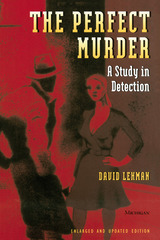 The Perfect Murder: A Study in Detection
David Lehman
University of Michigan Press, 2000 In this lively, enjoyable look at the best American and British detective fiction, David Lehman investigates the mystery of mysteries: the profound satisfactions we get from evil, disorder, mayhem, and deception--that we know will be put right by the last page.
As Lehman shows, the detective story draws deeply from ancient storytelling traditions. The mystery's conventions--the locked room, the clue "hidden" in plain sight, the diabolical double, the villainous least likely subject--work on us as childhood fairy tales do; they prey upon our darkest fears, taking us to the brink of the unbearable before restoring a comforting sense of order. The myth of Oedipus, for example, contains the essential elements of a whodunit, with the twist that the murderer the detective pursues is himself.
With their wisecracking gumshoe heroes, Dashiell Hammett and Raymond Chandler fashioned an existential romance out of the detective novel. More recent writers such as Ross MacDonald, P. D. James, and Ruth Rendell have raised the genre to a new level of psychological sophistication. Yet the form evolves still, and Lehman guides us to the epistemological riddles of Jorge Luis Borges and Umberto Eco, who challenge the notion of a knowable truth. Originally published in 1989, this new edition features an additional chapter on the mystery novels of the 1990s.
"A lively study of the development and varieties of the detective story since Poe, its relations with other forms high and low, and the latter-day appropriation of its techniques by such writers as Borges and Eco. . . . A thoroughly intelligent and readable book." --Richard Wilbur, Pulitzer-Prize winning poet
David Lehman is the series editor of both the The Best American Poetry, published by Scribner, and the Poets on Poetry series published by the University of Michigan Press. He is a former Guggenheim Fellow in poetry, a vice president of the National Book Critics Circle, and the author of several books of criticism and collections of poems.
A Perfect Picture Of Hell: Eyewitness Accounts By Civil War Prisoners From 12Th Io
Ted Genoways
University of Iowa Press, 2000 From the shooting of an unarmed prisoner at Montgomery, Alabama, to a successful escape from Belle Isle, from the swelling floodwaters overtaking Cahaba Prison to the inferno that finally engulfed Andersonville, A Perfect Picture of Hell is a collection of harrowing narratives by soldiers from the 12th Iowa Infantry who survived imprisonment in the South during the Civil War.
Editors Ted Genoways and Hugh Genoways have collected the soldiers' startling accounts from diaries, letters, speeches, newspaper articles, and remembrances. Arranged chronologically, the eyewitness descriptions of the battles of Shiloh, Corinth, Jackson, and Tupelo, together with accompanying accounts of nearly every famous Confederate prison, create a shared vision
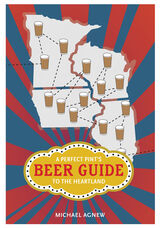 A Perfect Pint's Beer Guide to the Heartland
Michael Agnew
University of Illinois Press, 2014 Once dominated by megabreweries like Miller and G. Heilemann, the Midwest has in recent years become home to a dynamic craft beer industry at the core of America's current brewing renaissance. Beer writer and Certified Cicerone® Michael Agnew crisscrossed Illinois, Iowa, Minnesota, and Wisconsin sampling the astonishing variety of beers on offer at breweries and brewpubs. The result is a region-wide survey of the Midwestern craft beer scene. Packed with details on more than 200 breweries, A Perfect Pint's Beer Guide to the Heartland offers actual and armchair travelers alike a handbook that includes: - Agnew's exclusive choices on which beers to try at each location
- Entries on every brewery's history and philosophy
- Information on tours, tasting rooms and attached pubs, and dining options and other amenities
- A survey of each brewery's brands, including its flagship beer plus seasonal brews and special releases
- Brewery equipment and capacity
- Nearby attractions
In addition, Agnew sets the stage with a history of Midwestern beer spanning the origins of the immigrant brewers who arrived in the 1800s to the homebrewers-made-good who have built a new kind of brewing culture founded on creativity, dedication to quality, and attention to customer feedback. Informed and unique, A Perfect Pint's Beer Guide to the Heartland is the essential companion for beer aficionados and curious others determined to drink the best the Midwest has to offer. Includes more than 150 full color images, including the region's most distinctive beer labels, trademarks, and company logos.
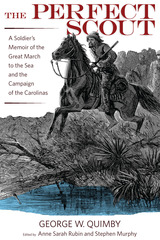 The Perfect Scout: A Soldier’s Memoir of the Great March to the Sea and the Campaign of the Carolinas
George W. Quimby, edited by Anne Sarah Rubin and Stephen Murphy
University of Alabama Press, 2018 A rare and dramatic first-person account by a Union scout who served General William Tecumseh Sherman on his “march to the sea”
After his father-in-law passed away, Stephen Murphy found, among the voluminous papers left behind, an ancestral memoir. Murphy quickly became fascinated with the recollections of George W. Quimby (1842–1926), a Union soldier and scout for General William Tecumseh Sherman.
Before Quimby became a part of Sherman’s March, he was held captive by Nathan Bedford Forrest’s troops in western Tennessee. He joined Sherman’s Army in Vicksburg, destroying railroads and bridges across Mississippi and Alabama on the way to Georgia. As the notorious march began, Quimby became a scout and no longer experienced war as his fellow soldiers did. Scouts moved ahead of the troops to anticipate opportunities and dangers. The rank and file were instructed to be seen and feared, while scouts were required to be invisible and stealthy. This memoir offers the rare perspective of a Union soldier who ventured into Confederate territory and sent intelligence to Sherman.
Written around 1901 in the wake of the Spanish American War, Quimby’s memoir shows no desire to settle old scores. He’s a natural storyteller, keeping his audience’s attention with tales of drunken frolics and narrow escapes, providing a memoir that reads more like an adventure novel. He gives a new twist to the familiar stories of Sherman’s March, reminding readers that while the Union soldiers faced few full-scale battles, the campaign was still quite dangerous.
More than a chronicle of day-to-day battles and marches, The Perfect Scout is more episodic and includes such additional elements as the story of how he met his wife and close encounters with the enemy. Offering a full picture of the war, Quimby writes not only about his adventures as one of Sherman’s scouts, but also about the suffering of the civilians caught in the war. He provides personal insight into some of the war’s historic events and paints a vivid picture of the devastation wreaked upon the South that includes destroyed crops and homes and a shattered economy. He also tells of the many acts of kindness he received from Southerners, including women and African Americans, who helped him and his fellow scouts by providing food, shelter, or information.
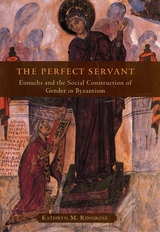 The Perfect Servant: Eunuchs and the Social Construction of Gender in Byzantium
Kathryn M. Ringrose
University of Chicago Press, 2003 The Perfect Servant reevaluates the place of eunuchs in Byzantium. Kathryn Ringrose uses the modern concept of gender as a social construct to identify eunuchs as a distinct gender and to illustrate how gender was defined in the Byzantine world. At the same time she explores the changing role of the eunuch in Byzantium from 600 to 1100.
Accepted for generations as a legitimate and functional part of Byzantine civilization, eunuchs were prominent in both the imperial court and the church. They were distinctive in physical appearance, dress, and manner and were considered uniquely suited for important roles in Byzantine life. Transcending conventional notions of male and female, eunuchs lived outside of normal patterns of procreation and inheritance and were assigned a unique capacity for mediating across social and spiritual boundaries. This allowed them to perform tasks from which prominent men and women were constrained, making them, in essence, perfect servants.
Written with precision and meticulously researched, The Perfect Servant will immediately take its place as a major study on Byzantium and the history of gender.
 The Perfect Square: A History of Rittenhouse Square
Nancy M. Heinzen
Temple University Press, 2009 Great cities and neighborhoods rise and fall, yet Rittenhouse Square in Philadelphia has seized the imagination and envy of social climbers, urban planners, and novelists alike for two centuries. In The Perfect Square, Nancy Heinzen—a resident of Rittenhouse Square for over 40 years and an activist committed to its preservation—provides the first full-length social history of this public urban space.
One of the five squares William Penn established when he founded the city, the southwest-situated Rittenhouse Square has transformed from a marshy plot surrounded by brickyards and workers’ shanties into the epicenter of Philadelphia high society. A keystone of center city Philadelphia, it was once home to great dynasties, elegant mansions, and grand dames of the Victorian era. Today it is lined with million-dollar high-rise condominiums, where nouveau-riche entrepreneurs and descendants of ethnic immigrants live side-by-side.
Heinzen lovingly chronicles this urban space’s development and growth, illustrating that not only is Rittenhouse Square unique, but so is the combination of human events and relationships that have created and sustained it.
Painstakingly researched and generously illustrated with black-and-white photos from public archives, The Perfect Square will appeal to lay readers interested in history, to professional historians and urban planners, and to the thousands of new residents who have settled on or near Rittenhouse Square since the dawn of the 21st century.
A Perfect Vacuum
Stanislaw Lem
Northwestern University Press, 1999 In A Perfect Vacuum, Stanislaw Lem presents a collection of book reviews of nonexistent works of literature--works that, in many cases, could not possibly be written. Embracing postmodernism's "games for games' sake" ethos, Lem joins the contest with hilarious and grotesque results, lampooning the movement's self-indulgence and exploiting its mannerisms.
Beginning with a review of his own book, Lem moves on to tackles (or create pastiches of) the French new novel, James Joyce, pornography, authorless writing, and Dostoevsky, while at the same time ranging across scientific topics, from cosmology to the pervasiveness of computers. The result is a metafictional tour de force by one of the world's most popular writers.
 Perfect Wave: More Essays on Art and Democracy
Dave Hickey
University of Chicago Press, 2017 A collection of essays by American art critic Dave Hickey, nicknamed “The Bad Boy of Art Criticism.”
When Dave Hickey was twelve, he rode the surfer’s dream: the perfect wave. And, like so many things in life we long for, it didn’t quite turn out—he shot the pier and dashed himself against the rocks of Sunset Cliffs in Ocean Beach, which nearly killed him.
Hickey went on to develop a career as one of America’s foremost critical iconoclasts, a trusted no-nonsense voice commenting on the worlds of art and culture. Perfect Wave brings together essays on a wide range of subjects from throughout Hickey’s career, displaying his breadth of interest and powerful insight into what makes art work, or not, and why we care. With Hickey as our guide, we travel to Disneyland and Vegas, London and Venice. We discover the genius of Karen Carpenter and Waylon Jennings, learn why Robert Mitchum matters more than Jimmy Stewart, and see how the stillness of Antonioni speaks to us today. Never slow to judge—or to surprise us in doing so—Hickey relates his wincing disappointment in the later career of his early hero Susan Sontag and shows us the appeal to our commonality that we’ve been missing in Norman Rockwell.
Bookended by previously unpublished personal essays that offer a new glimpse into Hickey’s own life—including the aforementioned conclusion to his surfing career—Perfect Wave is a welcome addition to the Hickey canon.
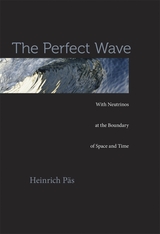 The Perfect Wave: With Neutrinos at the Boundary of Space and Time
Heinrich Päs
Harvard University Press, 2014 Almost weightless and able to pass through the densest materials with ease, neutrinos seem to defy the laws of nature. But these mysterious particles may hold the key to our deepest questions about the universe, says physicist Heinrich Päs. In The Perfect Wave, Päs serves as our fluent, deeply knowledgeable guide to a particle world that tests the boundaries of space, time, and human knowledge.
The existence of the neutrino was first proposed in 1930, but decades passed before one was detected. Päs animates the philosophical and scientific developments that led to and have followed from this seminal discovery, ranging from familiar topics of relativity and quantum mechanics to more speculative theories about dark energy and supersymmetry. Many cutting-edge topics in neutrino research--conjectures about the origin of matter, extra-dimensional spacetime, and the possibility of time travel--remain unproven. But Päs describes the ambitious projects under way that may confirm them, including accelerator experiments at CERN and Fermilab, huge subterranean telescopes designed to detect high-energy neutrino radiation, and the Planck space observatory scheduled to investigate the role of neutrinos in cosmic evolution.
As Päs's history of the neutrino illustrates, what is now established fact often sounded wildly implausible and unnatural when first proposed. The radical side of physics is both an exciting and an essential part of scientific progress, and The Perfect Wave renders it accessible to the interested reader.
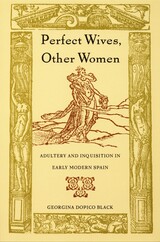 Perfect Wives, Other Women: Adultery and Inquisition in Early Modern Spain
Georgina Dopico Black
Duke University Press, 2001 In Perfect Wives, Other Women Georgina Dopico Black examines the role played by women’s bodies—specifically the bodies of wives—in Spain and Spanish America during the Inquisition. In her quest to show how both the body and soul of the married woman became the site of anxious inquiry, Dopico Black mines a variety of Golden Age texts for instances in which the era’s persistent preoccupation with racial, religious, and cultural otherness was reflected in the depiction of women.
Subject to the scrutiny of a remarkable array of gazes—inquisitors, theologians, religious reformers, confessors, poets, playwrights, and, not least among them, husbands—the bodies of perfect and imperfect wives elicited diverse readings. Dopico Black reveals how imperialism, the Inquisition, inflation, and economic decline each contributed to a correspondence between the meanings of these human bodies and “other” bodies, such as those of the Jew, the Moor, the Lutheran, the degenerate, and whoever else departed from a recognized norm. The body of the wife, in other words, became associated with categories separate from anatomy, reflecting the particular hermeneutics employed during the Inquisition regarding the surveillance of otherness.
Dopico Black’s compelling argument will engage students of Spanish and Spanish American history and literature, gender studies, women’s studies, social psychology and cultural studies.
Perfect Worlds: Utopian Fiction in China and the West
Douwe Fokkema
Amsterdam University Press, 2012
Perfect Worlds is an extensive, comparative study of utopian narratives in both the East and the West. Douwe Fokkema provides an elegant argument about the human impulse to imagine new and better worlds, astutely observing that the utopian imagination thrives in the context of secularization. Fokkema also tracks the rise of dystopian narratives, invoking authors as diverse as Margaret Atwood and Lao She, and provides a cogent evaluation of the role of imagined worlds in both Chinese and Euro-American fiction. A shrewd comparison of cultures, as well as a vivid account of cross-cultural influence, this volume is a welcome addition to the scholarly discourse on utopias.
 Perfection in Bad Axe: Stories
Stories by Craig Bernthal
University of Missouri Press, 2003 You could find out anything at Jim's, and Larry and I liked to be in the know. Information (not gossip) was passed back and forth constantly. Did you hear about the four couples engaged in "wife- swapping" in town? The mechanics and gas pumpers at Jim's could fill you in. Were you interested in the last time the Baptist minister beat his wife? Who your cute French teacher slept with a couple nights ago? Jim's had the answers. The place held another attraction for me: if you were under twenty-one and wanting some liquor for Friday night, Jim's son, Jimmy the Bomb, just out of the Marine Corps, had no problem picking up a bottle or two for you at the liquor store on the east side of town. Set mainly in the Midwest, these tales are inhabited by ordinary, decent people who, often to their surprise, find joy and meaning under difficult circumstances. Many of the stories depict isolated moments of perfection in a world that routinely forces its imperfections on us. A teenager wrestles with guilt over an accident he caused in “Perfection in Bad Axe.” In “A Knight Pursued,” a young prosecuting attorney confronts on the same day his first autopsy and his wife’s unexpected desire to have a baby. A devout, hardworking business owner is drawn into a lawsuit that threatens his marriage and leads him to question his most deeply felt principles. “Center of Gravity” finds a middle-aged law professor overcome by his chaotic life and searching for a degree of peace. These are the finely developed characters of Bernthal’s stories—people we recognize, but who never seem overly familiar. Interesting, substantial, and utterly engrossing, each one could be just like any one of us, an ordinary Jane or Joe, trying to maintain or find order in a life sometimes filled with disorder.
Perfection in Death
Patrick M. Clark
Catholic University of America Press, 2015 Perfection in Death compares and contrasts the relationship between conceptions of courage and death in the thought of Aquinas and his ancient philosophical sources. At the center of this investigation is Aquinas' identification of martyrdom as the paradigmatic act of courage as well as "the greatest proof of the perfection of charity." Such a portrayal of "perfection in death" bears some resemblance to the ancient tradition of "noble death", but departs from it in decisive ways. Clark argues that this departure can only be fully understood in light of an accompanying transformation of the metaphysical and anthropological framework underlying ancient theories of virtue. Perfection in Death aims to provide a new, theological account of this paradigm shift in light of contemporary Thomistic scholarship.
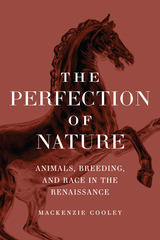 The Perfection of Nature: Animals, Breeding, and Race in the Renaissance
Mackenzie Cooley
University of Chicago Press, 2022 A deep history of how Renaissance Italy and the Spanish empire were shaped by a lingering fascination with breeding.
The Renaissance is celebrated for the belief that individuals could fashion themselves to greatness, but there is a dark undercurrent to this fêted era of history. The same men and women who offered profound advancements in European understanding of the human condition—and laid the foundations of the Scientific Revolution—were also obsessed with controlling that condition and the wider natural world.
Tracing early modern artisanal practice, Mackenzie Cooley shows how the idea of race and theories of inheritance developed through animal breeding in the shadow of the Spanish Empire. While one strand of the Renaissance celebrated a liberal view of human potential, another limited it by biology, reducing man to beast and prince to stud. “Race,” Cooley explains, first referred to animal stock honed through breeding. To those who invented the concept, race was not inflexible, but the fragile result of reproductive work. As the Spanish empire expanded, the concept of race moved from nonhuman to human animals. Cooley reveals how, as the dangerous idea of controlled reproduction was brought to life again and again, a rich, complex, and ever-shifting language of race and breeding was born.
Adding nuance and historical context to discussions of race and human and animal relations, The Perfection of Nature provides a close reading of undertheorized notions of generation and its discontents in the more-than-human world.
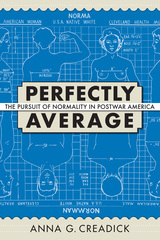 Perfectly Average: The Pursuit of Normality in Postwar America
Anna G. Creadick
University of Massachusetts Press, 2010 At the end of World War II, many Americans longed for a return to a more normal way of life after decades of depression and war. In fact, between 1945 and 1963 the idea of "normality" circulated as a keyword in almost every aspect of American culture. But what did this term really mean? What were its parameters? Whom did it propose to include and exclude?
In Perfectly Average, Anna Creadick investigates how and why "normality" reemerged as a potent homogenizing category in postwar America. Working with scientific studies, material culture, literary texts, film, fashion, and the mass media, she charts the pursuit of the"normal" through thematic chapters on the body, character, class, sexuality, and community.
Creadick examines such evidence as the "Norm and Norma" models produced during the war by sexologists and anthropologists—statistical composites of"normal" American bodies. In 1945, as thousands of Ohio women signed up for a Norma Look-Alike contest, a "Harvard Study of Normal Men" sought to define the typical American male according to specific criteria, from body shape to upbringing to blood pressure. By the early 1950s, the "man in the gray flannel suit" had come to symbolize what some regarded as the stultifying sameness of the "normalized" middle class. Meanwhile, novels such as From Here to Eternity and Peyton Place both supported and challenged normative ideas about gender, race, and sexuality, even as they worked to critique the postwar culture of surveillance—watching and being watched—through which normalizing power functioned.
As efforts to define normality became increasingly personal, the tensions em-bedded in its binary logic multiplied: Was normal descriptive of an average or prescriptive of an ideal? In the end, Creadick shows, a variety of statistics, assumptions, and aspirations converged to recast "normality" not as something innate or inborn, but rather as a quality to be actively pursued—a standard at once highly seductive and impossible to achieve because it required becoming perfectly average.
 A Perfectly Good Guitar: Musicians on Their Favorite Instruments
By Chuck Holley
University of Texas Press, 2017 Ask guitar players about their instruments, and you’re likely to get a story—where the guitar came from, or what makes it unique, or why the player will never part with it. Most guitarists have strong feelings about their primary tool, and some are downright passionate about their axes. Chuck Holley is a professional photographer and writer who loves music and listening to musicians talk about their trade. For several years, he has been photographing guitarists with their prized instruments and collecting their stories. This beautifully illustrated book presents these stories in revelatory photographs and words. The guitarists included in this book range from high-profile performers, including Rosanne Cash, Guy Clark, Laurence Juber, Jorma Kaukonen, JD Souther, Bill Frisell, Dave Alvin, and Kelly Willis, to renowned studio musicians and band members. Holley’s beautifully composed photographs portray them with their favorite guitar, including detail shots of the instrument. Accompanying the photographs are the musicians’ stories about the Gibsons, Fenders, Martins, and others that have become the guitar in their lives, the one that has a special lineage or intangible qualities of sustain, tone, clarity, and comfort that make it irreplaceable. Several musicians talk about how the guitar chose them, while others recount stories of guitars lost or stolen and then serendipitously recovered. Together, these photographs and stories underscore the great pleasure of performing with an instrument that’s become a trusted friend with a personality all its own.
Perfidy and Passion: Reintroducing the Iliad
Mark Buchan
University of Wisconsin Press, 2012 Homer’s Iliad is often considered a poem of blunt truthfulness, his characters’ motivation pleasingly simple. A closer look, however, reveals a complex interplay of characters who engage in an awful lot of lies. Beginning with Achilles, who hatches a secret plot to destroy his own people, Mark Buchan traces motifs of deception and betrayal throughout the poem. Homer’s heroes offer bluster, their passion linked to and explained by their lack of authenticity. Buchan reads Homer’s characters between the lies, showing how the plot is structured individual denial and what cannot be said.
Perforated Indian Crania in Michigan
W. B. Hinsdale and Emerson F. Greenman
University of Michigan Press, 1936 W. B. Hinsdale and Emerson F. Greenman here report on the discovery of perforated crania at sites in southeastern Michigan. Contains 5 black and white photographs of the perforated crania.
Perform, Repeat, Record: Live Art in History
Edited by Amelia Jones and Adrian Heathfield
Intellect Books, 2012 Bringing together contributors from dance, theater, visual studies, and art history, Perform, Repeat, Record addresses the conundrum of how live art is positioned within history. Set apart from other art forms in that it may never be performed in precisely the same way twice, ephemeral artwork exists both at the time of its staging and long after in the memories of its spectators and their testimonies, as well as in material objects, visual media, and text, all of which offer new critical possibilities. Among the artists, theorists, and historians who contributed to this volume are Marina Abramovic, Guillermo Gómez-Peña, Rebecca Schneider, Boris Groys, Jane Blocker, Carolee Schneemann, Tehching Hsieh, Orlan, Tilda Swinton, and Jean-Luc Nancy.
Performance
Diana Taylor
Duke University Press, 2016 "Performance" has multiple and often overlapping meanings that signify a wide variety of social behaviors. In this invitation to reflect on the power of performance, Diana Taylor explores many of its uses and iterations: artistic, economic, sexual, political, and technological performance; the performance of everyday life; and the gendered, sexed, and racialized performance of bodies. This book performs its argument. Images and texts interact to show how performance is at once a creative act, a means to comprehend power, a method of transmitting memory and identity, and a way of understanding the world.
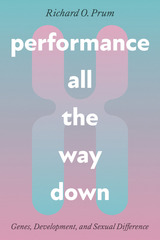 Performance All the Way Down: Genes, Development, and Sexual Difference
Richard O. Prum
University of Chicago Press, 2023 An award-winning biologist and writer applies queer feminist theory to developmental genetics, arguing that individuals are not essentially male or female.
The idea that gender is a performance—a tenet of queer feminist theory since the nineties—has spread from college classrooms to popular culture. This transformative concept has sparked reappraisals of social expectations as well as debate over not just gender, but sex: what it is, what it means, and how we know it. Most scientific and biomedical research over the past seventy years has assumed and reinforced a binary concept of biological sex, though some scientists point out that male and female are just two outcomes in a world rich in sexual diversity.
In Performance All the Way Down, MacArthur Fellow and Pulitzer Prize finalist Richard O. Prum brings feminist thought into conversation with biology, arguing that the sexual binary is not essential to human genes, chromosomes, or embryos. Our genomes are not blueprints, algorithms, or recipes for the physical representation of our individual sexual essences or fates. In accessible language, Prum shows that when we look closely at the science, we see that gene expression is a material action in the world, a performance through which the individual regulates and achieves its own becoming. A fertilized zygote matures into an organism with tissues and organs, neurological control, immune defenses, psychological mechanisms, and gender and sexual behavior through a performative continuum. This complex hierarchy of self-enactment reflects the evolved agency of individual genes, molecules, cells, and tissues.
Rejecting the notion of an intractable divide between the humanities and the sciences, Prum proves that the contributions of queer and feminist theorists can help scientists understand the human body in new ways, yielding key insights into genetics, developmental biology, physiology. Sure to inspire discussion, Performance All the Way Down is a book about biology for feminists, a book about feminist theory for biologists, and a book for anyone curious about how our sexual bodies grow.
Performance and Appropriation: Profane Rituals in Gardens and Landscapes
Michel Conan
Harvard University Press, 2007 Breaking with the idea that gardens are places of indulgence and escapism, these studies of ritualized practices reveal that gardens in Europe, Asia, the United States, and the Caribbean have in fact made significant contributions to cultural change.
This book demonstrates methods and the striking results of garden reception studies. The first section explores how cultural changes occur, and devotes chapters to public landscapes in the Netherlands, seventeenth-century Parisian gardens, Freemason gardens in Tuscany, nineteenth-century Scottish kitchen gardens, and the public parks of Edo and modern Tokyo. The second part provides striking examples of construction of self in vernacular gardens in Guadeloupe and American Japanese-style gardens in California. Finally, the third section analyzes struggles for political change in gardens of Yuan China and modern Britain.
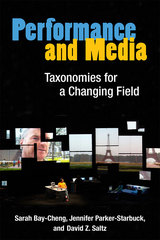 Performance and Media: Taxonomies for a Changing Field
Sarah Bay-Cheng, Jennifer Parker-Starbuck, and David Saltz
University of Michigan Press, 2015 This timely collaboration by three prominent scholars of media-based performance presents a new model for understanding and analyzing theater and performance created and experienced where time-based, live events, and mediated technologies converge–particularly those works conceived and performed explicitly within the context of contemporary digital culture. Performance and Media introduces readers to the complexity of new media-based performances and how best to understand and contextualize the work. Each author presents a different model for how best to approach this work, while inviting readers to develop their own critical frameworks, i.e., taxonomies, to analyze both past and emerging performances. Performance and Media capitalizes on the advantages of digital media and online collaborations, while simultaneously creating a responsive and integrated resource for research, scholarship, and teaching. Unlike other monographs or edited collections, this book presents the concept of multiple taxonomies as a model for criticism in a dynamic and rapidly changing field.
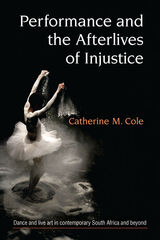 Performance and the Afterlives of Injustice
Catherine M. Cole
University of Michigan Press, 2020 In the aftermath of state-perpetrated injustice, a façade of peace can suddenly give way, and in South Africa and the Democratic Republic of Congo, post-apartheid and postcolonial framings of change have exceeded their limits. Performance and the Afterlives of Injustice reveals how the voices and visions of artists can help us see what otherwise evades perception. Embodied performance in South Africa has particular potency because apartheid was so centrally focused on the body: classifying bodies into racial categories, legislating where certain bodies could move and which bathrooms and drinking fountains certain bodies could use, and how different bodies carried meaning. The book considers key works by contemporary performing artists Brett Bailey, Gregory Maqoma, Mamela Nyamza, Robyn Orlin, Jay Pather, and Sello Pesa, artists imagining new forms and helping audiences see the contemporary moment as it is: an important intervention in a country long predicated on denial. They are also helping to conjure, anticipate, and dream a world that is otherwise. The book will be of particular interest to scholars of African studies, black performance, dance studies, transitional justice, as well as theater and performance studies.
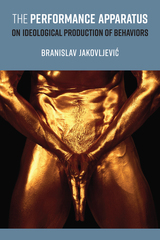 The Performance Apparatus: On Ideological Production of Behaviors
Branislav Jakovljevic
University of Michigan Press, 2025 The publication of Louis Althusser’s 1969 article “Ideology and Ideological State Apparatuses,” made a deep impact on cultural studies and was instrumental in the formation of the apparatus theory in film studies. While contemporaneous with the emergence of performance art, this article and the questions of ideology and apparatus it raises barely registered in the field of performance studies, which was then in its formative phase. Jakovljević takes this absence of Althusser’s apparatus theory from performance studies as an indicator of the ideological position of the field at the moment of its emergence, arguing that, while theories of ideology played no major role in early performance studies, performance art itself offered a number of incisive critiques of ideology. Jakovljević looks at permutations of the apparatus by investigating the work of theorists such as Louis Althusser, Michel Foucault, Gilles Deleuze, and Judith Butler, and engagements with the apparatus by a number of artists, such as Amiri Baraka, Philippe Thomas, New York Art & Language, Terry Fox, Every house has a door, Clive Robertson, and Cassils.
Jakovljević suggests that the centrality of behavior in early performance theory is important for the understanding of contemporary society, which is dominated by surveillance capitalism. If ideology is lodged in behaviors, and if surveillance capitalism thrives on the monetization of the behavioral surplus, then performance theory can make significant contributions to our understanding of the moment in which we live and the future we are facing. The Performance Apparatus argues for the importance of continuing attention to the question of ideology in contemporary, neoliberal order.
Performance Art in Ireland: A History
Edited by Áine Phillips
Intellect Books, 2015 The first book devoted to Irish performance art and the first attempt at a history of this art form in the north and south of Ireland, this book brings together contributions by prominent Irish artists and major academics. It features rigorous critical and theoretical analysis as well as historical commentaries that provide an absorbing sense of the rich histories of performance art in Ireland. Presenting diverse visual documentation of performance art practices, this collection shows how performance art in Ireland engaged with—and in turn influenced and led by—contemporary performance and live art internationally. Copublished with the Live Art Development Agency.
Performance Art: Stories
David Kranes
University of Nevada Press, 2021 Part of our socialization is the urge-to-perform. We perform images of ourselves for others. If we are successful, we are called on to perform. For some, the urge is so great and the talent sufficient, that we become performers. Performance Art us a book about performers and performances which are extreme. Most of these stories and their performers and performances are at the edge of dream.
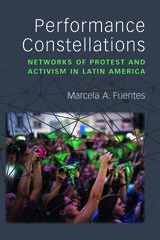 Performance Constellations: Networks of Protest and Activism in Latin America
Marcela A. Fuentes
University of Michigan Press, 2019 Performance Constellations maps transnational protest movements and the dynamics of networked expressive behavior in the streets and online, as people struggle to be heard and effect long-term social justice. Its case studies explore collective political action in Latin America, including the Zapatistas in the mid-’90s, protests during the 2001 Argentine economic crisis, the 2011 Chilean student movement, the 2014–2015 mobilizations for the disappeared Ayotzinapa students, and the 2018 transnational reproductive rights movement. The book analyzes uses of space, time, media communication, and corporeality in protests such as virtual sit-ins, flash mobs, scarfazos, and hashtag campaigns, arguing that these protests not only challenge hegemonic power but are also socially transformative. While other studies have focused either on digital activism or on street protests, Performance Constellations shows that they are in fact integrally entwined. Zooming in on protest movements and art-activism in Mexico, Argentina, and Chile, and putting contemporary insurgent actions in dialogue with their historical precedents, the book demonstrates how, even in moments of extreme duress, social actors in Latin America have taken up public and virtual space to intervene politically and to contest dominant powers.
 Performance Generating Systems in Dance: Dramaturgy, Psychology, and Performativity
Pil Hansen
Intellect Books, 2022 An interdisciplinary analysis of how performance-generating systems attract patterns of movement and why that affects dramaturgical agency, cognitive learning, and relational change.
Performance-generating systems are systematic and task-based dramaturgy that generate performance for or with an audience. In dance, such systems differ in ways that matter from more closed choreographed scores and more open forms of structured improvisation. Dancers performing within these systems draw on predefined and limited sources while working on specific tasks within constraining rules. The generating components of the systems provide boundaries that enable the performance to self-organize into iteratively shifting patterns instead of becoming repetitive or chaotic.
This book identifies the generating components and dynamics of these works and the kinds of dramaturgical agency they enable. It explains how the systems of these creations affect the perception, cognition, and learning of dancers and why that is a central part of how they work. It also examines how the combined dramaturgical and psychological effects of the systems performatively address individual and social conditions of trauma that otherwise tend to remain unchangeable and negatively impact the human capacity to learn, relate, and adapt. The book provides analytical frameworks and practical insights for those who wish to study or apply performance-generating systems in dance within the fields of choreography and dance dramaturgy, dance education, community dance, or dance psychology.
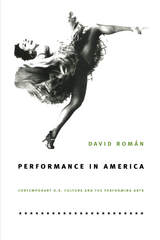 Performance in America: Contemporary U.S. Culture and the Performing Arts
David Román
Duke University Press, 2005 Performance in America demonstrates the vital importance of the performing arts to contemporary U.S. culture. Looking at a series of specific performances mounted between 1994 and 2004, well-known performance studies scholar David Román challenges the belief that theatre, dance, and live music are marginal art forms in the United States. He describes the crucial role that the performing arts play in local, regional, and national communities, emphasizing the power of live performance, particularly its immediacy and capacity to create a dialogue between artists and audiences. Román draws attention to the ways that the performing arts provide unique perspectives on many of the most pressing concerns within American studies: questions about history and politics, citizenship and society, and culture and nation. The performances that Román analyzes range from localized community-based arts events to full-scale Broadway productions and from the controversial works of established artists such as Tony Kushner to those of emerging artists. Román considers dances produced by the choreographers Bill T. Jones and Neil Greenberg in the mid-1990s as new aids treatments became available and the aids crisis was reconfigured; a production of the Asian American playwright Chay Yew’s A Beautiful Country in a high-school auditorium in Los Angeles’s Chinatown; and Latino performer John Leguizamo’s one-man Broadway show Freak. He examines the revival of theatrical legacies by female impersonators and the resurgence of cabaret in New York City. Román also looks at how the performing arts have responded to 9/11, the U.S. invasion of Afghanistan, and the second war in Iraq. Including more than eighty illustrations, Performance in America highlights the dynamic relationships among performance, history, and contemporary culture through which the past is revisited and the future reimagined.
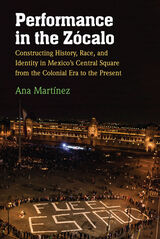 Performance in the Zócalo: Constructing History, Race, and Identity in Mexico's Central Square from the Colonial Era to the Present
Ana Martínez
University of Michigan Press, 2020 For more than five centuries, the Plaza Mayor (or Zócalo) in Mexico City has been the site of performances for a public spectatorship. During the period of colonial rule, performances designed to ensure loyalty to the Spanish monarchy were staged there, but over time, these displays gave way to staged demonstrations of resistance. Today, the Zócalo is a site for both official government-sponsored celebrations and performances that challenge the state. Performance in the Zócalo examines the ways that this city square has achieved symbolic significance over the centuries, and how national, ethnic, and racial identity has been performed there.
A saying in Mexico City is “quien domina el centro, domina el país” (whoever dominates the center, dominates the country) as the Zócalo continues to act as the performative embodiment of Mexican society. This book highlights how particular performances build upon each other by recycling past architectures and performative practices for new purposes. Ana Martínez discusses the singular role of collective memory in creating meaning through space and landmarks, providing a new perspective and further insight into the problem of Mexico’s relationship with its own past. Rather than merely describe the commemorations, she traces the relationship between space and the invention of a Mexican imaginary. She also explores how indigenous communities, Mexico’s alienated subalterns, performed as exploited objects, exotic characters, and subjects with agency. The book’s dual purposes are to examine the Zócalo as Mexico’s central site of performance and to unmask, without homogenizing, the official discourse regarding Mexico’s natives. This book will be of interest for students and scholars in theater studies, Mexican Studies, Cultural Geography, Latinx and Latin American Studies.
Performance, Modelling and Reliability of Photovoltaic Systems
George E. Georghiou
The Institution of Engineering and Technology, 2020 This book provides a comprehensive range of topics for monitoring, modelling and assessing the performance of photovoltaic plants, and enabling effective asset management. Using real-world data, the book emphasises practical usability, systematically covering the knowledge needed to perform these tasks, from the basics all the way through to the evaluation of key performance indicators. Source code used to perform data analysis is also included. This book is ideal for anyone working with photovoltaic systems or plants.
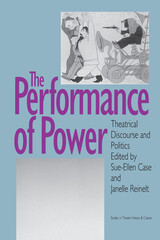 The Performance of Power: Theatrical Discourse and Politics
Sue-Ellen Case
University of Iowa Press, 1991 Recently in the field of theatre studies there has been an increasing amount of debate and dissonance regarding the borders of its territory, its methodologies, subject matter, and scholarly perspectives. The nature of this debate could be termed "political" and, in fact, concerns "the performance of power"—the struggle over power relations embedded in texts, methodologies, and the academy itself. This striking new collection of nineteen divergent essays represents this performance of power and the way in which the recent convergence of new critical theories with historical studies has politicized the study of the theatre. Neither play text, performance, nor scholarship and teaching can safely reside any longer in the "free," politically neutral, self-signifying realm of the aesthetic. Politicizing theatrical discourse means that both the hermeneutics and the histories of theatre reveal the role of ideology and power dynamics. New strategies and concepts—and a vital new phase of awareness—appear in these illuminating essays. A variety of historical periods, from the Renaissance through the Victorian and up to the most contemporary work of the Wooster group, illustrate the ways in which contemporary strategies do not require contemporary texts and performances but can combine with historical methods and subjects to produce new theatrical discourse.
Performance Standards for Restaurants: A New Approach to Addressing the Obesity Epidemic
Deborah Cohen
RAND Corporation, 2013 This report presents the results of a conference of 38 national experts in nutrition and public health who met to develop performance standards that could guide restaurants toward facilitating healthier choices among consumers and that local communities or states could use as a model for developing and implementing either voluntary or mandatory certification programs.
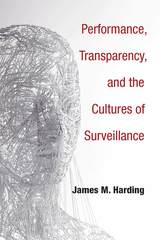 Performance, Transparency, and the Cultures of Surveillance
James M. Harding
University of Michigan Press, 2018 Placing the disciplines of performance studies and surveillance studies in a timely critical dialogue, Performance, Transparency, and the Cultures of Surveillance not only theorizes how surveillance performs but also how the technologies and corresponding cultures of surveillance alter the performance of everyday life. This exploration draws upon a rich array of examples from theatre, performance, and the arts, all of which provide vivid illustration of the book’s central argument: that the rise of the surveillance society coincides with a profound collapse of democratic oversight and transparency—a collapse that, in turn, demands a radical rethinking of how performance practitioners conceptualize art and its political efficacy. The book thus makes the case that artists and critics must reexamine—indeed, must radically redefine—their notions of performance if they are to mount any meaningful counter to the increasingly invasive surveillance society.
 Performance-Based Student Assessment: Challenges and Possibilities
Edited by Joan Boykoff Baron and Dennie Palmer Wolf
University of Chicago Press, 1996 Reforming our nation's educational system has created the need for new ways to assess students' performance. The trend among educators, parents, and politicians to accommodate diversity in the student body demands new systems that accurately gauge the progress of students in relation to their peers while allowing for differences in what students know and how they acquire knowledge. This collection of essays addresses the problems—technical, political, and intellectual—of designing such a system.
The first section discusses the concepts of learning that underpin different approaches to performance assessment. These essays compare notions of fixed intelligence and developmental learning and outline the need to acknowledge and support diversity in America's classrooms. The second section considers the political issues surrounding assessment systems that have been pilot-tested in Connecticut, Vermont, and Kentucky. The third and final section reviews design possibilities for future systems to assess both aptitude and achievement.
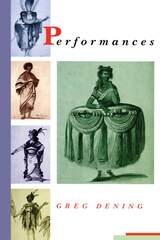 Performances
Greg Dening
University of Chicago Press, 1996 With elegance and candor, Greg Dening offers a panoramic collection of rich and densely textured essays that demonstrate how we can only understand our present through our consciousness of the past and how in thinking about the past we mirror the time and place of our own living.
For Dening, history saturates every moment of our cultural and personal existence. Yet he is keenly aware that the actual past remains fundamentally irreplicable. All histories are culturally crafted artifacts, commensurate with folk tales, stage plays, or films. Whether derived from logbooks and letters, or displayed on music hall stages and Hollywood back lots, history is in essence our making sense of what has and continues to happen, creating for us a sense of our cultural and individual selves.
Through juxtapositions of actual events and creative reenactments of them—such as the mutiny on the Bounty in 1787 and the various Hollywood films that depict that event—Dening calls attention to the provocative moment of theatricality in history making where histories, cultures, and selves converge. Moving adeptly across varied terrains, from the frontiers of North America to the islands of the South Pacific, Dening marshals a striking array of diverse, often recalcitrant, sources to examine the tangled histories of cross-cultural clash and engagement. Refusing to portray conquest, colonization, and hegemony simply as abstract processes, Dening, in his own culturally reflexive performance, painstakingly evokes the flesh and form of past actors, both celebrated and unsung, whose foregone lives have become our history.
 The Performances of Sacred Spaces: Crossing, Breathing, Resisting
Edited by Silvia Battista
Intellect Books, 2021 This collection offers a multi-layered, contemporary analysis of sacred sites and their practices, politics, and ecologies. Presenting practice-as-research accounts alongside theoretical analysis, this multidisciplinary volume brings together religious studies, philosophy, anthropology, and performance studies. By focusing on practice and performance rather than theology, it also expands the notion of sacred places to contexts beyond institutionalized religion.
The questions investigated are: what is a sacred place? Is a place inherently sacred or does it become sacred? Is it a paradigm, a real location, an imaginary place, a projected condition, a charged setting, an enhanced perception? What kind of practices and processes allow the emergence of a sacred place in human perception? And what is its function in contemporary societies?
In exploring these questions and more, Silvia Battista challenges the conventional understanding of sacred places in contemporary contexts and sparks lively new debate on the roles of religiosity and spirituality.
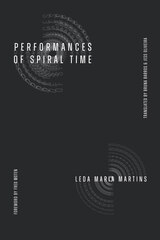 Performances of Spiral Time
Leda Maria Martins. Translated by Bruna Barros and Jess Oliveira
Duke University Press, 2025 In Performances of Spiral Time, famed Afro-Brazilian thinker Leda Maria Martins theorizes forms of African and African diasporic temporality, corporeality, and space that exist apart from and critique Eurocentric notions of linear time. Martins introduces the notion of “spiral time”—curved and recurrent temporalities materialized in Black corporealities in which the body is the place of the inscription of memory and knowledge. She draws on African and African diasporic philosophy as well as the ritual performance and quotidian practices of Afro-Brazilians, arguing that spiral time is most powerfully expressed by the moving body. Embodied performance—whether manifested as capoeira, Candomblé, or theater—and the influence of oral traditions, sacredness, and ancestrality, cause time and memory to curve and return. With this theorization, Martins not only counters the claim to dominance of Western linear time; she provides a polyvalent and foundational account of African and African diasporic thought and ontology.
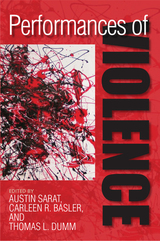 Performances of Violence
Austin Sarat
University of Massachusetts Press, 2011 From acts of terrorism to war, from arson to capital punishment, from sadism to torture, performances of violence are all around us. Sometimes they grab headlines and rivet our attention, sometimes they are barely noticed, constituting part of our taken-for-granted world. Yet whether dramatic or barely noticed, violence seems everywhere to be on the rise. The essays in this volume explore the relationship between selfhood, agency, and violence, focusing on the psychic life of violence and its expression in the performances of particular individuals. At the same time, they look more closely at the way political contexts and ideologies shape both particular performances of violence and the way they are understood. By drawing on the expertise of scholars in a variety of fields—anthropology, history, political theory, law, and social thought—this book seeks to expose some of the subterranean cross currents of the cultural lives of violence and, in so doing, to reveal their connections. In addition to the editors, contributors include criminal justice scholar Mary Welek Atwell, anthropologist Veena Das, historian Ruth Miller, political scientist Anne Norton, political scientist Corey Robin, and historian Paul Steege.
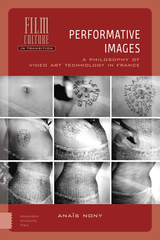 Performative Images: A Philosophy of Video Art Technology in France
Anaïs Nony
Amsterdam University Press, 2023 Performative Images draws upon the work of video artists and activists in France between the 1970s and the early 2020s and focuses on significant practices with technology. Video art and video activism are analysed together in the book to revaluate key concepts in media studies and foreground a performative approach to the theory of image technology. The book engages works in visual culture, performance studies, digital studies, critical race theory, and feminist methodologies to account for the changes brought about by video technology in social and psychic life. Performative Images is about art and activists’ engagement in video technology—an engagement that unsettles the hegemonic narrative of dominant media, as well as the apparently politically neutral dimension of communication technology. In this book, the author explores how video-image technology shapes our psychic and social environments from an art historiographical perspective. We know media technology is dramatically shaping our political and epistemological landscape: this book foregrounds the emergence of performative video images as a key factor in the revaluation of culture and politics.
Performative Materials in Architecture and Design
Edited by Rashida Ng and Sneha Patel
Intellect Books, 2013 Performative Materials in Architecture and Design addresses the convergence of several significant and fundamental advancements in the ways that materials and environments are designed, evaluated, and experienced within architecture and related disciplines. The emergence of experimental and ultra-performing materials, interactive processing systems, and digital design and fabrication techniques has established an interconnected network of technological inputs that has stimulated the development of materials, assemblies, and systems with performative properties. Providing an overview of representative design projects and relevant theories, this volume illuminates both the interaction of these technologies and the role of materiality in research, design, and practice.
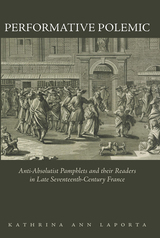 Performative Polemic: Anti-Absolutist Pamphlets and their Readers in Late Seventeenth-Century France
Kathrina Ann LaPorta
University of Delaware Press, 2021 Performative Polemic is the first literary historical study to analyze the “war of words” unleashed in the pamphlets denouncing Louis XIV’s absolute monarchy between 1667 and 1715. As conflict erupted between the French ruler and his political enemies, pamphlet writers across Europe penned scathing assaults on the Sun King’s bellicose impulses and expansionist policies. This book investigates how pamphlet writers challenged the monarchy’s monopoly over the performance of sovereignty by contesting the very mechanisms through which the crown legitimized its authority at home and abroad. Author Kathrina LaPorta offers a new conceptual framework for reading pamphlets as political interventions, asserting that an analysis of the pamphlet’s form is crucial to understanding how pamphleteers seduced readers by capitalizing on existing markets in literature, legal writing, and journalism. Pamphlet writers appeal to the theater-going public that would have been attending plays by Molière and Racine, as well as to readers of historical novels and periodicals. Pamphleteers entertained readers as they attacked the performative circuitry behind the curtain of monarchy.
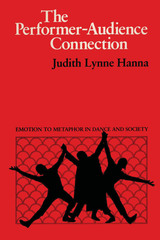 The Performer-Audience Connection: Emotion to Metaphor in Dance and Society
By Judith Lynne Hanna
University of Texas Press, 1983 The Performer-Audience Connection is a pioneering foray into one of the major puzzles of human communication: the communication of emotion in dance. It is the first attempt of its kind systematically to investigate what performers wish to convey and what audiences perceive in the performance of dance. The centerpiece of this provocative book is an examination of performer intentions and audience response at eight dance performances in Washington, D.C. Part of the Smithsonian Institution Division of Performing Arts Dance Series, these concerts featured a variety of dance genres and cultures: American tap dance, Kathakali dance-drama from Kerala, India, Japanese Kabuki, contemporary avant-garde dance, Philippine folk dance, the Indian classical tradition of Kuchipudi, and modern dance to an AfroAmerican spiritual. How did dancer and audience interact at the emotional level on these eight occasions? What affected performer-audience rapport? Through interviews of both spectators and dancers, Judith Lynne Hanna explores the performers' ways of imparting emotion through movement and audience members' expectations and responses. In doing so she casts new light on important issues of cultural identity, sex role, historic attitudes toward dance, and even marketing the arts today. A landmark work not only for performers who wish to reach their audiences more effectively but also for choreographers, anthropologists, specialists in nonverbal communication, behavioral scientists, educators, and all who are fascinated by the arts and the special magic of the "performer-audience connection."
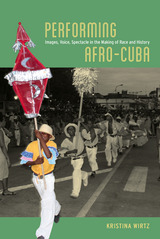 Performing Afro-Cuba: Image, Voice, Spectacle in the Making of Race and History
Kristina Wirtz
University of Chicago Press, 2014 Visitors to Cuba will notice that Afro-Cuban figures and references are everywhere: in popular music and folklore shows, paintings and dolls of Santería saints in airport shops, and even restaurants with plantation themes. In Performing Afro-Cuba, Kristina Wirtz examines how the animation of Cuba’s colonial past and African heritage through such figures and performances not only reflects but also shapes the Cuban experience of Blackness. She also investigates how this process operates at different spatial and temporal scales—from the immediate present to the imagined past, from the barrio to the socialist state.
Wirtz analyzes a variety of performances and the ways they construct Cuban racial and historical imaginations. She offers a sophisticated view of performance as enacting diverse revolutionary ideals, religious notions, and racial identity politics, and she outlines how these concepts play out in the ongoing institutionalization of folklore as an official, even state-sponsored, category. Employing Bakhtin’s concept of “chronotopes”—the semiotic construction of space-time—she examines the roles of voice, temporality, embodiment, imagery, and memory in the racializing process. The result is a deftly balanced study that marries racial studies, performance studies, anthropology, and semiotics to explore the nature of race as a cultural sign, one that is always in process, always shifting.
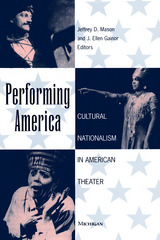 Performing America: Cultural Nationalism in American Theater
Jeffrey D. Mason and J. Ellen Gainor, Editors
University of Michigan Press, 2001 Performing America provides fresh perspectives on the development of visions of both America and "America"--that is, the actual community and the constructed concept--on a variety of theatrical stages. It explores the role of theater in the construction of American identity, highlighting the tension between the desire to categorize American identity and the realization that such categorical uniformity may neither be desirable nor possible.
The topics covered include the links between politics and the stage during the Federalist period, the appropriation of "Indian" artifacts, an exploration of early gender roles, and the metaphorical connections between the theater and western expansion. Other essays treat vaudeville's artistically colonized cultures; Chautauqua's attempt to homogenize culture and commercialize American ideals; W. E. B. Du Bois's pageant, The Star of Ethiopia, as a strategy for constructing "African-American" as "Other" in an attempt to promote a vision of black nationalism; and how theater was used to help immigrants form a new sense of community while joining the resident culture.
The collection then turns to questions of how various ethnic minorities through their recent theatrical work have struggled to argue their identities, especially in relation to the dominant white culture. Two final essays offer critiques of contrasting aspects of the American male.
Throughout, the collection addresses questions of marginality and community, exclusion and inclusion, colonialism and imperialism, heterogeneity and homogeneity, conflict and negotiation, repression and opportunity, failure and success, and, above all, the relationship of American stages at large. It will appeal to readers of a wide range of disciplines including history, American culture, gender studies, and theater studies.
Jeffrey D. Mason is Professor of Theatre, California State University, Bakersfield. J. Ellen Gainor is Associate Professor of Theatre Studies and Women's Studies, Cornell University.
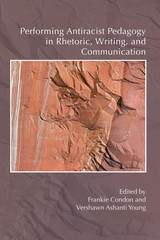 Performing Antiracist Pedagogy in Rhetoric, Writing, and Communication
Frankie Condon
University Press of Colorado, 2017 In Performing Antiracist Pedagogy, Frankie Condon and Vershawn Ashanti Young seek to help create openings to address race and racism not only in course readings and class discussion in writing, rhetoric, and communication courses but also in wider public settings. The contributors to this collection, drawn from a wide range of disciplines, urge readers to renew their commitment to intelligently and publicly deliberate race and to counteract the effects of racism. The book is both theoretically rigorous and practical, providing readers with insightful analyses of race and racism and useful classroom suggestions and examples. Contributors: Chiara Bacigalupa, Sophia Bell, Susan Leigh Brooks, Frankie Condon, Rasha Diab, John Dean, Thomas Ferrell, Beth Godbee, Dae-Joong Kim, Timothy Lensmire, Calvin M. Logue, Aja Y. Martinez, Rebecca Nathan, Bobbi Olson, Jessica Parker, Charise Pimentel, Octavio Pimentel, Mya Poe, Neil Simpkins, Nathan Snaza, Deatra Sullivan, Vershawn Ashanti Young
Performing Arts in Prisons: Creative Perspectives
Edited by Michael Balfour, Brydie-Leigh Bartleet, Linda Davey, John Rynne, and Huib Schippers
Intellect Books, 2019 This book explores prison arts in Australia, USA, UK, and Chile, and creates a new framework for understanding its practices. There is a growing body of evidence that suggests music, theatre, poetry, and dance can contribute to prisoner wellbeing, management, rehabilitation, and reintegration. Performing Arts in Prison represents a range of distinct perspectives on the subject, from an inspector of prisons to the voice of the prisoner. The book includes a spectrum of arts approaches and models of practice alongside theory, critical commentary, and accounts of personal experience to present a full analysis of the value and effects of creative arts in prison.
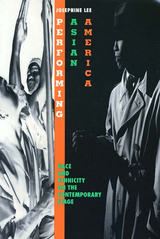 Performing Asian America: Race and Ethnicity on the Contemporary Stage
Josephine Lee
Temple University Press, 1998 At a time when Asian American theater is enjoying a measure of growth and success, Josephine Lee tells us about the complex social and political issues depicted by Asian American playwrights. By looking at performances and dramatic texts, Lee argues that playwrights produce a different conception of "Asian America" in accordance with their unique set of sensibilities.
For instance, some Asian American playwrights critique the separation of issues of race and ethnicity from those of economics and class, or they see ethnic identity as a voluntary choice of lifestyle rather than an impetus for concerted political action. Others deal with the problem of cultural stereotypes and how to reappropriate their power. Lee is attuned to the complexities and contradictions of such performances, and her trenchant thinking about the criticisms lobbed at Asian American playwrights -- for their choices in form, perpetuation of stereotype, or apparent sexism or homophobia -- leads her to question how the presentation of Asian American identity in the theater parallels problems and possibilities of identity offstage as well.
Discussed are better-known plays such as Frank Chin's The Chickencoop Chinaman, David Henry Hwang's M. Butterfly, and Velina Hasu Houston's Tea, and new works like Jeannie Barroga's Walls and Wakako Yamauchi's 12-1-a.
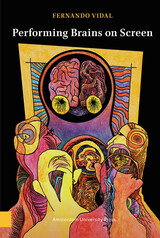 Performing Brains on Screen
Fernando Vidal
Amsterdam University Press, 2022 Performing Brains on Screen deals with film enactments and representations of the belief that human beings are essentially their brains, a belief that embodies one of the most influential modern ways of understanding the human. Films have performed brains in two chief ways: by turning physical brains into protagonists, as in the "brain movies" of the 1950s, which show terrestrial or extra-terrestrial disembodied brains carrying out their evil intentions; or by giving brains that remain unseen inside someone’s head an explicitly major role, as in brain transplantation films or their successors since the 1980s, in which brain contents are transferred and manipulated by means of information technology. Through an analysis of filmic genres and particular movies, Performing Brains on Screen documents this neglected filmic universe, and demonstrates how the cinema has functioned as a cultural space where a core notion of the contemporary world has been rehearsed and problematized.
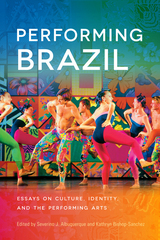 Performing Brazil: Essays on Culture, Identity, and the Performing Arts
Edited by Severino J. Albuquerque and Kathryn Bishop-Sanchez
University of Wisconsin Press, 2015 A field-shaping anthology by top cultural critics and practitioners representing a wide range of disciplines and art forms, Performing Brazil is the first book to bring together studies of the many and varied manifestations of Brazilian performance in and beyond their country of origin. Arguing that diverse forms of performance are best understood when presented in tandem, it offers new takes on better-known forms, such as carnival and capoeira, as well as those studied less often, including gender acts, curatorial practice, political protest, and the performance of Brazil in the United States.
The contributors to the volume are Maria José Somerlate Barbosa, Eric A. Galm, Annie McNeill Gibson, Ana Paula Höfling, Benjamin Legg, Bryan McCann, Simone Osthoff, Fernando de Sousa Rocha, Cristina F. Rosa, Alessandra Santos, and Lidia Santos.
 Performing Captivity, Performing Escape: Cabarets and Plays from the Terezín/Theresienstadt Ghetto
Edited by Lisa Peschel
Seagull Books, 2014 A meticulously researched book that collects twelve playscripts written by European Jews imprisoned in the Terezín ghetto during the Holocaust.
The concentration camp and Jewish ghetto at Terezín, or Theresienstadt, in what is now the Czech Republic, was a site of enormous suffering, fear, and death. But amid this horrific period, there was also a thriving and desperately vibrant cultural life. While the children’s drawings and musical pieces created in the ghetto have become justly famous, the prisoners’ theatrical works, though a lesser-known aspect of their artistic endeavors, deserves serious attention as well.
Performing Captivity, Performing Escape collects twelve theatrical texts—cabaret songs and sketches, historical and verse dramas, puppet plays, and a Purim play—written by Czech and Austrian Jews. Together these works reveal the wide range of ways in which the prisoners engaged with and escaped from life in the ghetto through performance. The anthology opens with an insightful prologue by novelist Ivan Klíma, who was interned in the ghetto as a child and contains a detailed introduction by editor Lisa Peschel about the pre-war theatrical influences and wartime conditions that inspired the theater of the ghetto. The array of theatrical forms collected in this anthology speaks of the prisoners’ persistence of hope in a harrowing time and will be a moving read for students and scholars of the Holocaust.
 Performing Chance: The Art of Alison Knowles In/Out of Fluxus
Nicole L. Woods
University of Chicago Press, 2026 The first monographic study of American artist Alison Knowles, a significant yet overlooked cofounder of the Fluxus movement.
Alison Knowles stands out as the sole female artist among the founders of Fluxus, yet she has remained an enigmatic, underrecognized figure in the history of art. Performing Chance fills a gap in the record, bringing to light Knowles’s transformative body of work as it evolved from abstract painting in the late 1950s, to silkscreens, print media, and performance in the early 1960s, to groundbreaking works in digital poetry, acoustical art, and large-scale installations in the late 1960s-70s.
Through her access to previously unpublished archival materials and direct interviews with the artist, Nicole L. Woods provides close readings of pivotal works, disclosing the ways Knowles instituted formal tactics that moved beyond modernist painting, championed principles of indeterminacy and chance, and fostered sociopolitical consciousness. Situating Knowles’s innovations in various media within the distinct cultural contexts of Wiesbaden, London, Paris, New York City, and Los Angeles, Performing Chance brings this key artist back to her rightful place as a leader of the postwar avant-garde and provides a nuanced history of the role of women artists in Fluxus and beyond.
 Performing Citizenship in Postdictatorship Chile: Cultural Policy and the Making of Political Dramaturgies
Jennifer Joan Thompson
Northwestern University Press, 2025 Offering a nuanced understanding of the performing arts’ relationship to politics Through careful readings of key political performances in Chile's transition from military dictatorship to neoliberal democracy, Jennifer Joan Thompson examines how the production and aesthetics of theater are intertwined in processes of democratization, enactments of citizenship, and the development of cultural policy. Performing Citizenship in Postdictatorship Chile: Cultural Policy and the Making of Political Dramaturgies reveals how artists performed changing models of democratic citizenship. Thompson traces the ways artists confronted and resisted the military dictatorship of Augusto Pinochet, how they then reimagined the body politic during the early transitional period and challenged official constructions of history and memory as the transition to democracy progressed, how they critiqued Chile’s neoliberal economic model and its violence, and, finally, how they have made claims for feminist and Indigenous citizen subjectivities throughout Chile’s current social crisis. Incorporating archival and ethnographic research alongside readings of theatrical and political performances, this study offers a nuanced understanding of the performing arts’ relationship to politics, one that accounts for the ways artists and the state collaborate in the production of the political imagination.
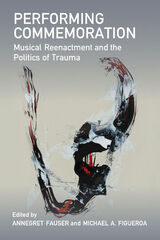 Performing Commemoration: Musical Reenactment and the Politics of Trauma
Annegret Fauser and Michael A. Figueroa, editors
University of Michigan Press, 2020 Public commemorations of various kinds are an important part of how groups large and small acknowledge and process injustices and tragic events. Performing Commemoration: Musical Reenactment and the Politics of Trauma looks at the roles music can play in public commemorations of traumatic events that range from the Armenian genocide and World War I to contemporary violence in the Democratic Republic of the Congo and the #sayhername protests. Whose version of a traumatic historical event gets told is always a complicated question, and music adds further layers to this complexity, particularly music without words. The three sections of this collection look at different facets of musical commemorations and reenactments, focusing on how music can mediate, but also intensify responses to social injustice; how reenactments and their use of music are shifting (and not always toward greater social effectiveness); and how claims for musical authenticity are politicized in various ways. By engaging with critical theory around memory studies and performance studies, the contributors to this volume explore social justice, in, and through music.
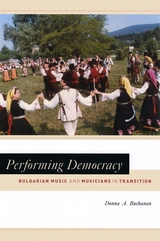 Performing Democracy: Bulgarian Music and Musicians in Transition
Donna A. Buchanan
University of Chicago Press, 2005 The fall of the Berlin Wall in 1989 signaled the onset of tumultuous political, economic, and social reforms throughout Eastern Europe. In Czechoslovakia, Poland, and the Soviet Union these changes were linked to the activities and philosophies of political figures such as Václav Havel, Lech Walesa, and Mikhail Gorbachev. In Bulgaria, however, these changes were first heralded and even facilitated by particular musicians and shifting musical styles.
Based on fieldwork conducted between 1988 and 1996 with professional Bulgarian folk musicians, Donna A. Buchanan's PerformingDemocracy argues that the performances of traditional music groups may be interpreted not only as harbingers but as agents of Bulgaria's political transition. Many of the musicians in socialist Bulgaria's state folk ensembles served as official cultural emissaries for several decades. Through their reminiscences and repertoires, Buchanan reveals the evolution of Bulgarian musical life as it responded to and informed the political process. By modifying their art to accommodate changing political ideologies, these musicians literally played out regime change on the world's stages, performing their country's democratization musically at home and abroad.
Performing Democracy and its accompanying CD-ROM, featuring traditional Bulgarian music, lyrics, notation, and photos, will fascinate any reader interested in the many ways art echoes and influences politics.
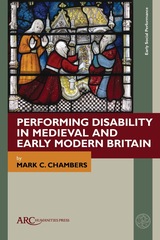 Performing Disability in Medieval and Early Modern Britain
Mark C. Chambers
Arc Humanities Press, 2024 Performing Disability is a landmark examination of performance history in the medieval and early modern era. Seeking to provide a fact-based assessment of disabled performance, this survey examines the nature and socialization of disabled performers in the medieval and early Tudor periods. Using Records of Early English Drama, literary representations, and targeted histories of disability in the medieval period, this study takes a new and welcome look at the evidence for, and the conceptualization of, “impairment” as a performative act in the premodern era.
It features discussions on the different societal constructions pertaining to “disability” (mental incapacity, blindness and deafness, dwarfism, gigantism, etc.), and how the evidence for such conditions was socialized through performance.
Taking an evidence-based and multidisciplinary approach to perceptions of identity and “othering” in premodern society, this study is certain to appeal to a wide audience, including historians of theatre and performance, disability advocates and theorists, and social historians.
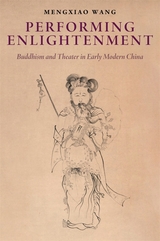 Performing Enlightenment: Buddhism and Theater in Early Modern China
Mengxiao Wang
Harvard University Press In early modern China, a major revival of Buddhism coincided with a surging fascination with theater. Buddhist monastics and laypeople increasingly participated in viewing, discussing, and writing plays. Far from merely serving as a medium for conveying religious teachings and practices, drama became a source of deep concern for Buddhists due to the perceived tension between spiritual discipline and worldly entertainment.
In Performing Enlightenment, Mengxiao Wang examines how Buddhist clerics and laypeople engaged with and drove innovations in theater during the late Ming and early Qing dynasties in the sixteenth and seventeenth centuries. Drawing on an extensive range of sources—including clerical sermons, scriptural commentaries, temple gazetteers, morality books, literati prose, and dramatic texts and paratexts—Wang argues that Ming-Qing Buddhists resolved the conflict between religion and entertainment by transforming theater into a creative mode of devotional practice. Consequently, playwriting, stage performance, and theatergoing all emerged as legitimate pathways to spiritual enlightenment. This interdisciplinary work provides fresh insights into Chinese studies, Buddhist studies, and theater studies while offering a comparative perspective on the complex interplay between religion, literature, and performance across cultures.
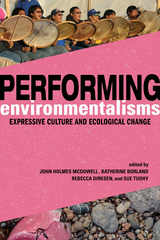 Performing Environmentalisms: Expressive Culture and Ecological Change
Edited by John Holmes McDowell, Katherine Borland, Rebecca Dirksen, and Sue Tuohy
University of Illinois Press, 2021 Performing Environmentalisms examines the existential challenge of the twenty-first century: improving the prospects for maintaining life on our planet. The contributors focus on the strategic use of traditional artistic expression--storytelling and songs, crafted objects, and ceremonies and rituals--performed during the social turmoil provoked by environmental degradation and ecological collapse. Highlighting alternative visions of what it means to be human, the authors place performance at the center of people's responses to the crises. Such expression reinforces the agency of human beings as they work, independently and together, to address ecological dilemmas. The essays add these people's critical perspectives--gained through intimate struggle with life-altering force--to the global dialogue surrounding humanity's response to climate change, threats to biocultural diversity, and environmental catastrophe. Interdisciplinary in approach and wide-ranging in scope, Performing Environmentalisms is an engaging look at the merger of cultural expression and environmental action on the front lines of today's global emergency. Contributors: Aaron S. Allen, Eduardo S. Brondizio, Assefa Tefera Dibaba, Rebecca Dirksen, Mary Hufford, John Holmes McDowell, Mark Pedelty, Jennifer C. Post, Chie Sakakibara, Jeff Todd Titon, Rory Turner, Lois Wilcken
 Performing Exile: Foreign Bodies
Edited by Judith Rudakoff
Intellect Books, 2017 Bringing together a range of perspectives to examine the full impact of political, socio-economic, or psychological experiences of exile, Performing Exile presents an inclusive mix of voices from varied cultural and geographic affiliations. The collected essays in this book focus on live performances that were inspired by living in exile. Chapters blend close critical analysis and ethnography to document and interrogate performances and the contexts that inform them. In a world where exiled populations continue to grow, the role of art to document and engage with these experiences will continue to be essential, and this diverse book offers an important model for understanding the rich body of work being created today. A PDF version of this book is available for free in open access via the OAPEN Library platform, www.oapen.org It has been made available under a Creative Commons Attribution 4.0 International Public License and is part of Knowledge Unlatched.
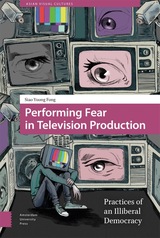 Performing Fear in Television Production: Practices of an Illiberal Democracy
Siao Yuong Fong
Amsterdam University Press, 2022 What goes into the ideological sustenance of an illiberal capitalist democracy? While much of the critical discussion of the media in authoritarian contexts focus on state power, the emphasis on strong states tend to perpetuate misnomers about the media as mere tools of the state and sustain myths about their absolute power.
Turning to the lived everyday of media producers in Singapore, I pose a series of questions that explore what it takes to perpetuate authoritarian resilience in the mass media. How, in what terms and through what means, does a politically stable illiberal Asian state like Singapore formulate its dominant imaginary of social order? What are the television production practices that perform and instantiate the social imaginary, and who are the audiences that are conjured and performed in the process? What are the roles played by imagined audiences in sustaining authoritarian resilience in the media? If, as I will argue in the book, audiences function as the central problematic that engenders anxieties and self-policing amongst producers, can the audience become a surrogate for the authoritarian state?
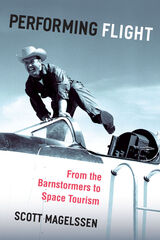 Performing Flight: From the Barnstormers to Space Tourism
Scott Magelssen
University of Michigan Press, 2020 Performing Flight sheds new light on moments in the history of US aviation and spaceflight through the lens of performance studies. From pioneering aviator Bessie Coleman to the emerging industry of space tourism, performance has consistently shaped public perception of the enterprise of flight and has guaranteed its success as a mode of entertainment, travel, research, and warfare. The book reveals fundamental connections between performance and human aviation and space travel over the past 100 years, beginning with the early aerial entertainers known as barnstormers (named after itinerant 19th century theater troupes) to the performative history of the Enola Gay and its pilot Paul Tibbets, who dropped the bomb on Hiroshima, thus ushering in the atomic age. The book also explores the phenomenon of “the pilot voice”; the creation of the American Astronaut, on whose performative success the Cold War, the Space Race, and funding of the US Space Program all depended; and the performative strategies employed to cement notions of space tourism as both manifest destiny and an escape route from a failed planet. A final chapter addresses the four hijacked flights of 9/11 and their representations in discourse and in memorials. Performing Flight effectively and imaginatively demonstrates the ways in which performance and flight in the United States have been inextricably linked for more than a century.
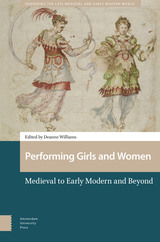 Performing Girls and Women: Medieval to Early Modern and Beyond
Deanne Williams
Amsterdam University Press, 2025 This book charts the broad cultural impact of the medieval and early modern female performer: how she engages with her historical origins in classical drama, works within contemporary cultural and professional networks, and sets the terms for female performance in subsequent historical periods. Moving beyond the archival evidence that establishes that medieval and early modern women and girls performed, it explores how their performances resonated across national boundaries and historical periods, revealing wide patterns of influence and inspiration. This collection of original essays brings together well-established authorities with new and emerging scholars, offering innovative and ground-breaking discussions of medieval dramatic cultures, the Shakespearean stage, professional actresses in Spain and Italy, the performance of music and dance, artistic representations of the female performer, and twentieth- and twenty-first-century adaptations. Ranging from tenth-century Germany to twenty-first-century London, the chapters in this volume offer a new set of paradigms for understanding and interpreting women and girls on stage.
 Performing Glam Rock: Gender and Theatricality in Popular Music
Philip Auslander
University of Michigan Press, 2006 When it first appeared in the early 1970s, glam rock not only caused a stir among audiences and performers, it also stood counterculture and psychedelic rock on their heads. Glam rock was outrageous and overtly theatrical, and its unforgettable characters-adorned with flamboyant costumes and heavy makeup and accompanied by elaborately constructed sets-were personified by performers such as Marc Bolan, David Bowie, Bryan Ferry, and Suzi Quatro. A sea change in rock performance had occurred.
Yet glam was as much about substance as style, and Performing Glam Rock delves into the many ways glam paved the way for new explorations of identity in terms of gender, sexuality, and performance. Philip Auslander positions glam historically and examines it as a set of performance strategies, exploring the ways in which glam rock-while celebrating the showmanship of 1950s rock and roll-began to undermine rock's adherence to the ideology of authenticity in the late 1960s.
In this important study of a too-often-overlooked phenomenon, Auslander takes a fresh look at the genius of the glam movement and introduces glam to a new generation of performance enthusiasts and scholars alike.
Philip Auslander is Professor in the School of Literature, Communication, and Culture at the Georgia Institute of Technology and author of numerous books, including Liveness: Performance in a Mediatized Culture and Presence and Resistance: Postmodernism and Cultural Politics in Contemporary American Performance. He is editor of the major reference work Performance: Critical Concepts and coeditor, with Carrie Sandahl, of Bodies in Commotion: Disability and Performance.
Performing History: Theatrical Representations of the Past in Conetmporary Theatre
Freddie Rokem
University of Iowa Press, 2000 In his examination of the ways in which theatre participates in the ongoing representations of and debates about the past, Freddie Rokem concentrates on the ways in which theatre after World War II has presented different aspects of the French Revolution and the Holocaust, showing us that by “performing history” actors bring the historical past and the theatrical present together.
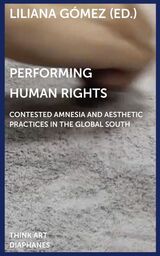 Performing Human Rights: Contested Amnesia and Aesthetic Practices in the Global South
Edited by Liliana Gómez
Diaphanes, 2021 The invisibilization of political violence, its material traces, and spatial manifestations, characterizes conflict and post-conflict situations. Yet, artists, writers, and human rights activists increasingly seek to challenge this invisibility, contesting the related historical amnesia through counter-semantics and dissonant narratives. Adopting “performance” as a concept that is defined by repetitive, aesthetic practices—such as speech and bodily habits through which both individual and collective identities are constructed and perceived—this collection addresses various forms of performing human rights in transitional situations in Spain, Latin America, and the Middle East. Bringing scholars together with artists, writers, and curators, and working across a range of disciplines, Performing Human Rights addresses these instances of omission and neglect, revealing how alternate institutional spaces and strategies of cultural production have intervened in the processes of historical justice and collective memory.
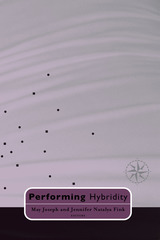 Performing Hybridity
May Joseph
University of Minnesota Press, 1999 A kaleidoscopic consideration of transnational culture and performance Amid the modern-day complexities of migration and exile, immigration and repatriation, notions of stable national identity give way to ideas about cultural “hybridity.” The authors represented in this volume use different forms of performative writing to question this process, to ask how the production of new political identities destabilizes ideas about gender, sexuality, and the nation in the public sphere. Contributors use forms such as the essay, poem, photography, and case study to examine historically specific cases in which the notion of hybridity recasts our ideas of identity and performance: the struggle for Aboriginal land rights in Australia; Bahian carnival; the creolization and pidginization of language in the Caribbean world; queer videos; and others. Contributors: Meena Alexander, CUNY; Awam Amkpa, Mount Holyoke; Tony Birch; Barbara Browning, New York U; Manthia Diawara, New York U; Fiona Foley; Sikivu Hutchinson; Deborah A. Kapchan, U of Texas; Toby Miller, New York U; Shani Mootoo; Fred Moten, U of California, Santa Barbara; José Esteban Muñoz, New York U; Chon A. Noriega, UCLA; Celeste Olalquiaga; Ella Shohat, CUNY; Robert Stam, New York U.
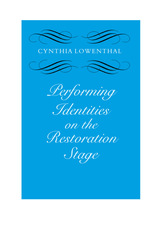 Performing Identities on the Restoration Stage
Cynthia Lowenthal
Southern Illinois University Press, 2002 In Performing Identities on the Restoration Stage, Cynthia Lowenthal explores identity—especially masculinity and femininity, English and “foreign,” middle-class and aristocratic—as it is enacted, idealized, deployed, and redefined on the late-seventeenth-century British stage. Particular emphasis is placed on the ways the theatre contributed to new and often shifting early modern definitions of the boundaries of nation, status, and gender. The first portion of the book focuses on the playwrights’ presentations of idealized men and the comic ridicule of male bodies and behaviors that fall short of the ideal. Of special interest are those moments when playwrights use stereotypes of national character, particularly the Spaniards and Turks, as examples of the worst in male behavior, judgments that are always inflected with elements of class or status inconsistency. The second portion of Lowenthal’s discussion focuses on playwrights’ attempts to redefine the idealized woman. Lowenthal investigates the ways that an extratheatrical discourse surrounding the actresses, one that essentialized them as sexual bodies demanding scrutiny and requiring containment, also serves to secure for them an equally essential aristocratic status. Anchored by Manley’s Royal Mischief, Lowenthal’s reading reveals that even a woman playwright’s attempts to represent female subjectivity or interiority at odds with the surfaces of the body are doomed to return to those same surfaces. By focusing on a new, early modern lability of identity and by reading less canonical women playwrights, such as Manley and Pix, alongside established male playwrights such as Dryden and Wycherley, Performing Identities on the Restoration Stage yields both a more accurate and a more compelling picture of the cultural dynamics at work on the early modern stage.
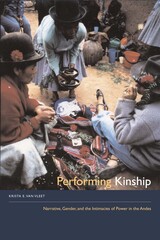 Performing Kinship: Narrative, Gender, and the Intimacies of Power in the Andes
By Krista E. Van Vleet
University of Texas Press, 2008 In the highland region of Sullk'ata, located in the rural Bolivian Andes, habitual activities such as sharing food, work, and stories create a sense of relatedness among people. Through these day-to-day interactions—as well as more unusual events—individuals negotiate the affective bonds and hierarchies of their relationships. In Performing Kinship, Krista E. Van Vleet reveals the ways in which relatedness is evoked, performed, and recast among the women of Sullk'ata. Portraying relationships of camaraderie and conflict, Van Vleet argues that narrative illuminates power relationships, which structure differences among women as well as between women and men. She also contends that in the Andes gender cannot be understood without attention to kinship. Stories such as that of the young woman who migrates to the city to do domestic work and later returns to the highlands voicing a deep ambivalence about the traditional authority of her in-laws provide enlightening examples of the ways in which storytelling enables residents of Sullk'ata to make sense of events and link themselves to one another in a variety of relationships. A vibrant ethnography, Performing Kinship offers a rare glimpse into an compelling world.
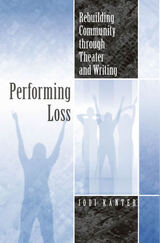 Performing Loss: Rebuilding Community through Theater and Writing
Jodi Kanter
Southern Illinois University Press, 2007 In Performing Loss: Rebuilding Community through Theater and Writing, author Jodi Kanter explores opportunities for creativity and growth within our collective responses to grief. Performing Loss provides teachers, students, and others interested in performance with strategies for reading, writing, and performing loss as communities—in the classroom, the theater, and the wider public sphere. From an adaptation of Jose Saramago’s novel Blindness to a reading of Suzan-Lori Parks’s The America Play, from Kanter’s own experience creating theater with terminally ill patients and federal prisoners to a visual artist’s response to September 11th, Kanter shows in practical, replicable detail how performing loss with community members can transform experiences of isolation and paralysis into experiences of solidarity and action. Drawing on academic work in performance, cultural studies, literature, sociology, and anthropology, Kanter considers a range of responses to grief in historical context and goes on to imagine newer, more collaborative, and more civically engaged responses. Performing Loss describes Kanter’s pedagogical and artistic processes in lively and vivid detail, enabling the reader to use her projects as models or to adapt the techniques to new communities, venues, and purposes. Kanter demonstrates through each example the ways in which writing and performing can create new possibilities for mourning and living together.
Performing Maternities: Political, Social and Feminist Enquiry
Edited by Kate Aughterson and Jess Moriarty
Intellect Books, 2024 Research and practice that challenges dominant narratives around motherhood.
Performing Maternities is a collection of essays, creative work, images, and scripts that emerged out of an online international symposium held at Brighton University in November 2020. Together, the contributors challenge, celebrate, and share the normative, the queer, the transgressive, the joy, and the pain of performing maternity. The book asks key questions about the construction of maternal identities and mythologies in the contemporary world; the ways these affect individuals in different social, economic, and sexual identities; and how—as mothers, writers, artists, parents, and grandparents—we can address and challenge those identities.
|
|
